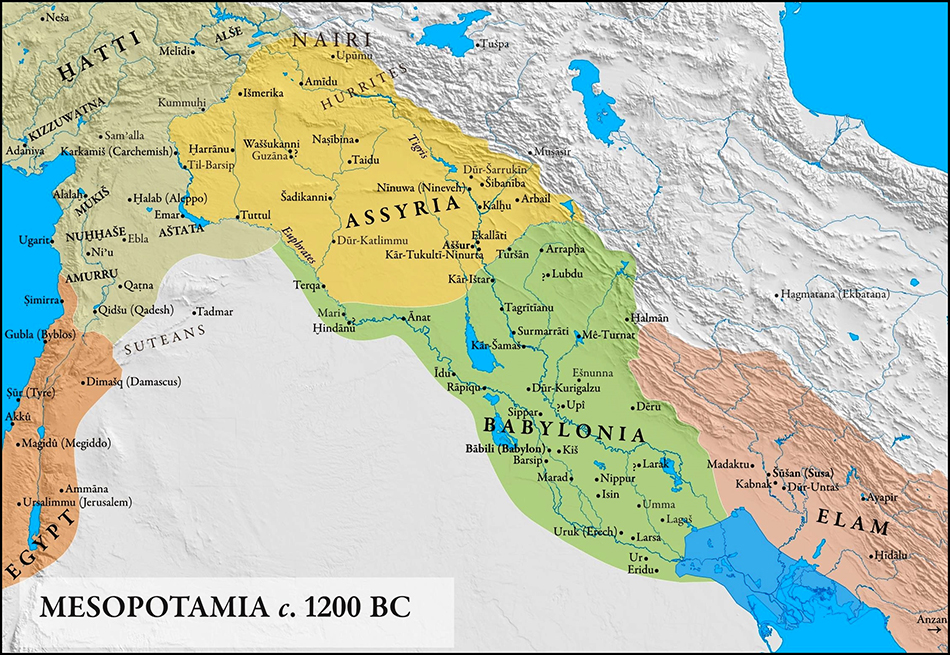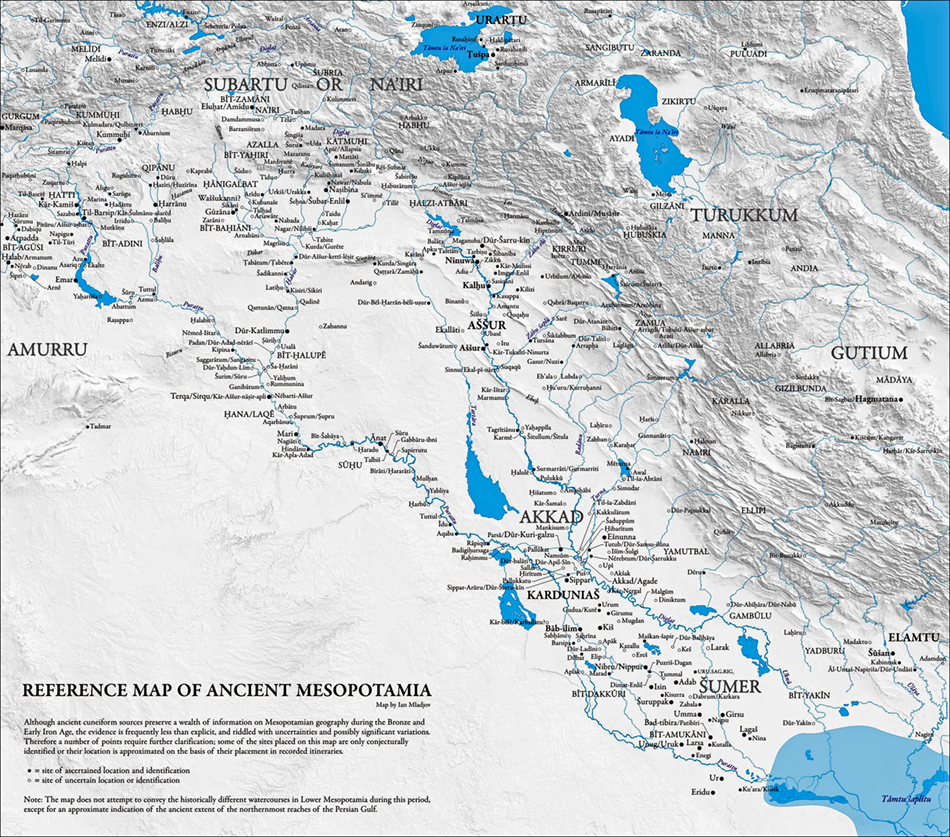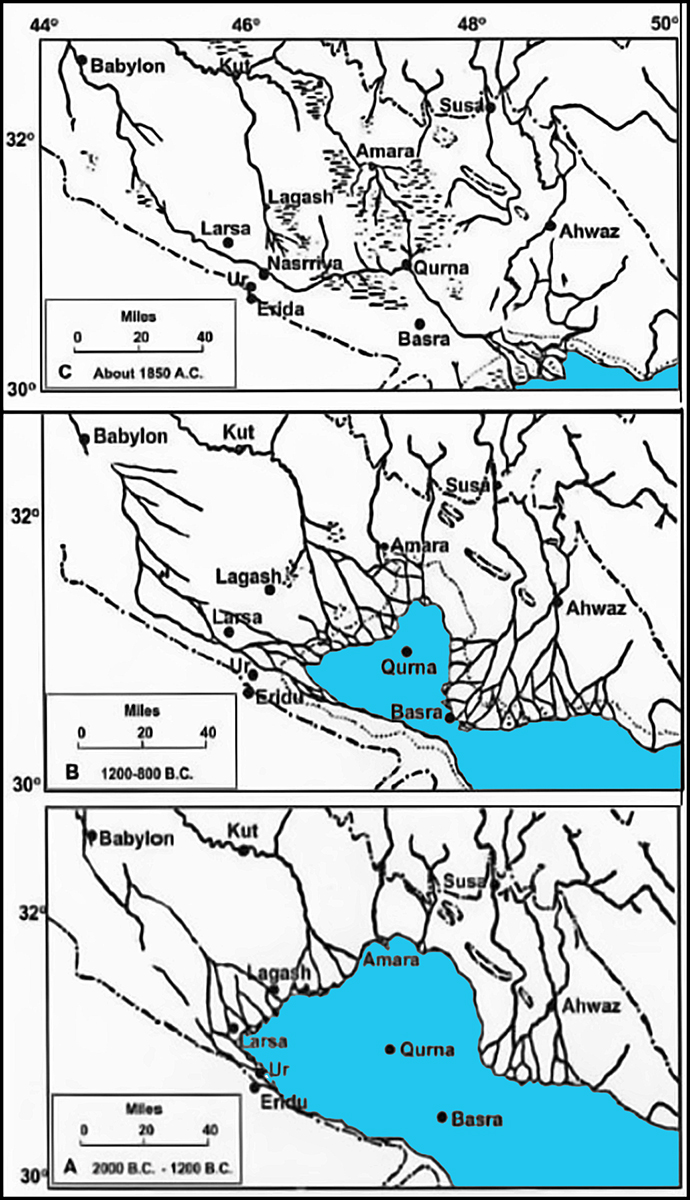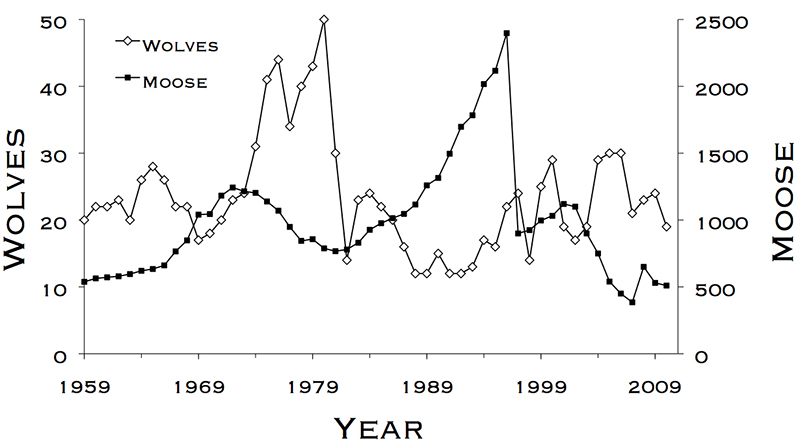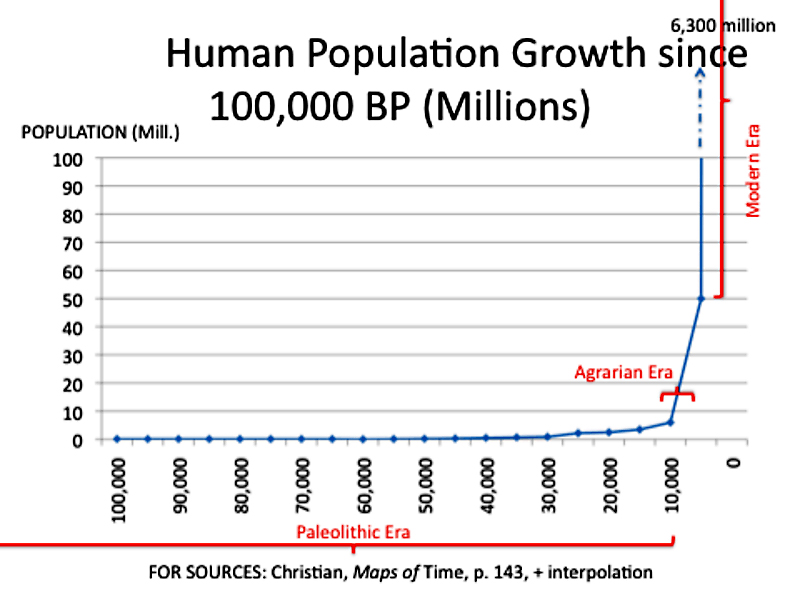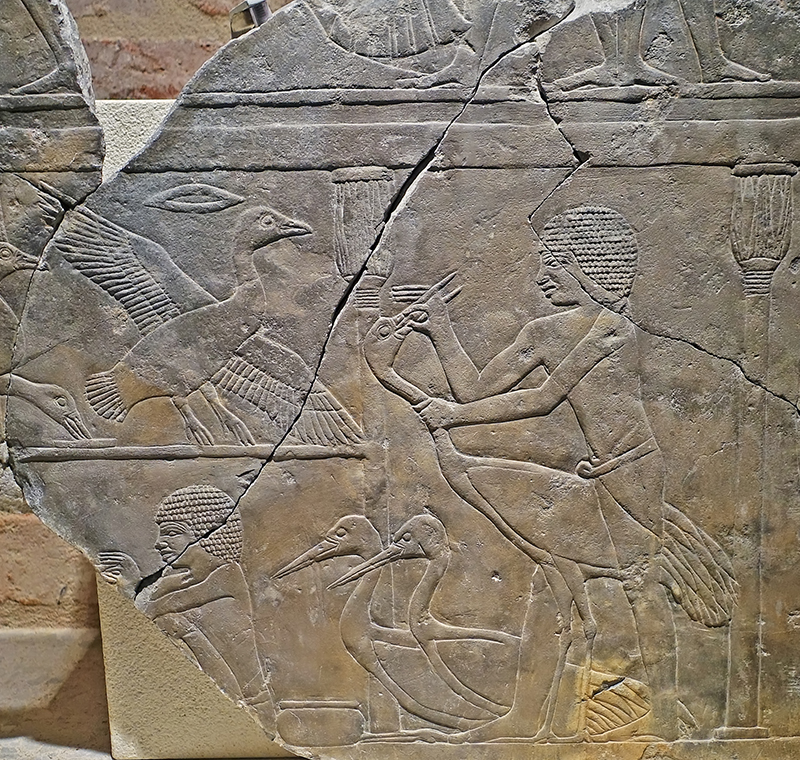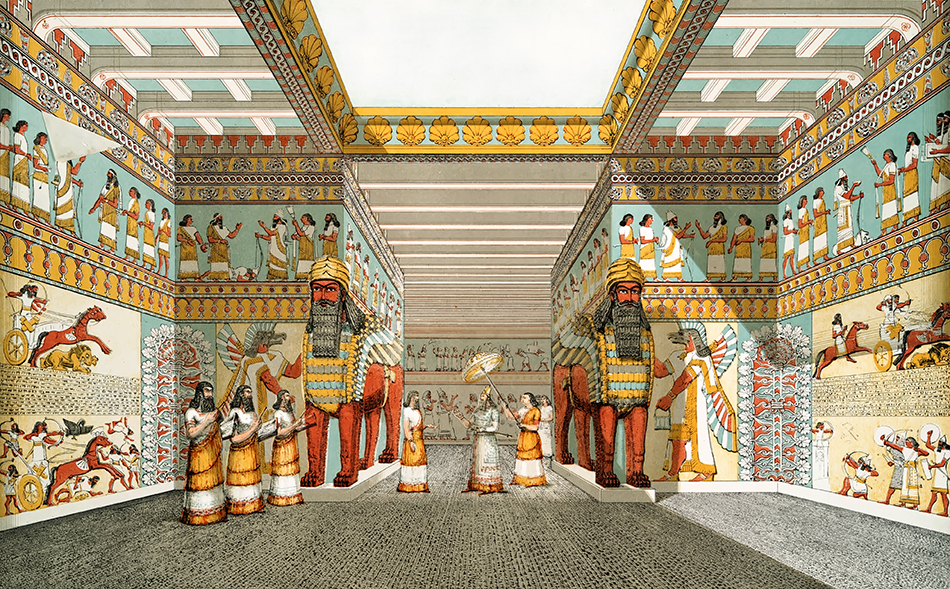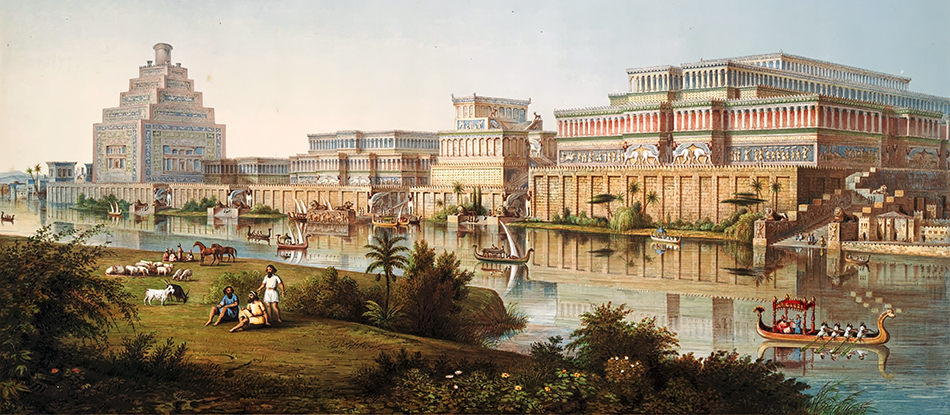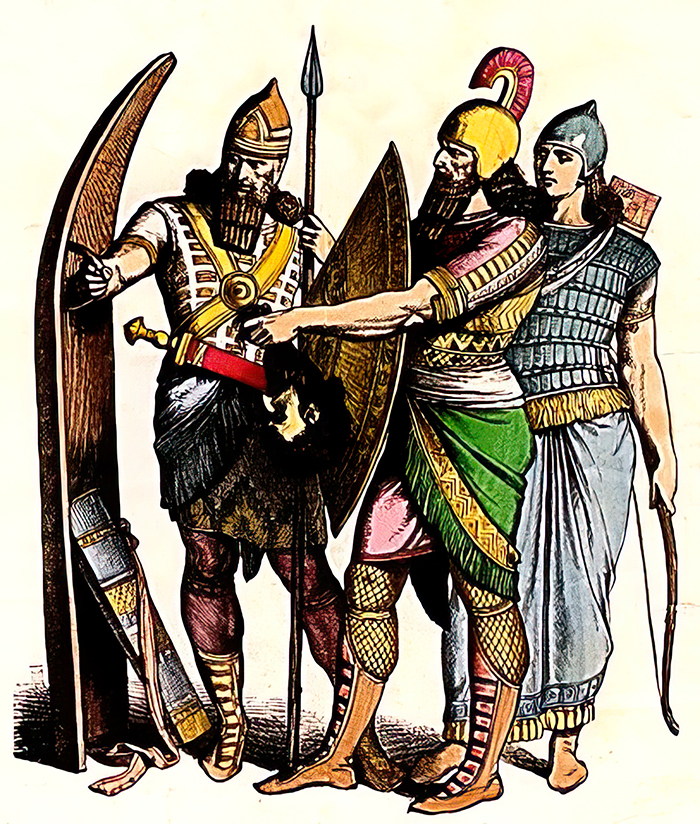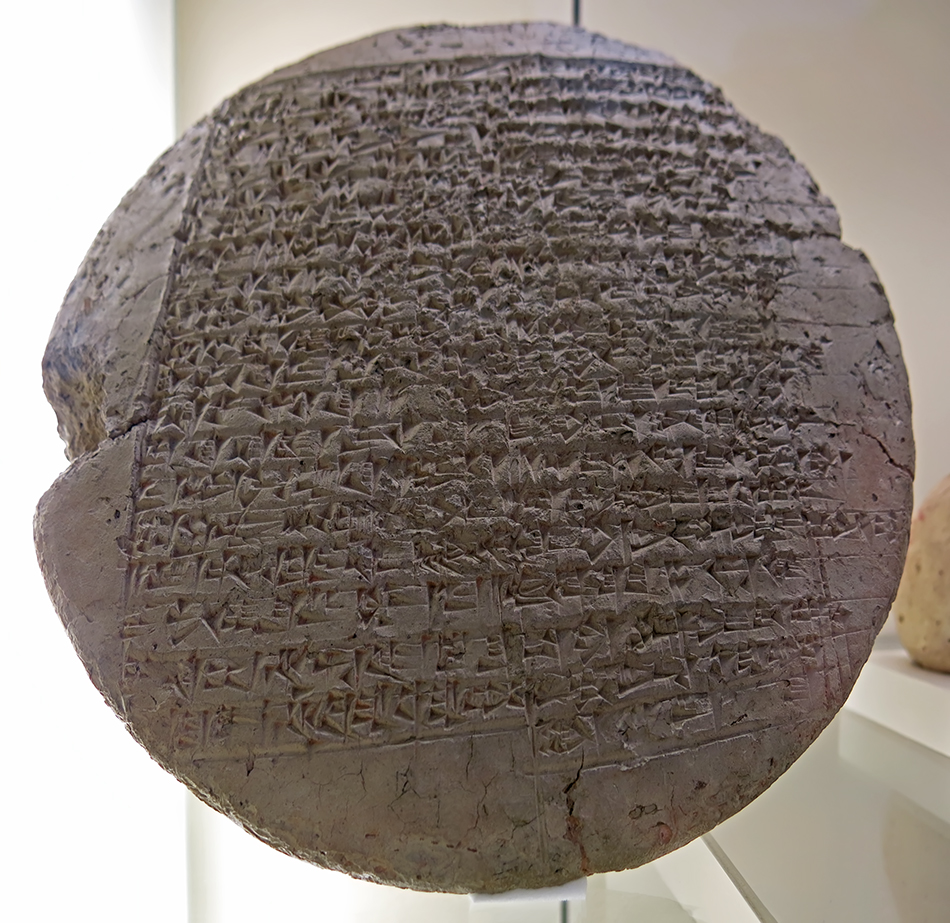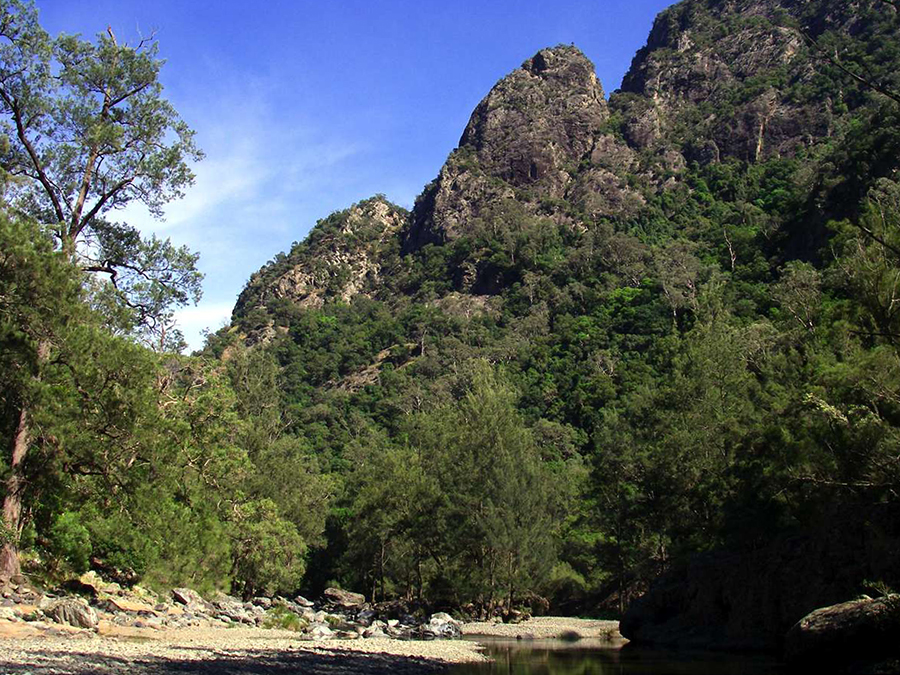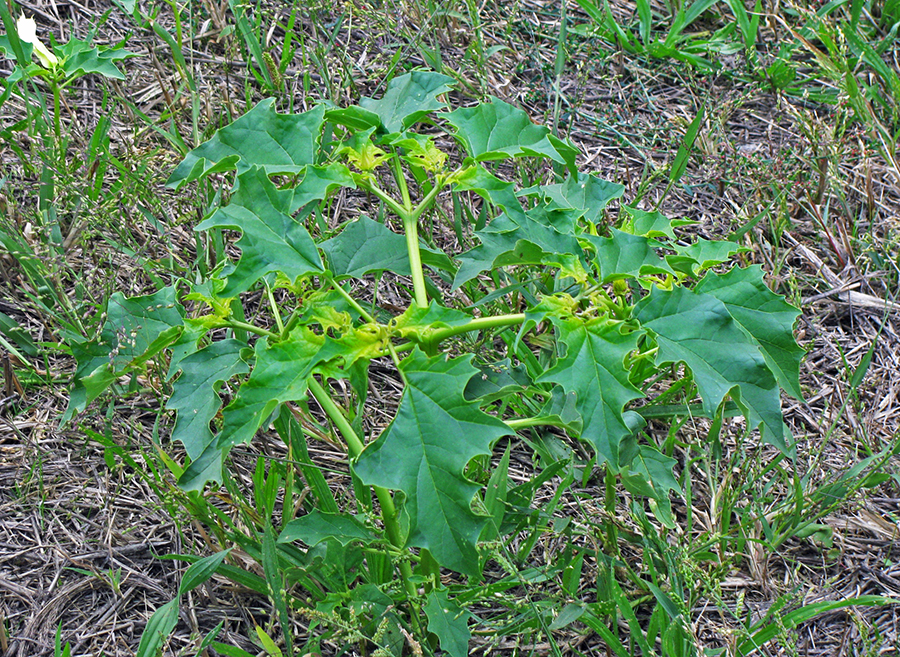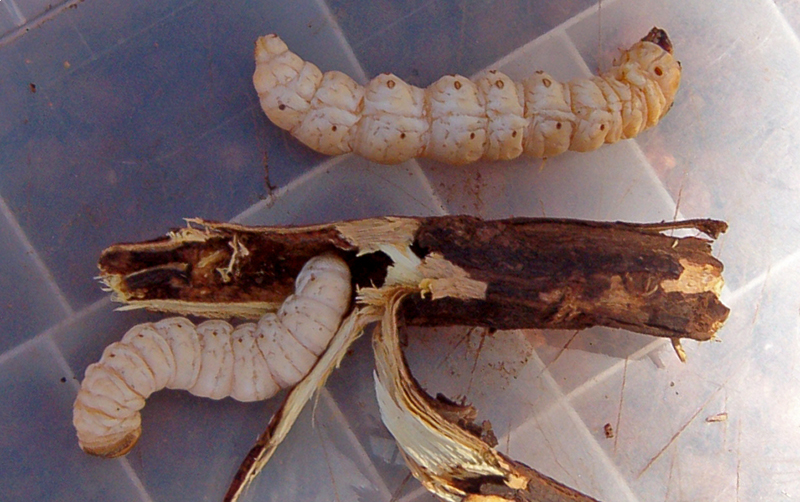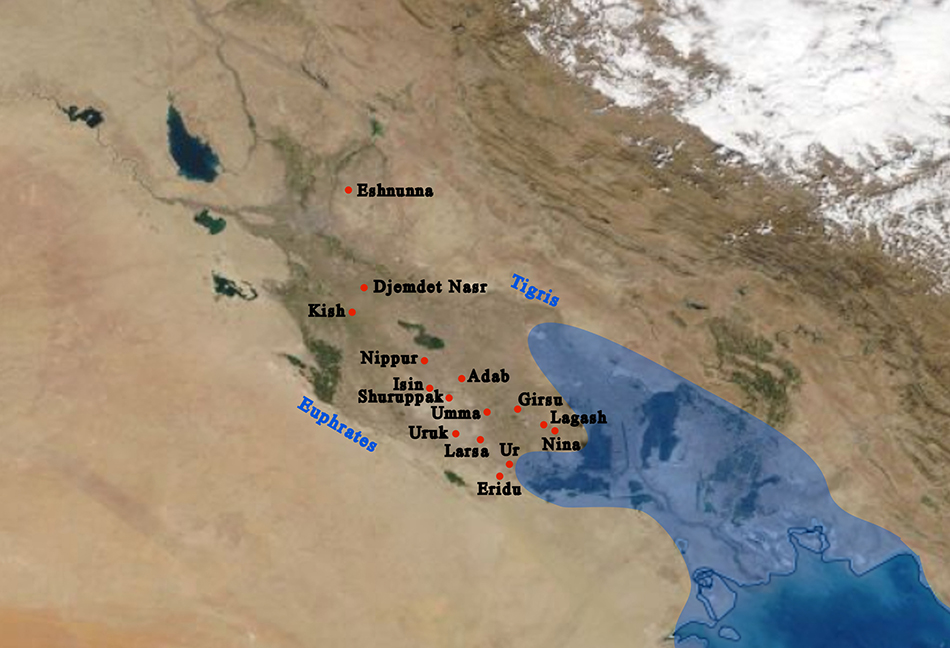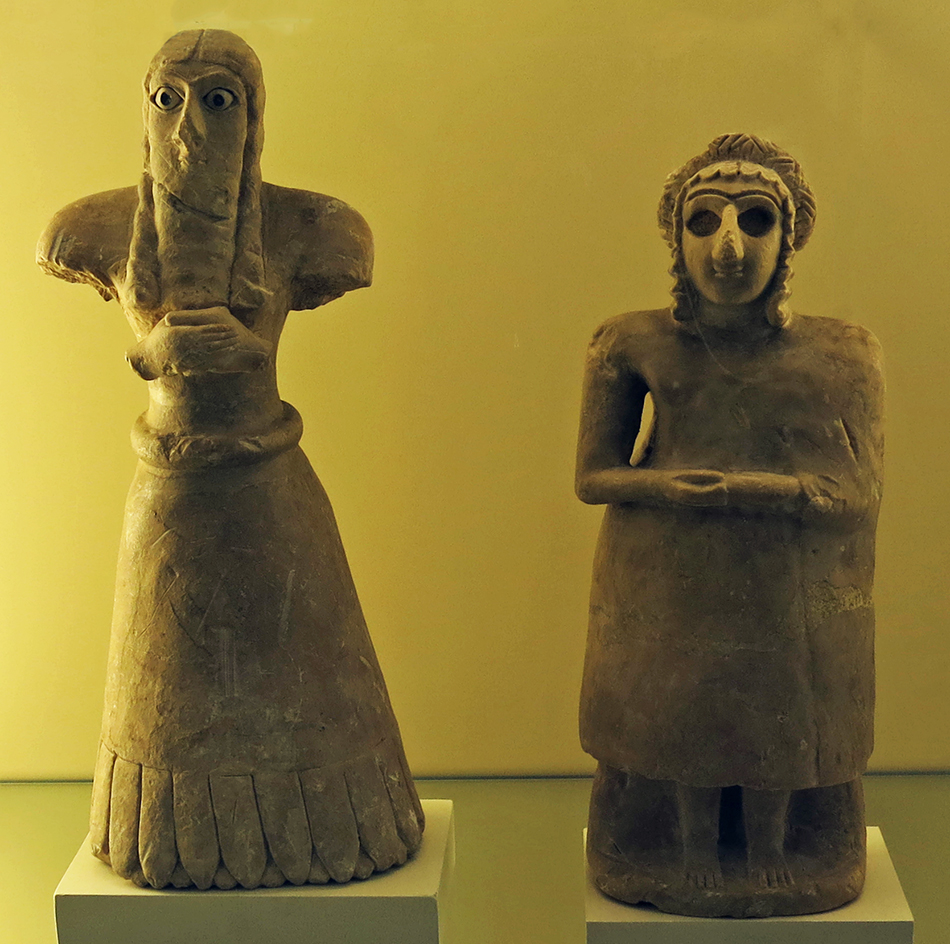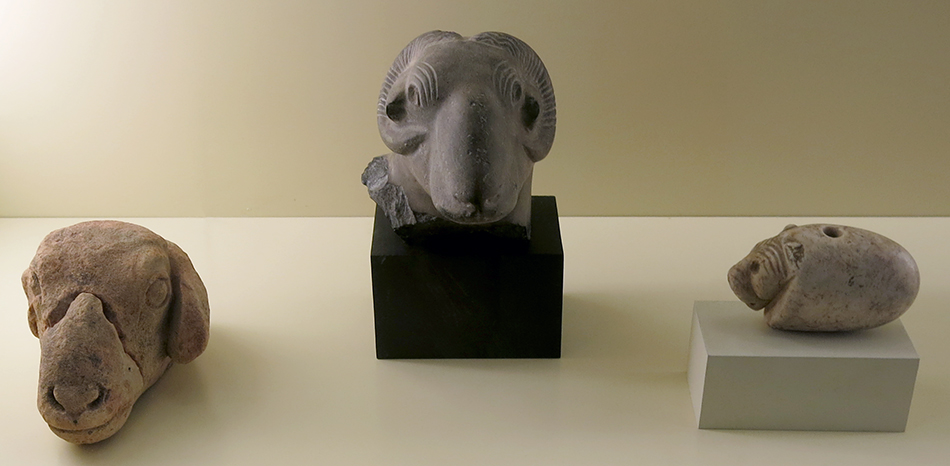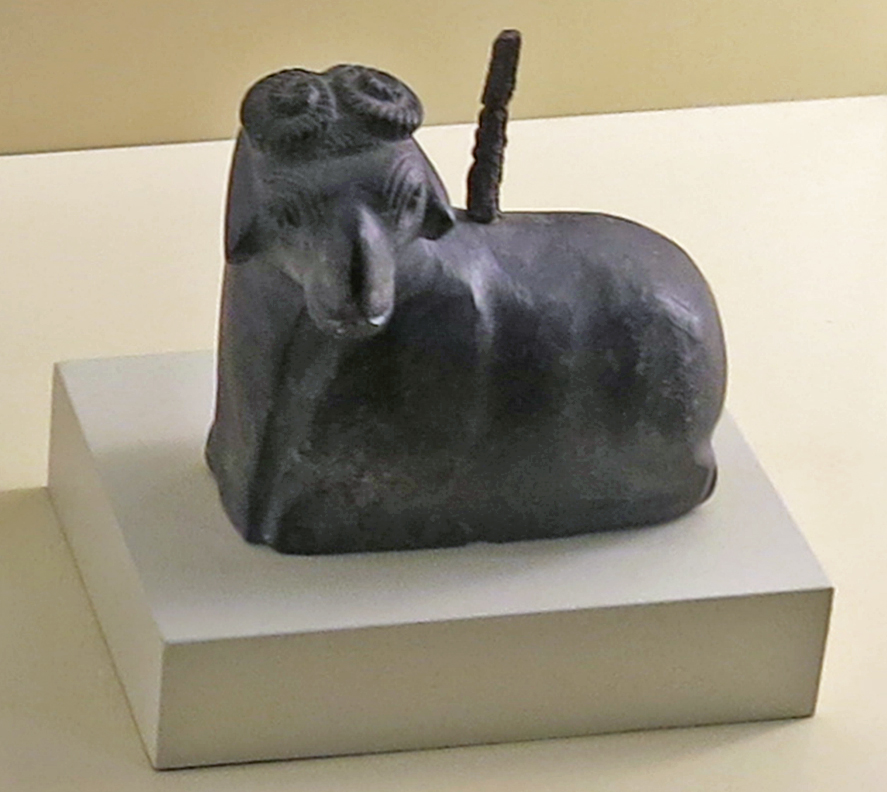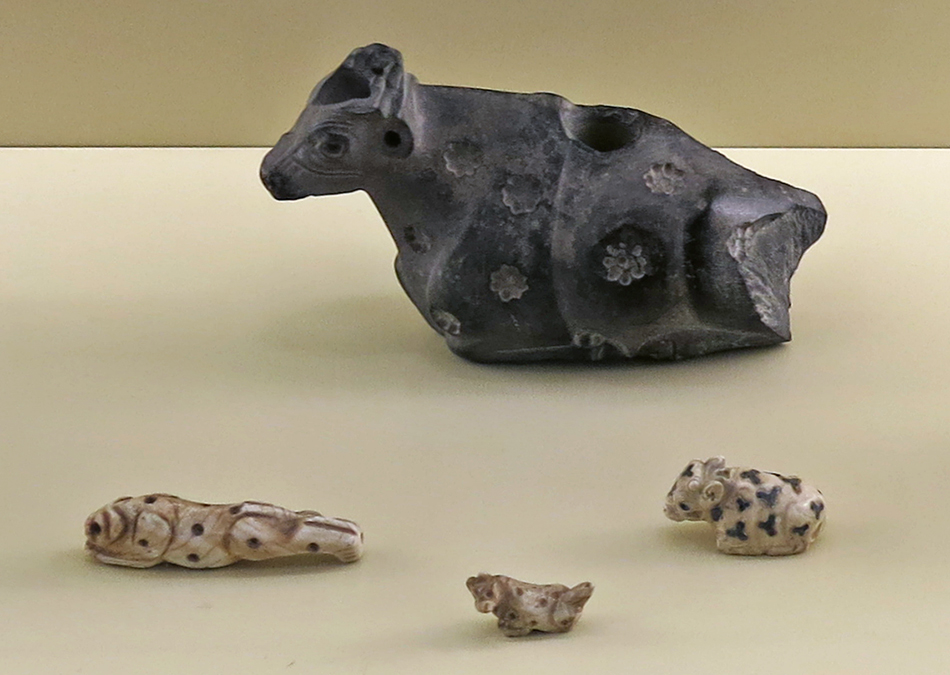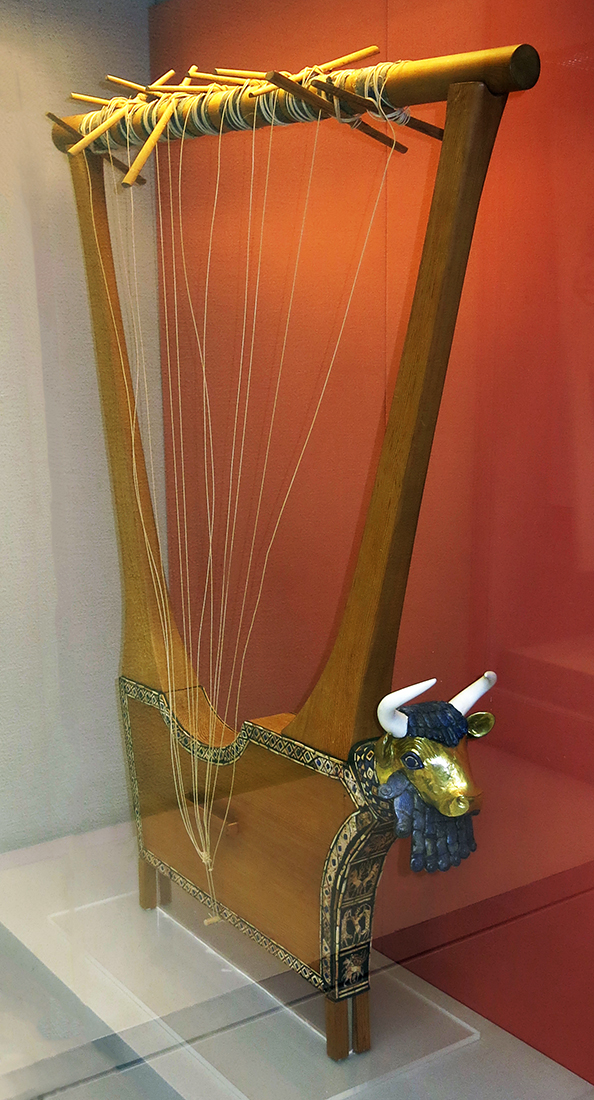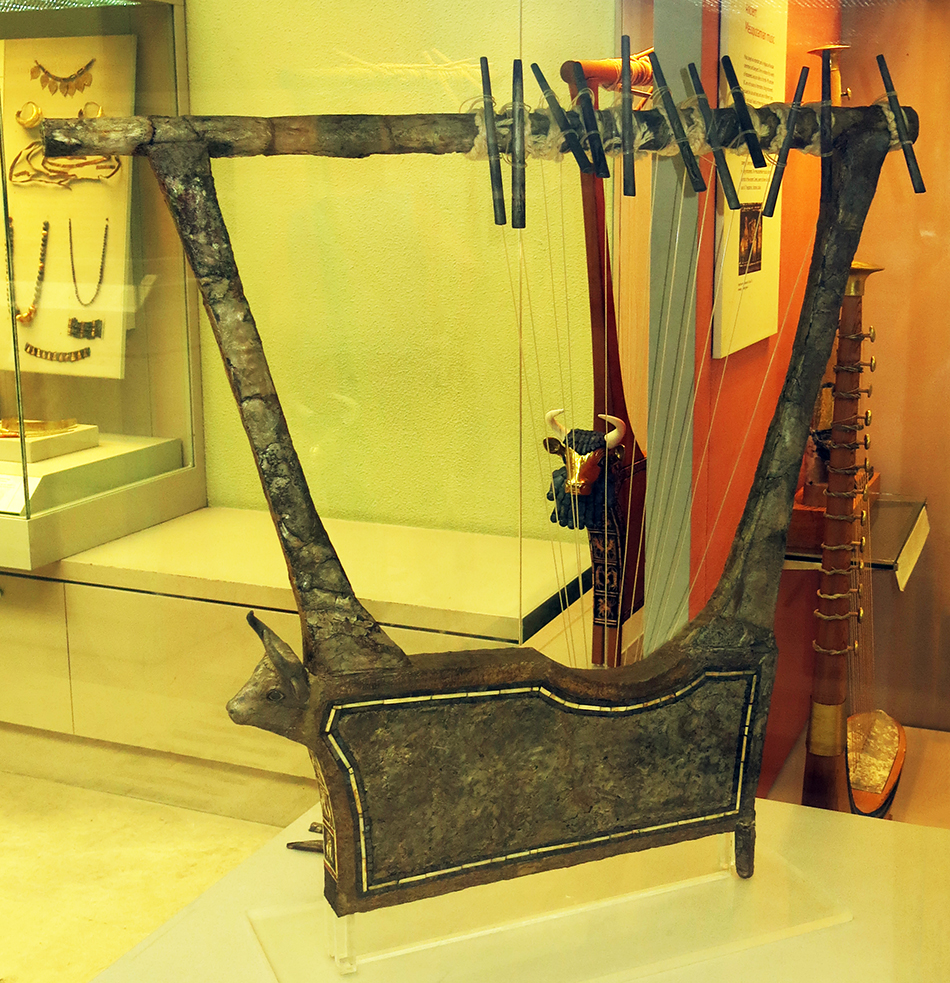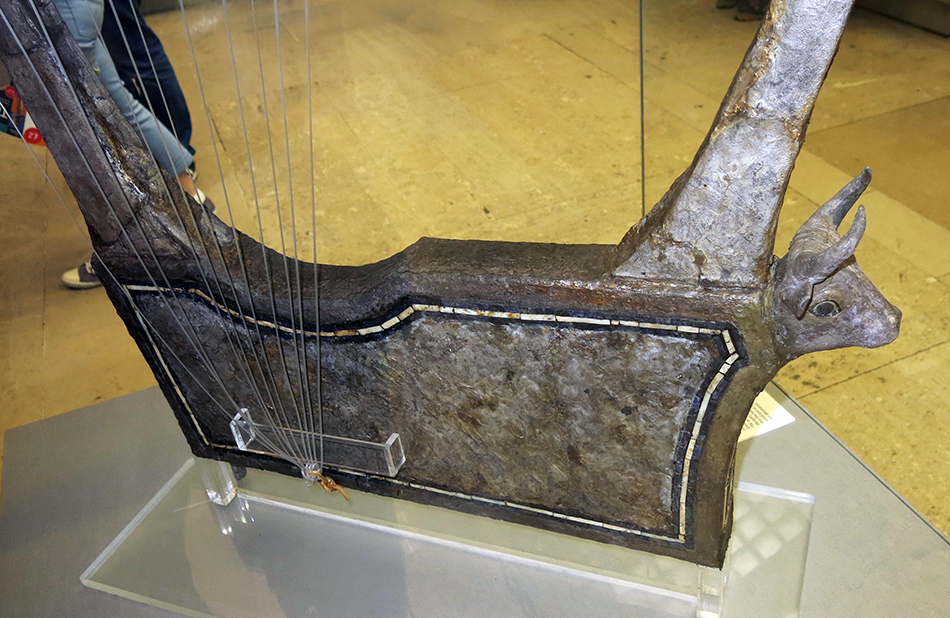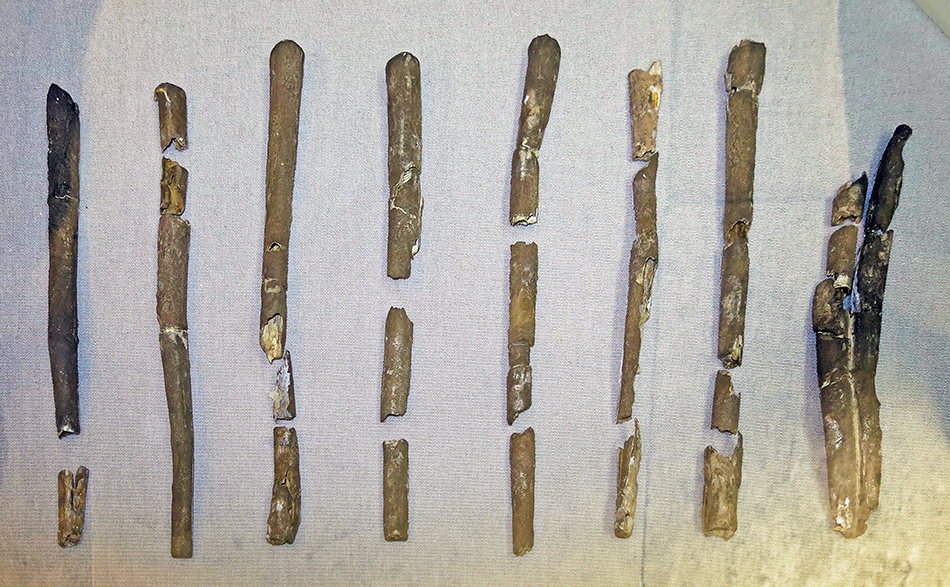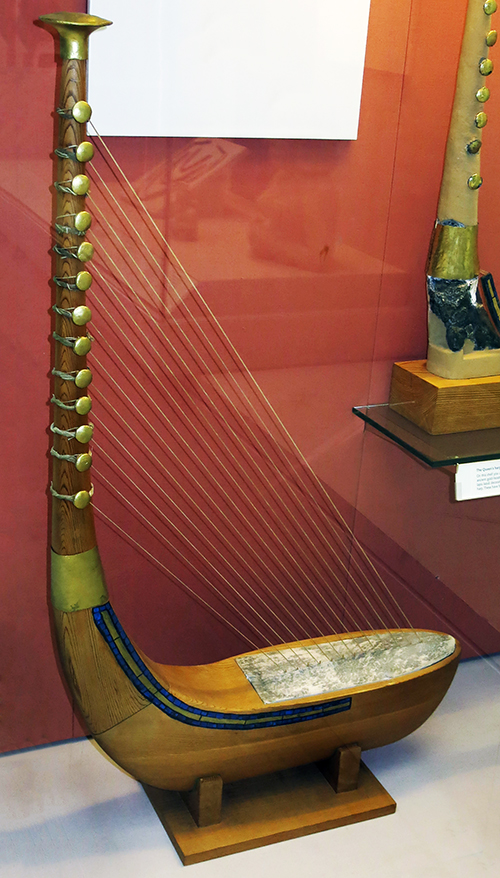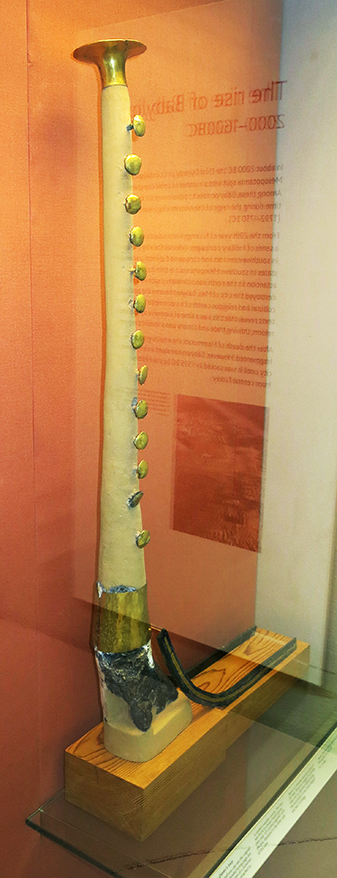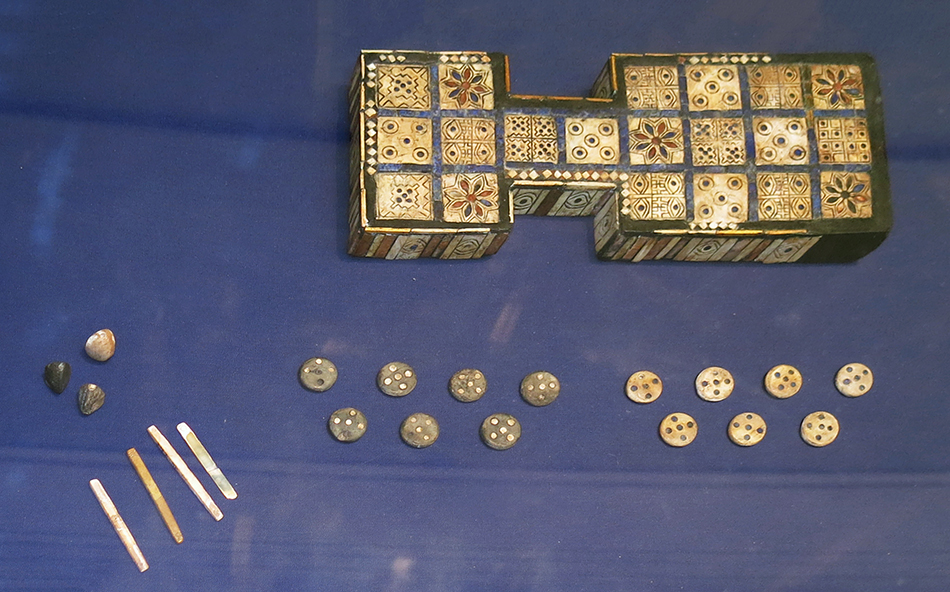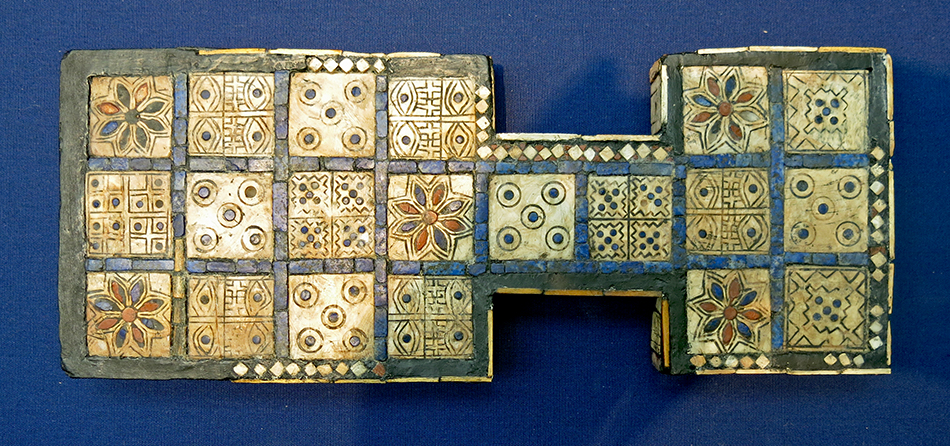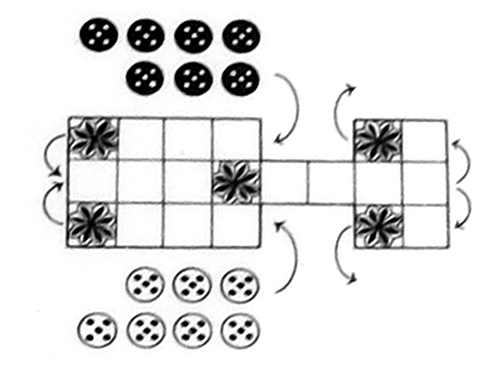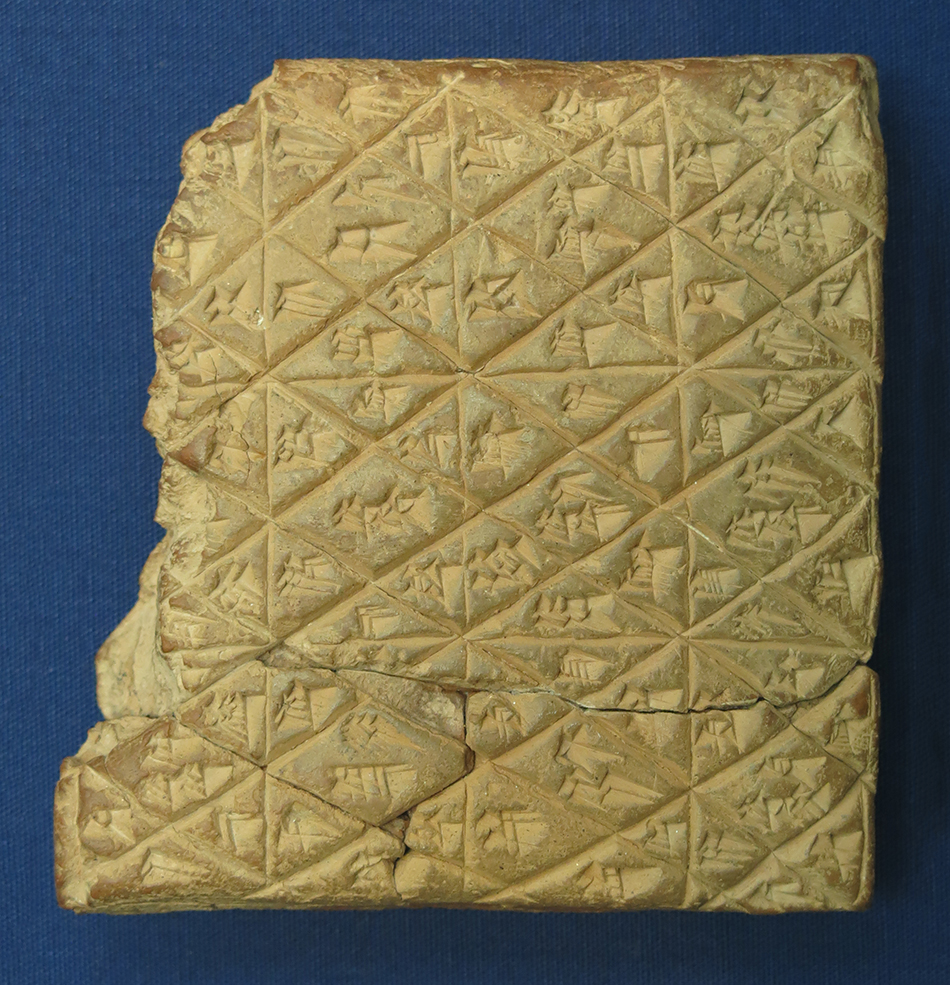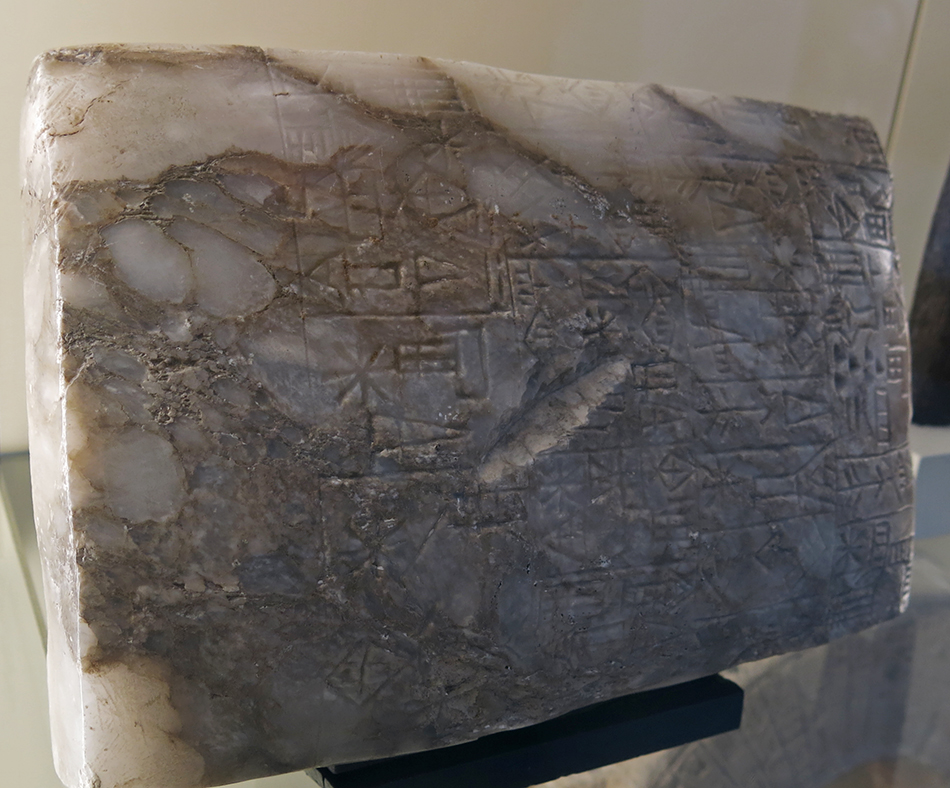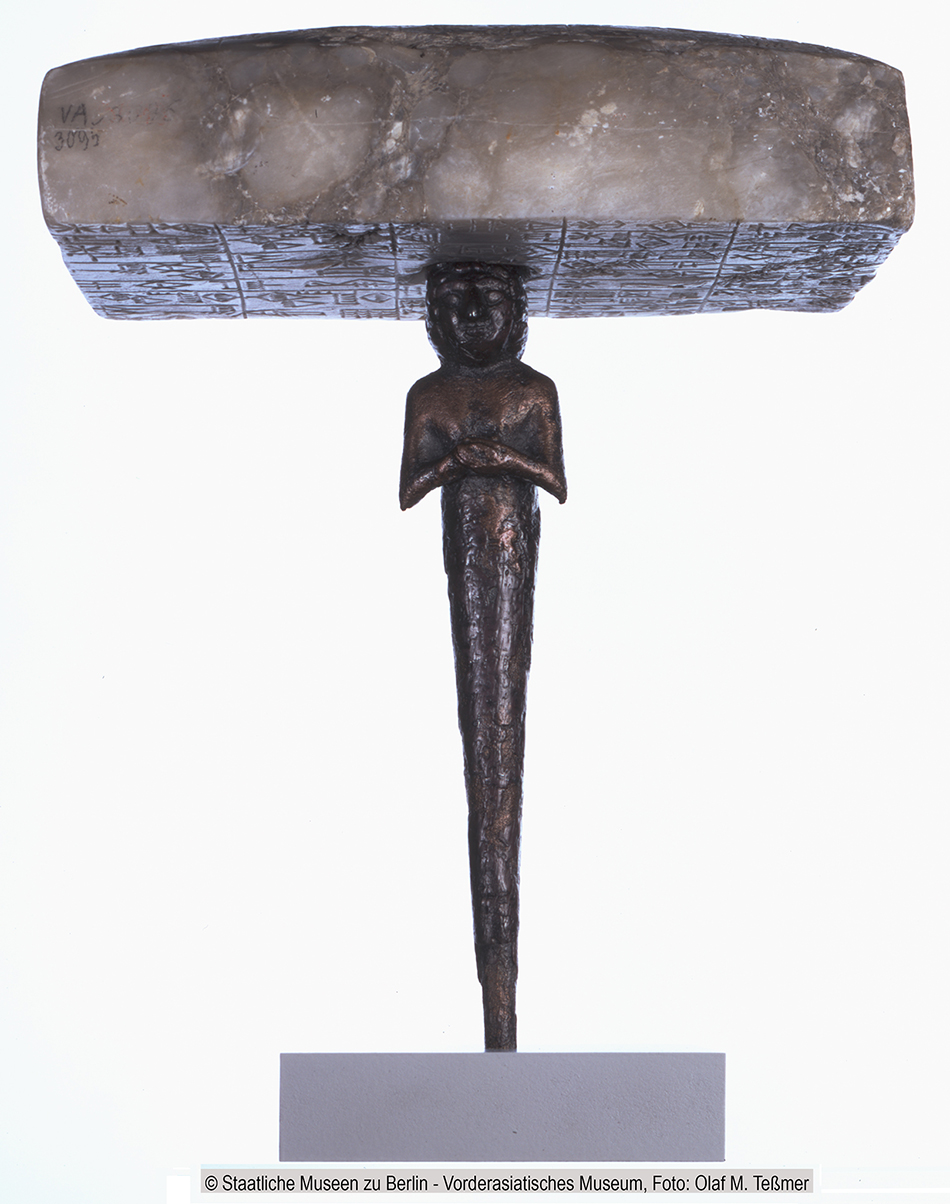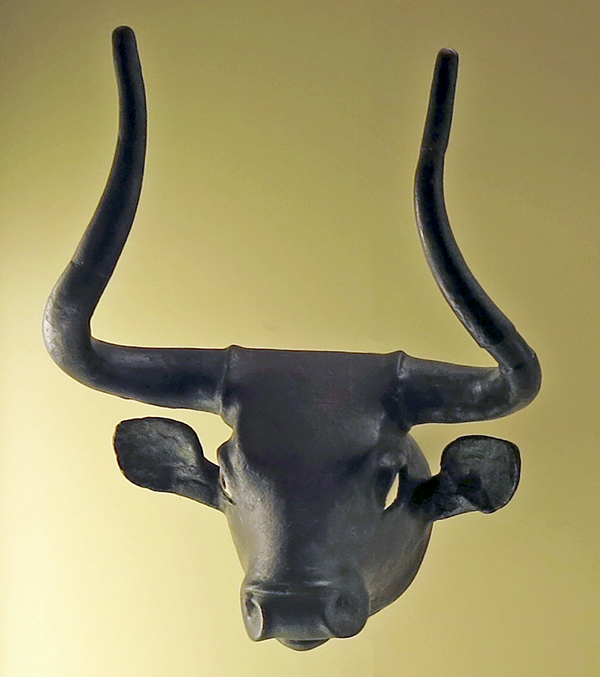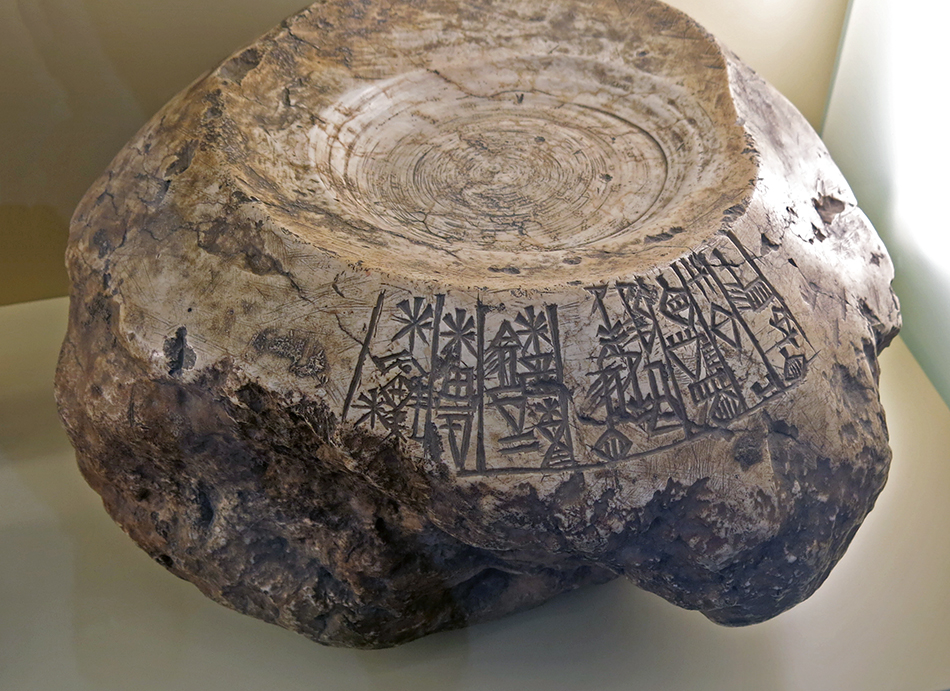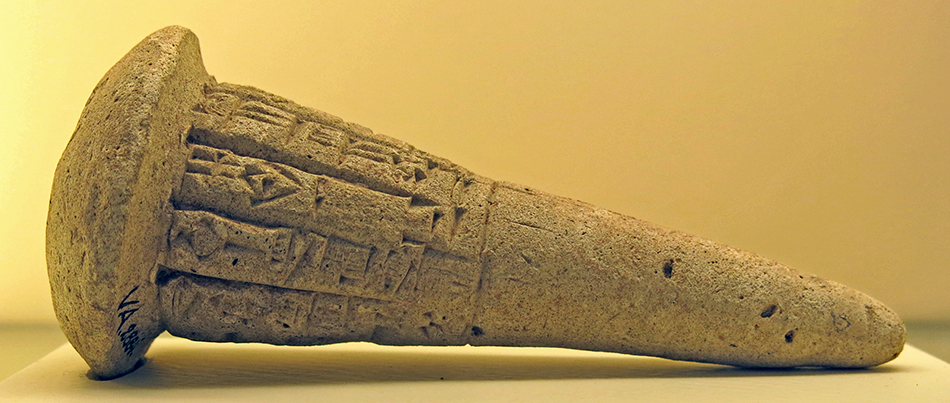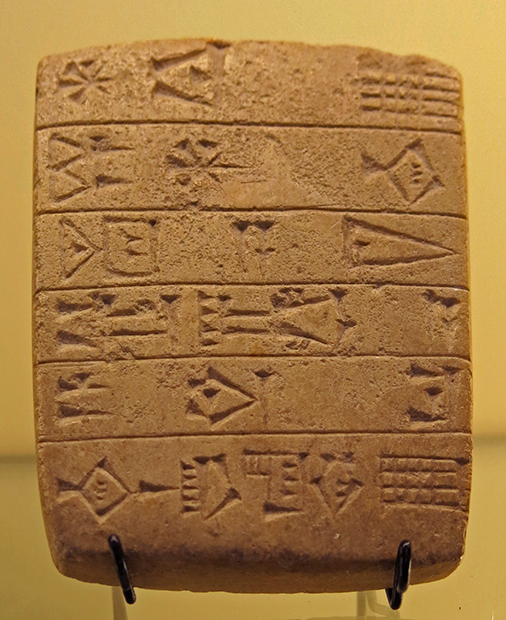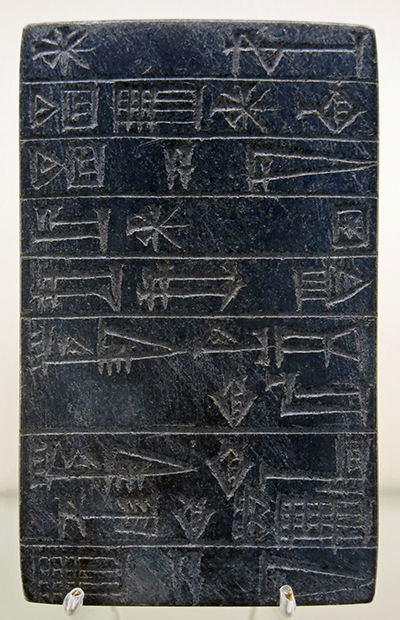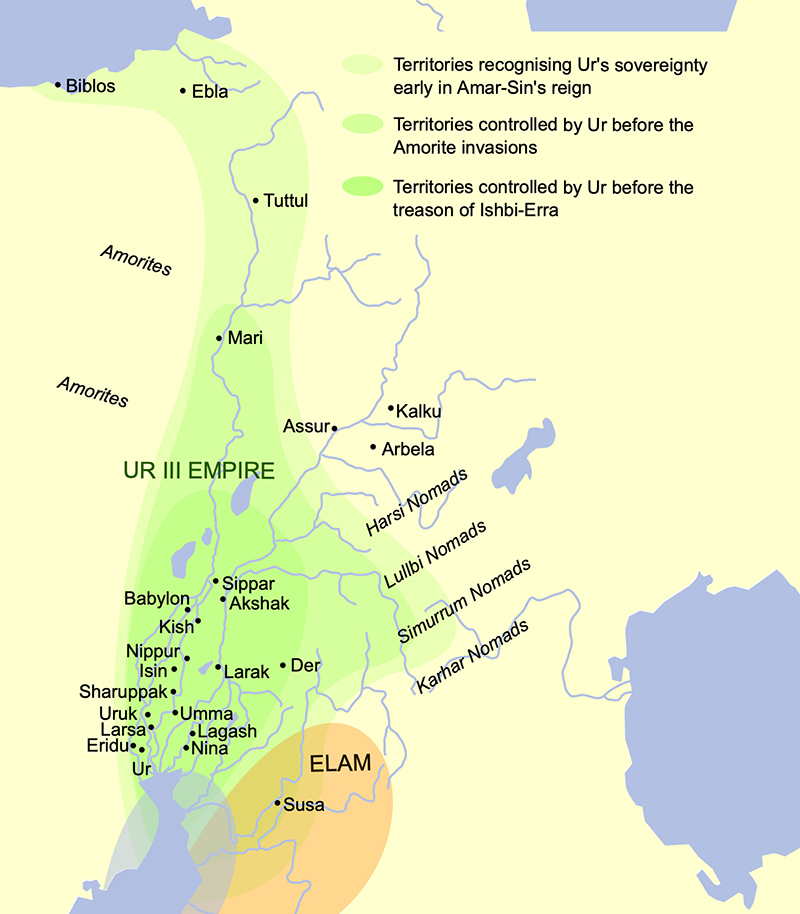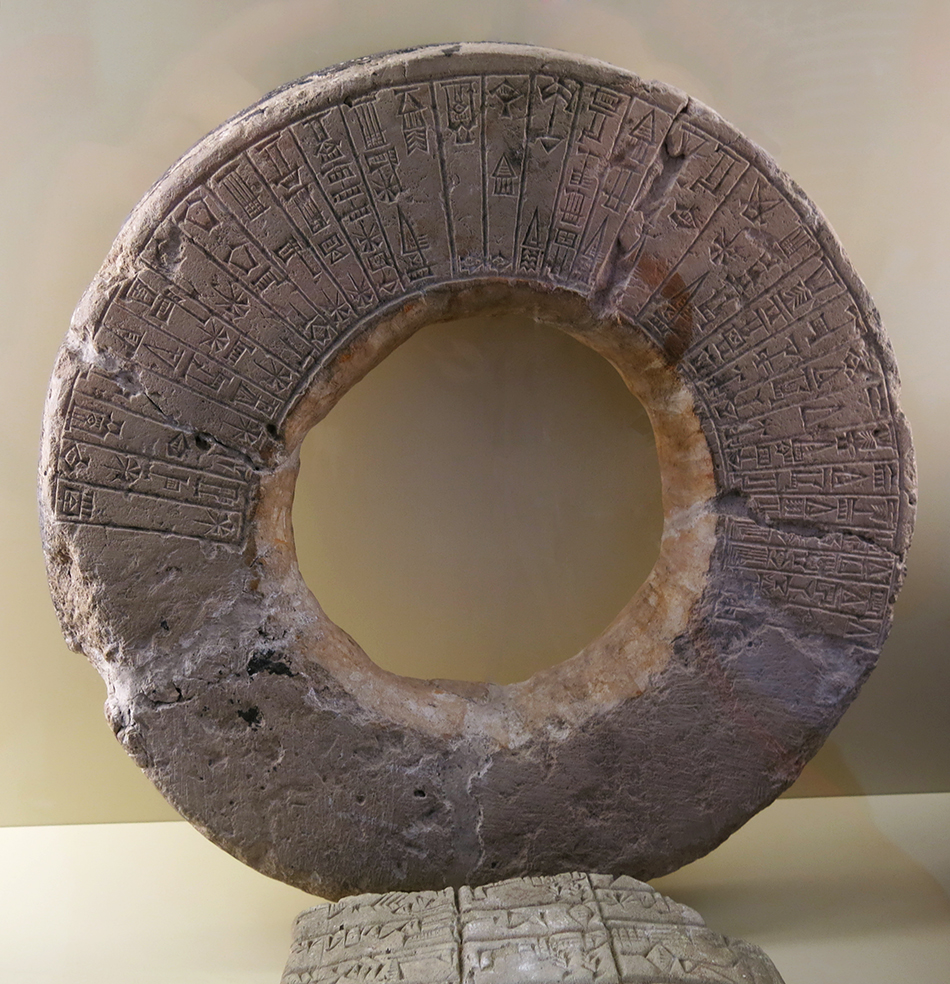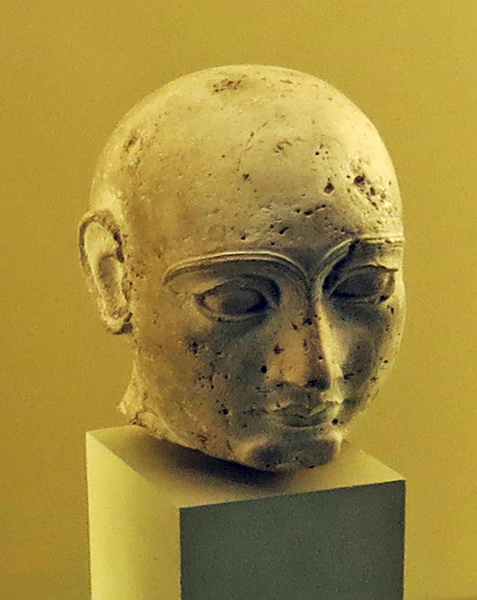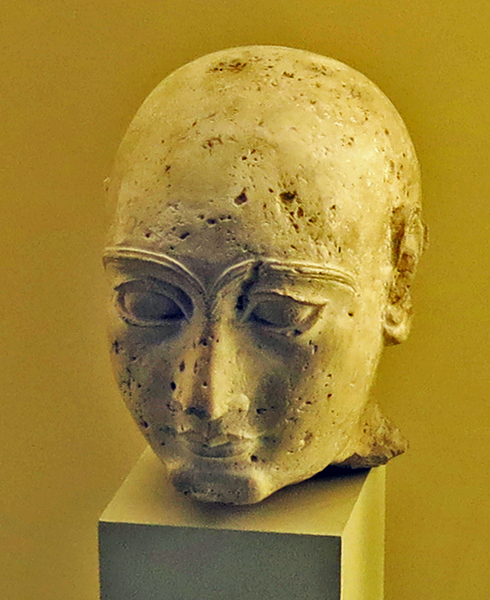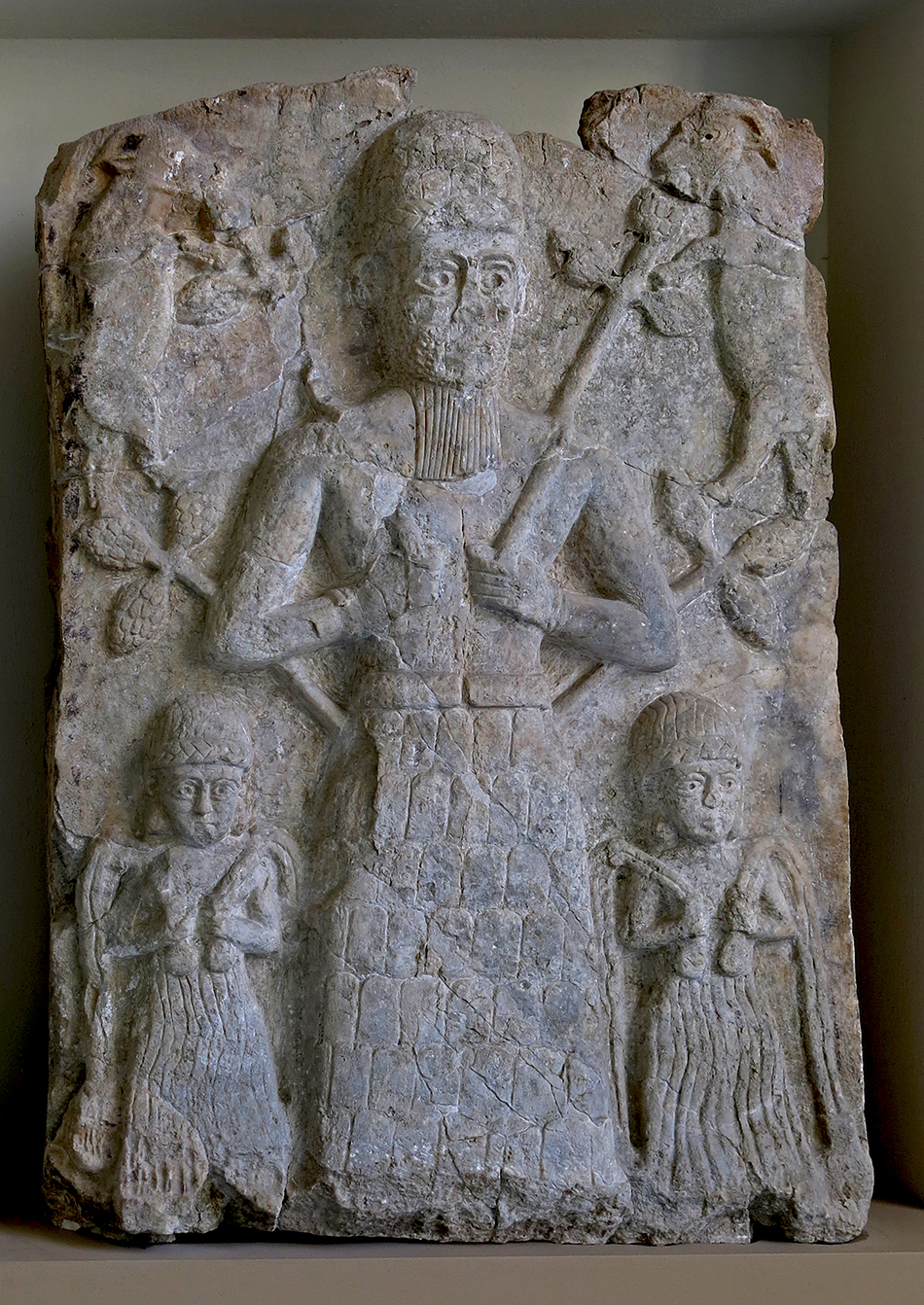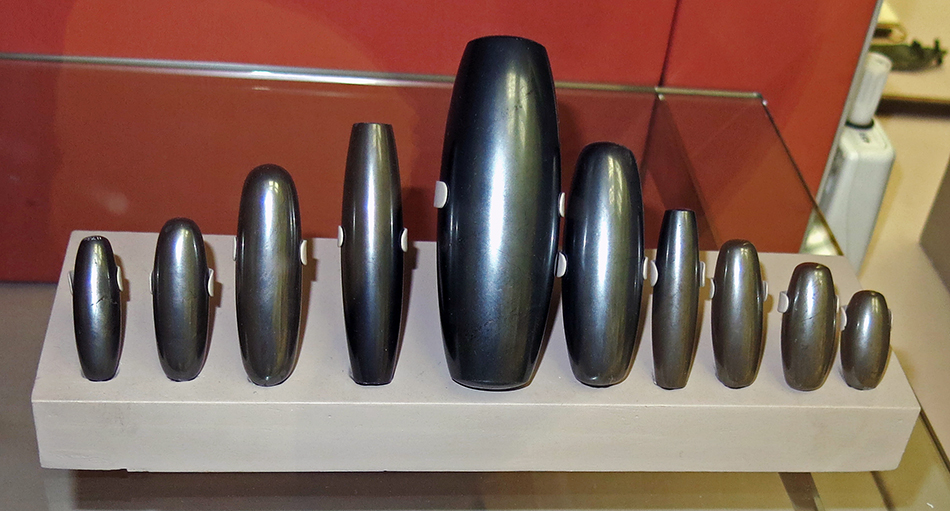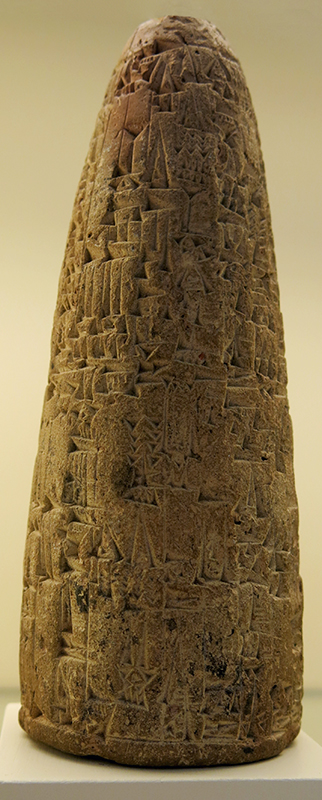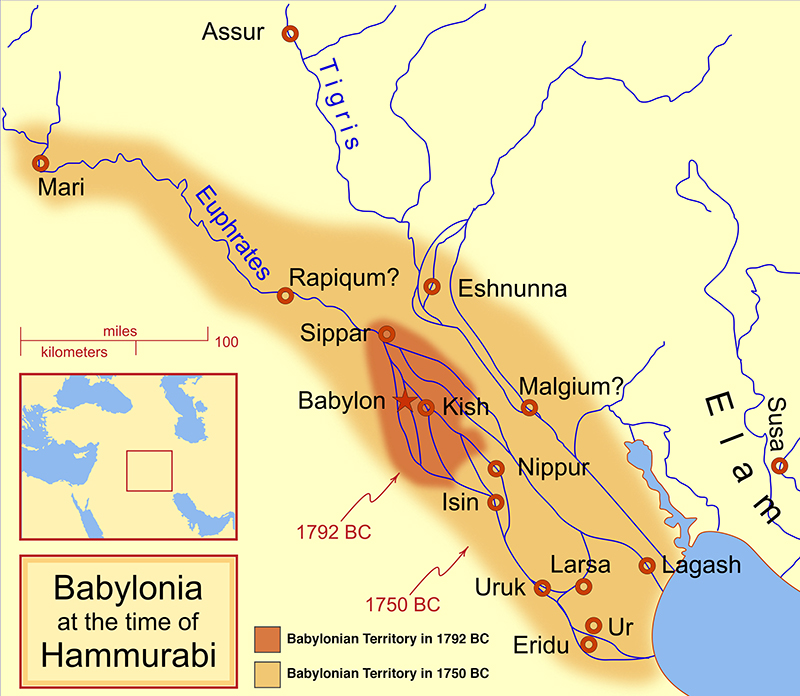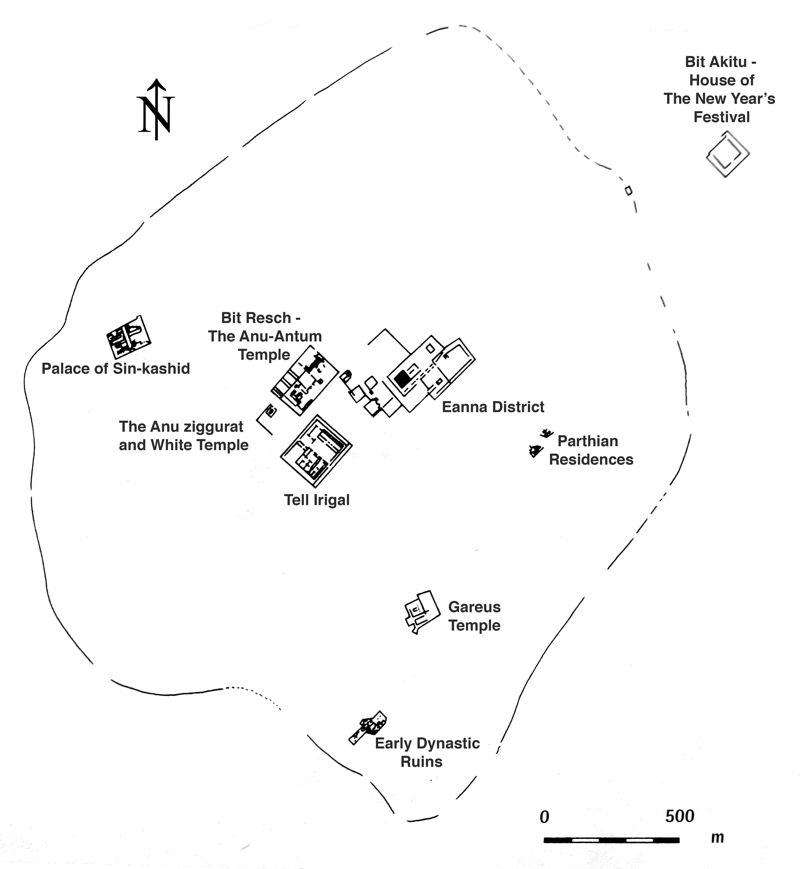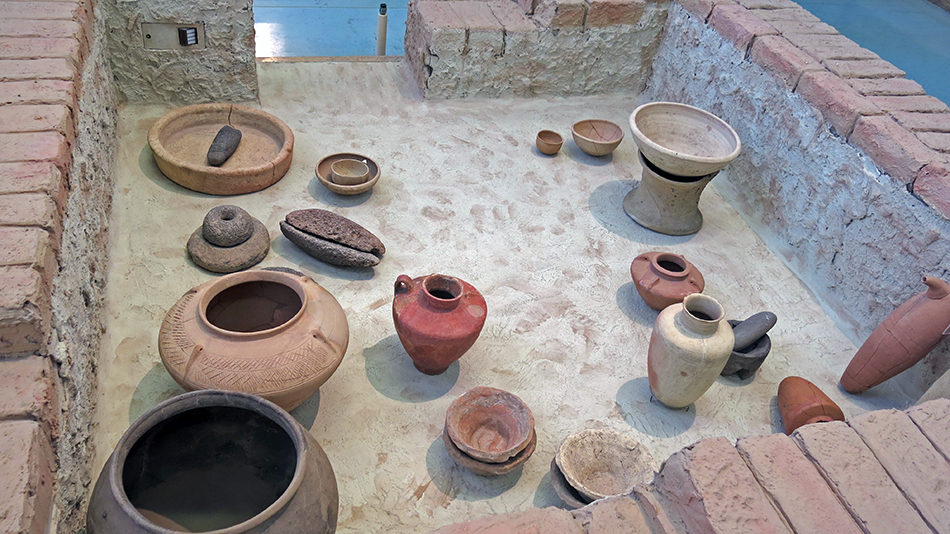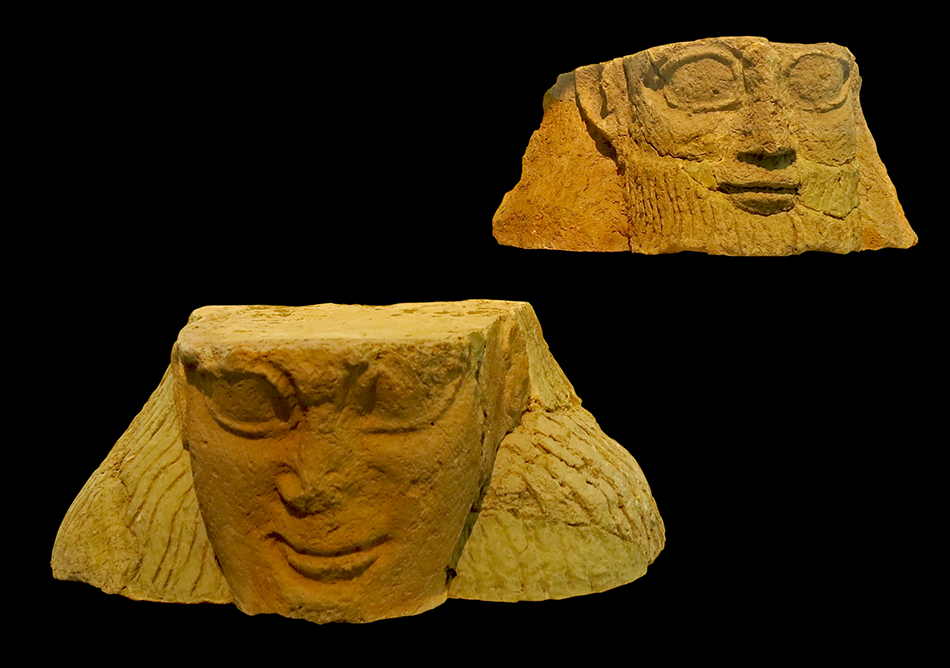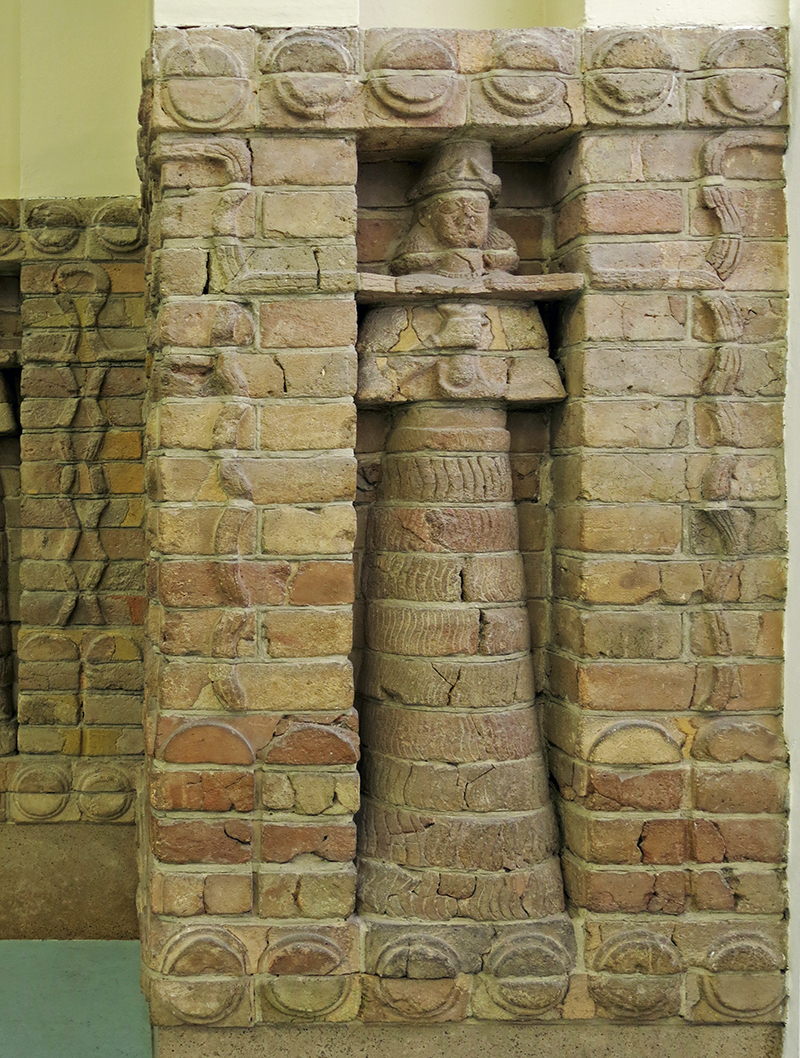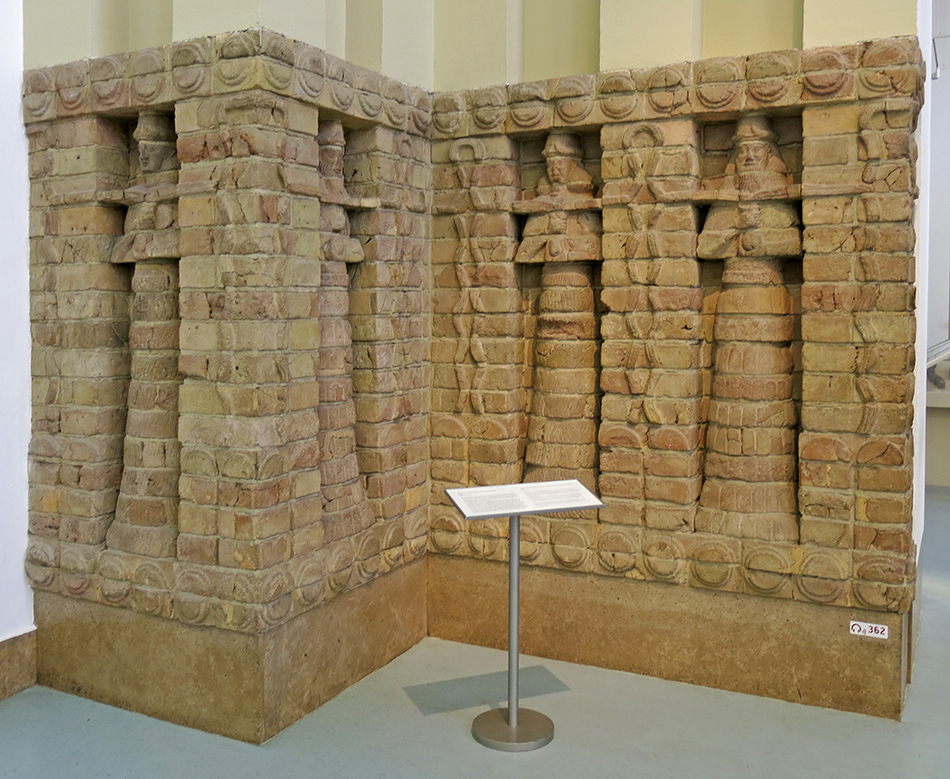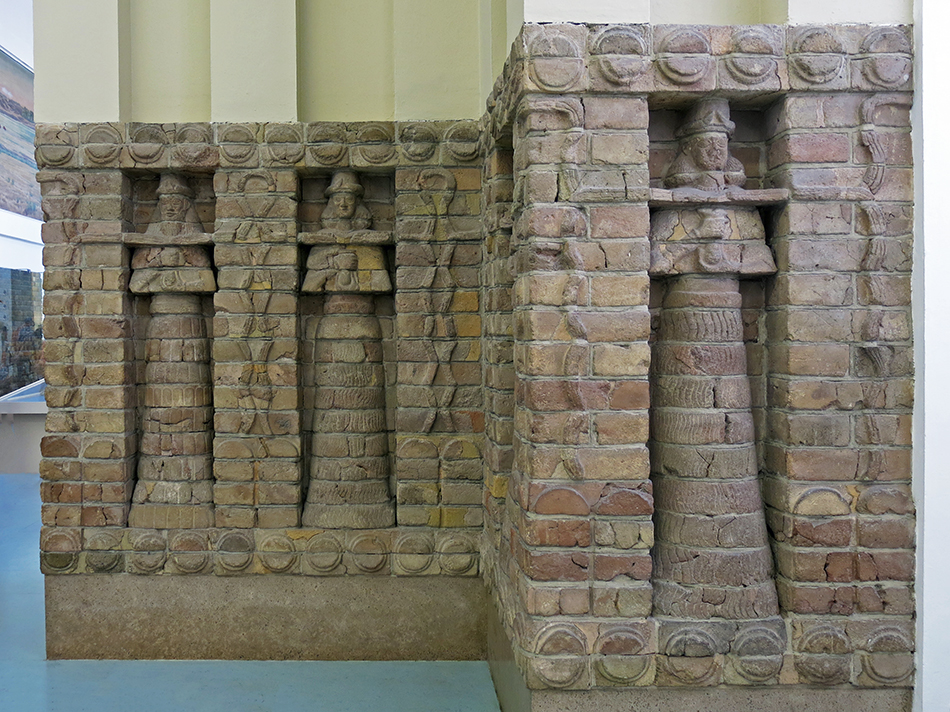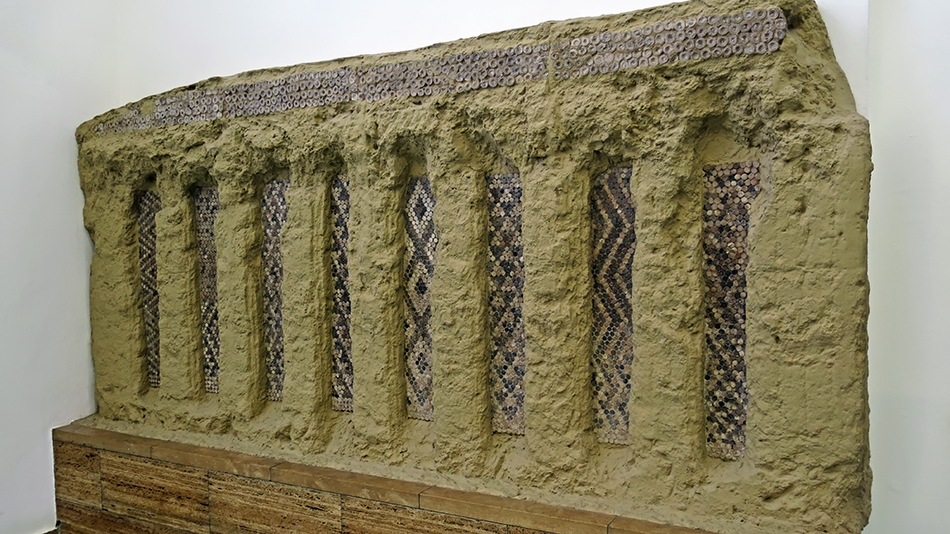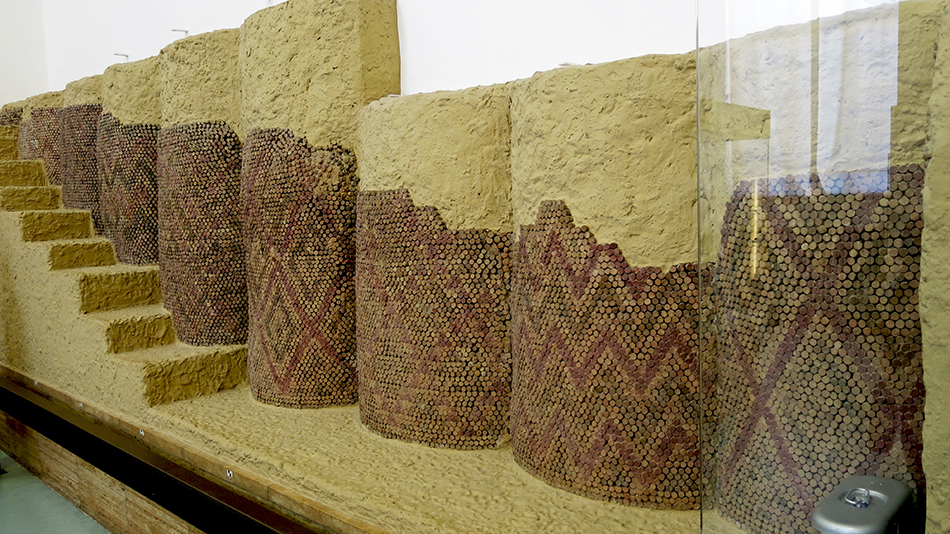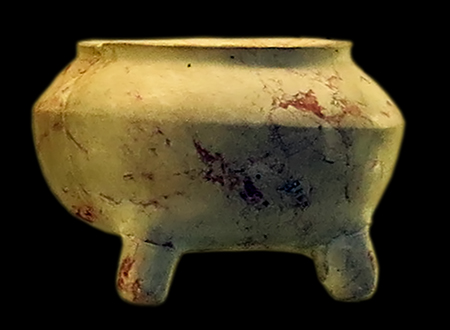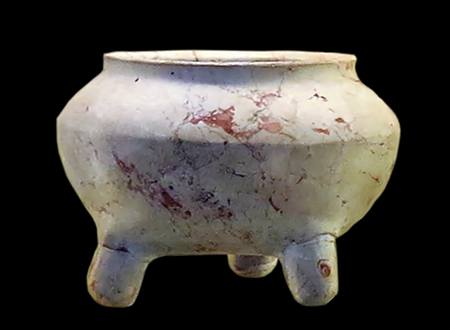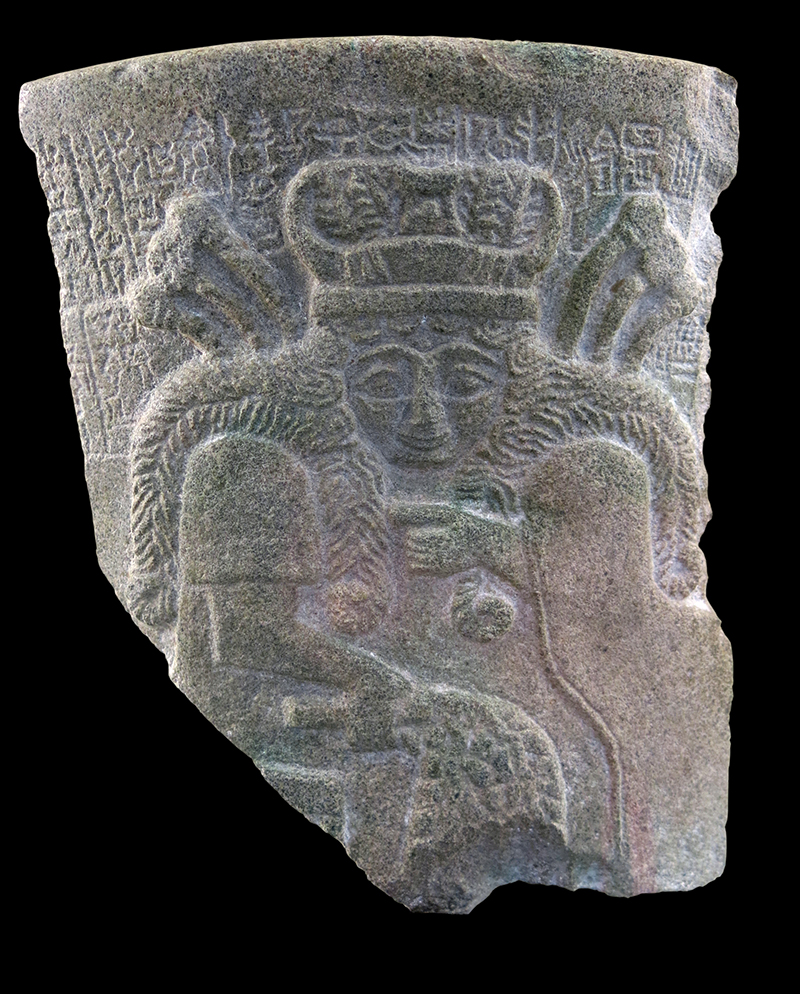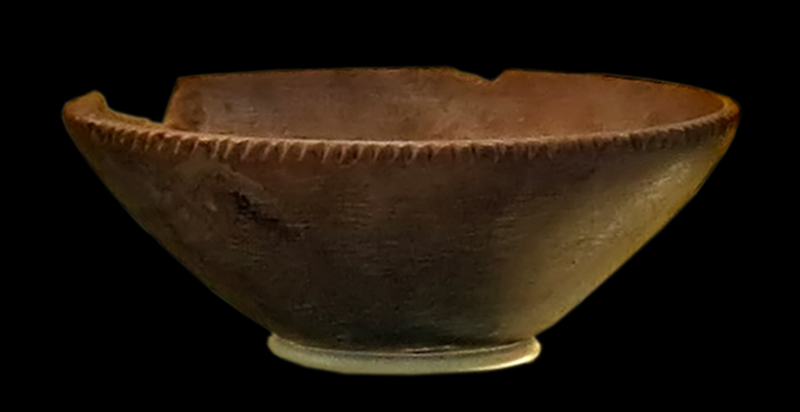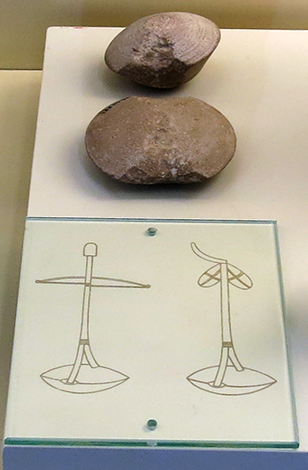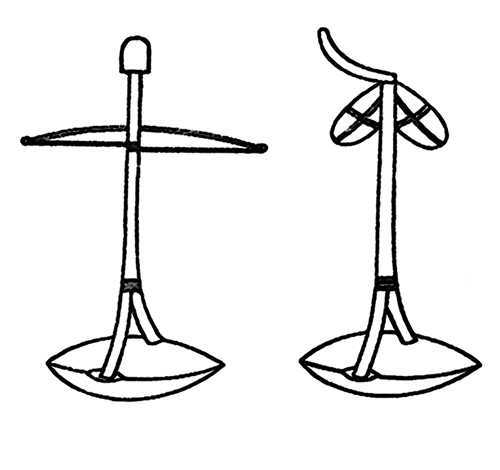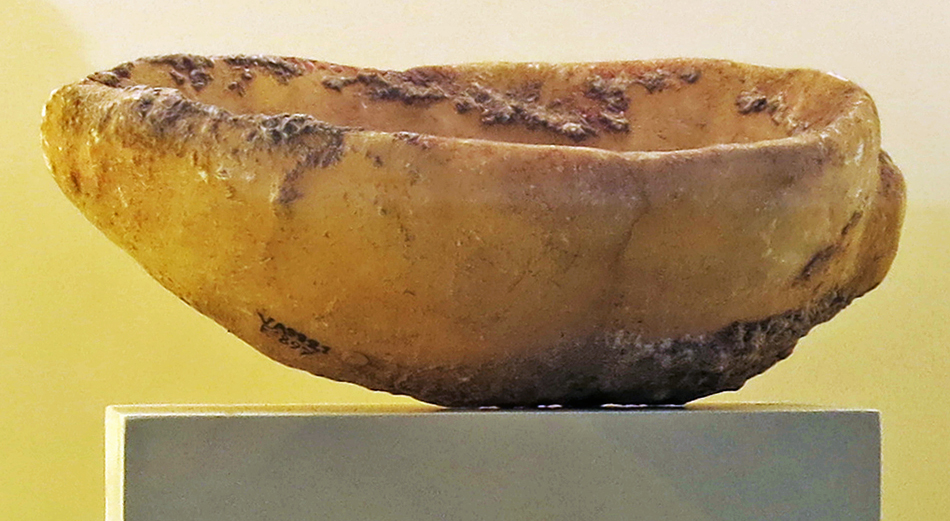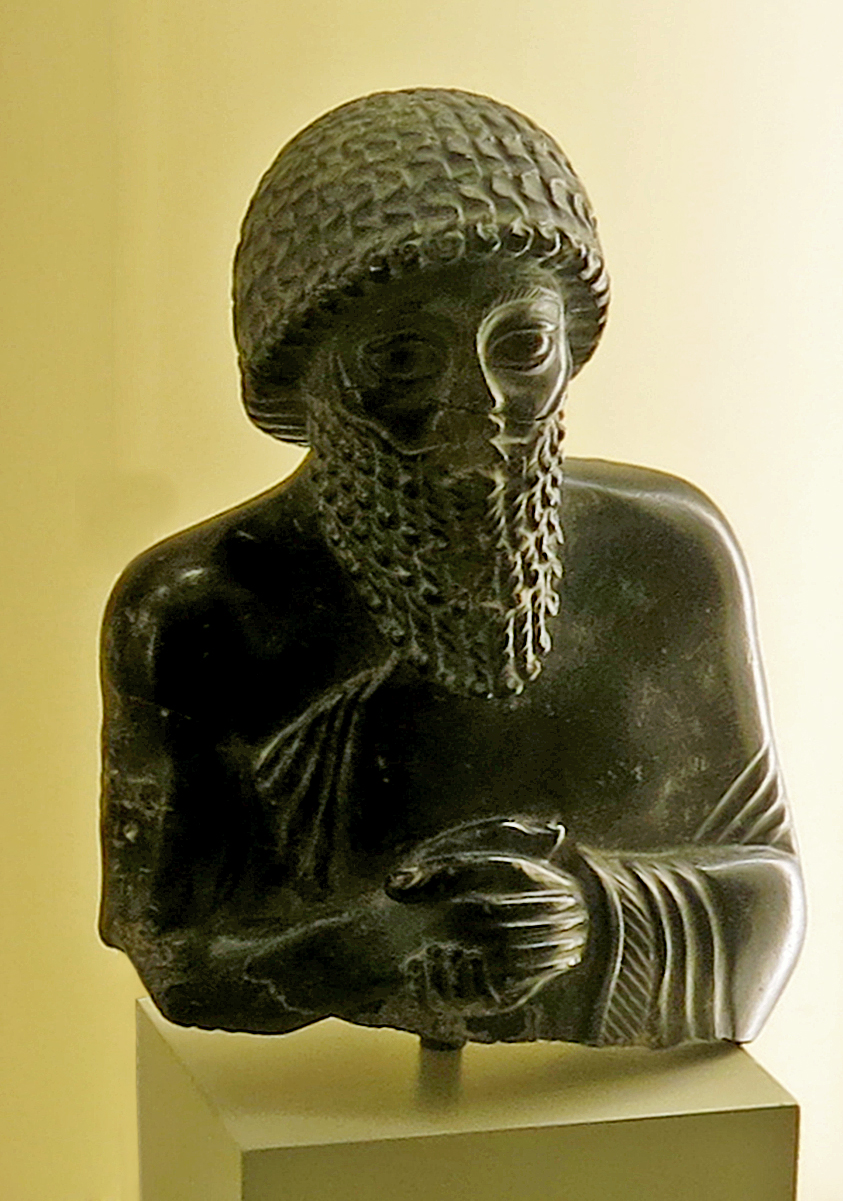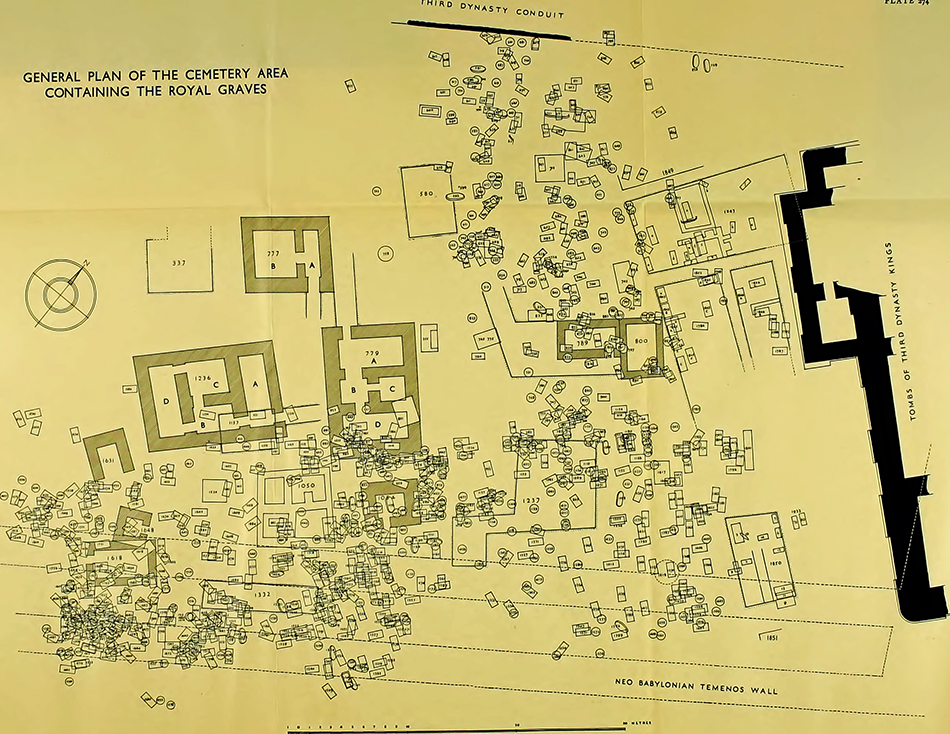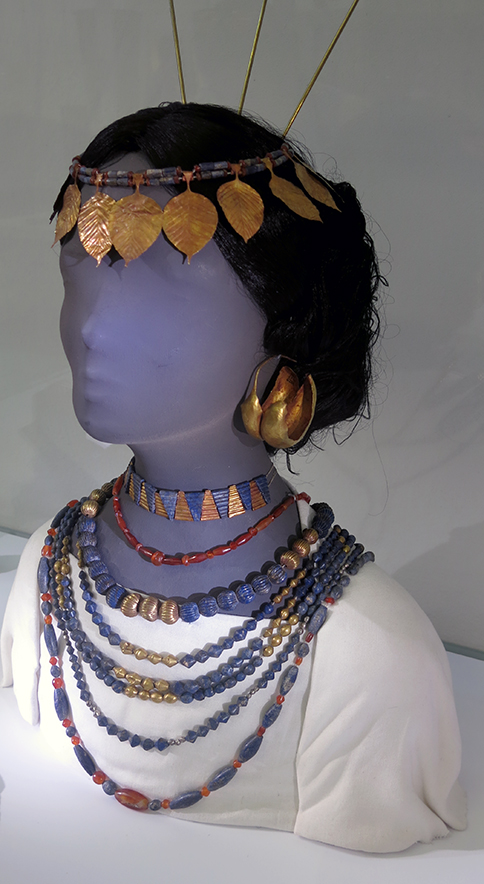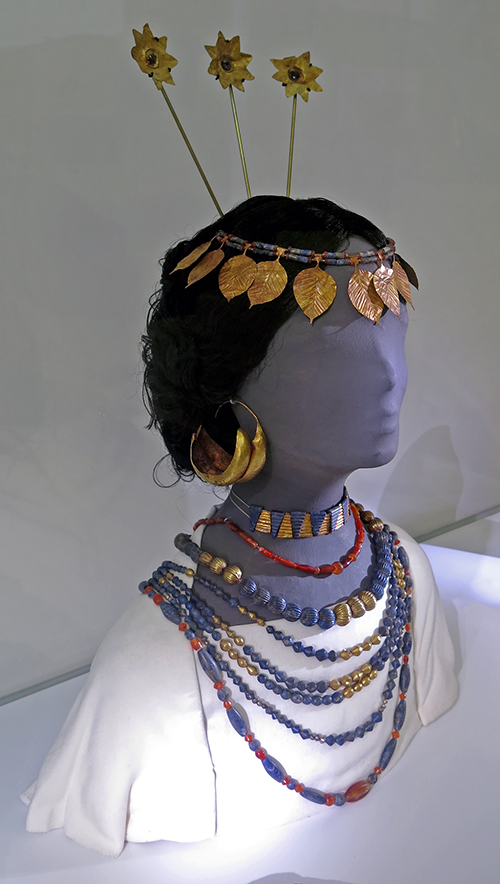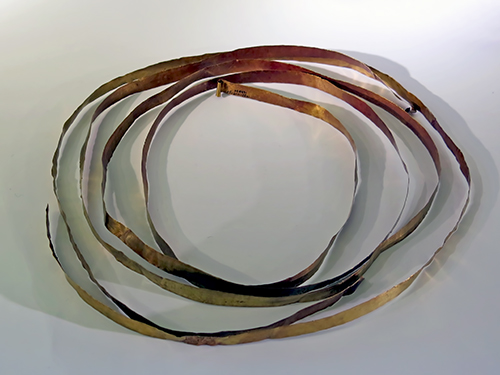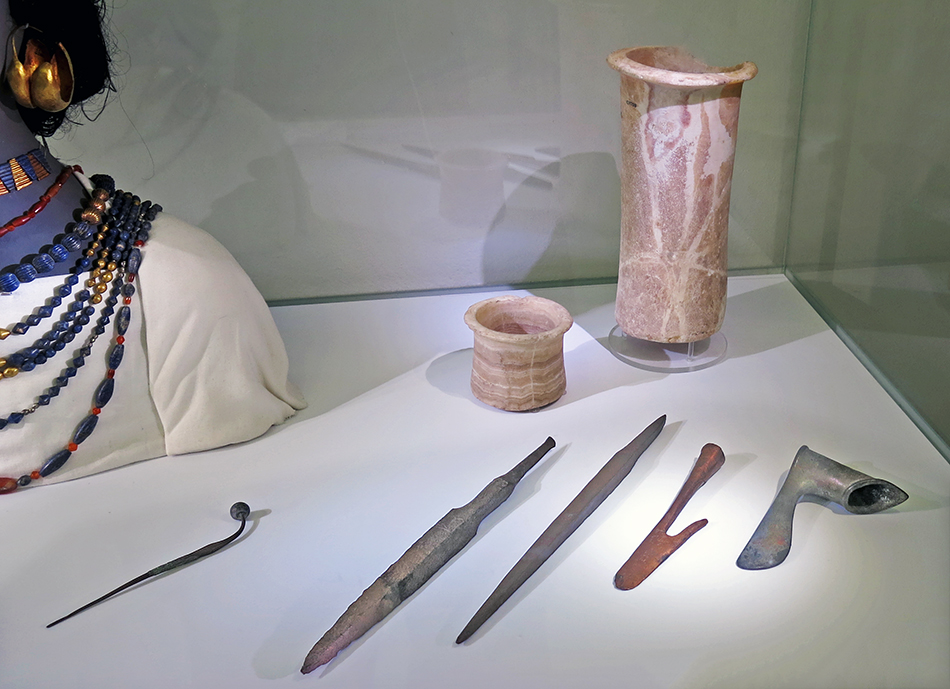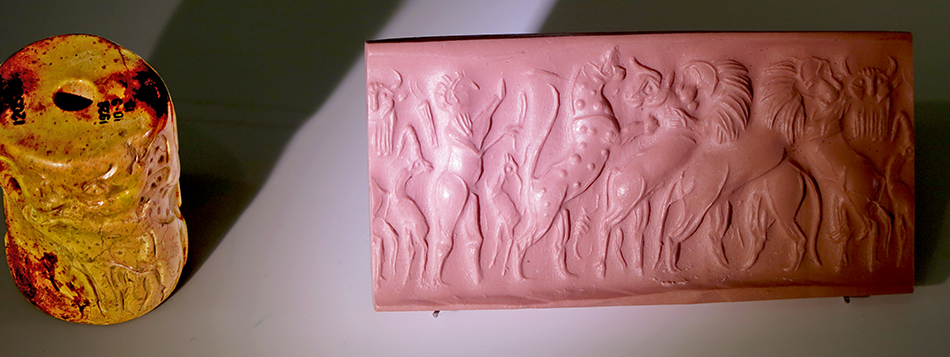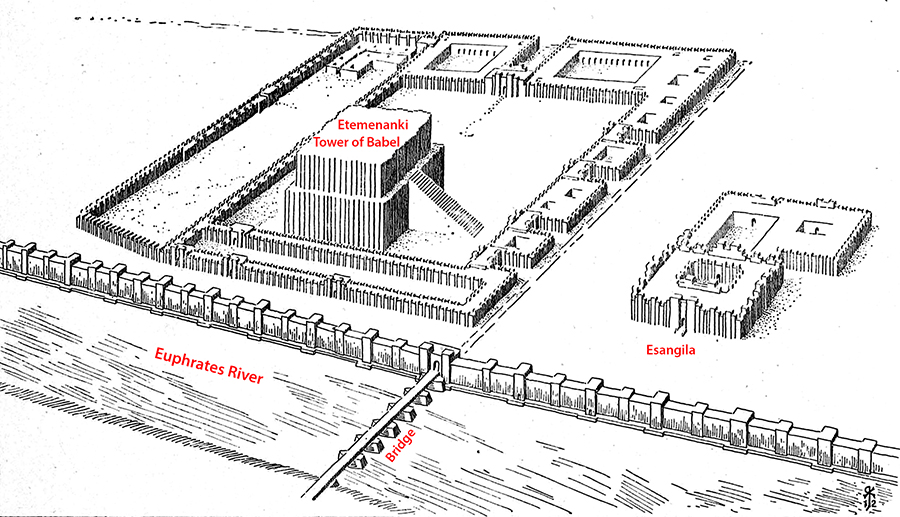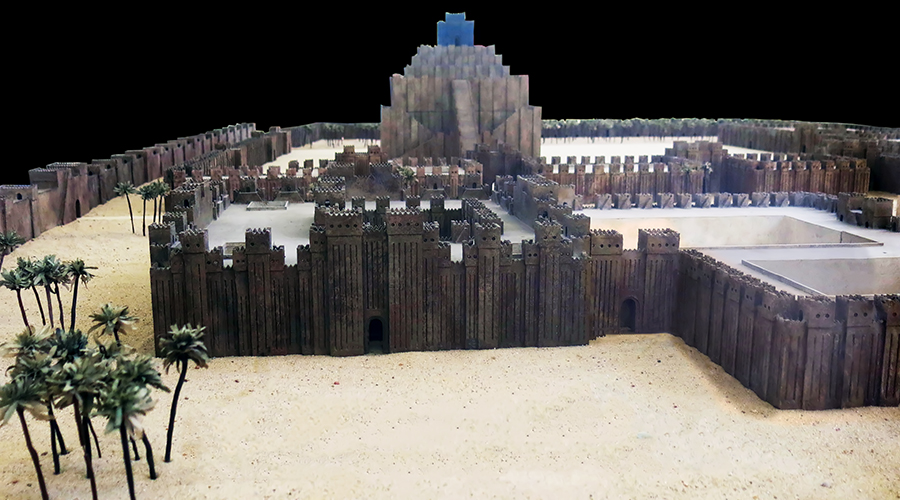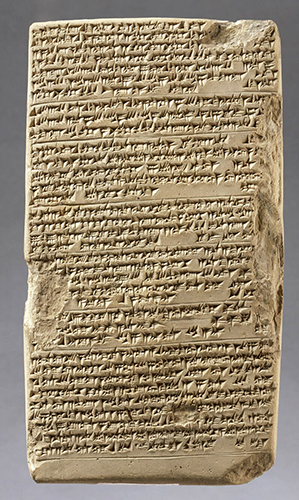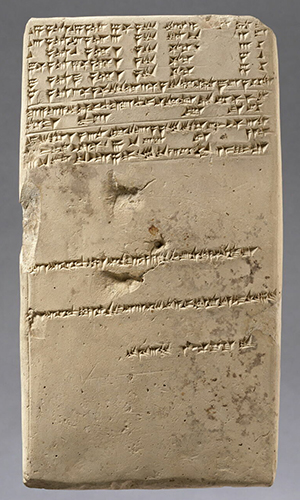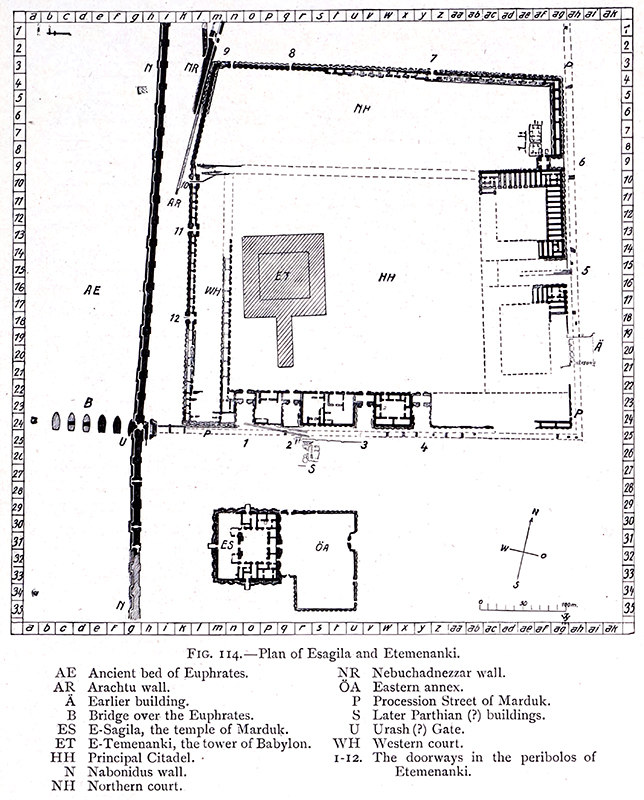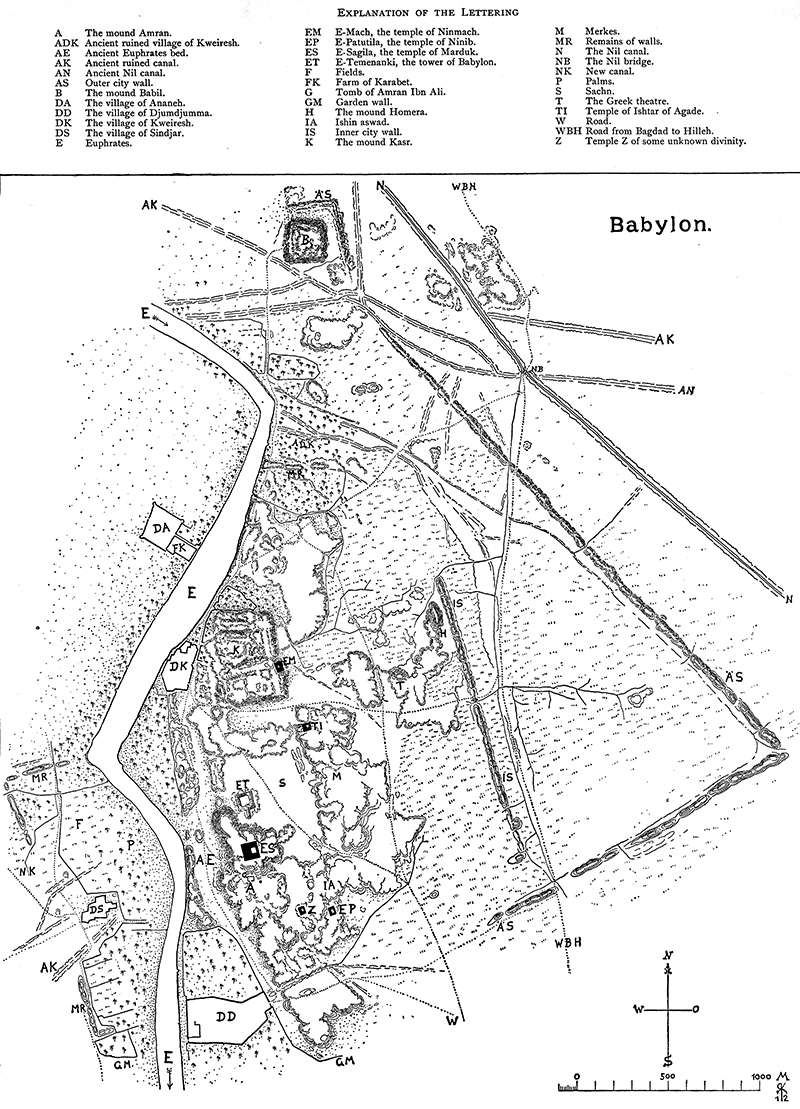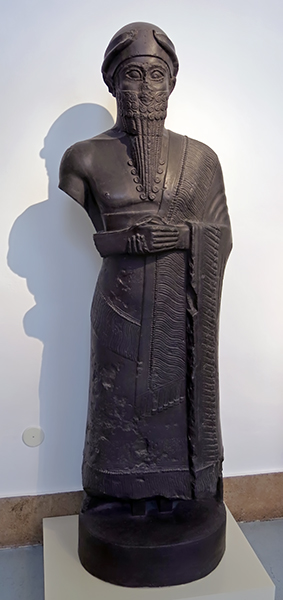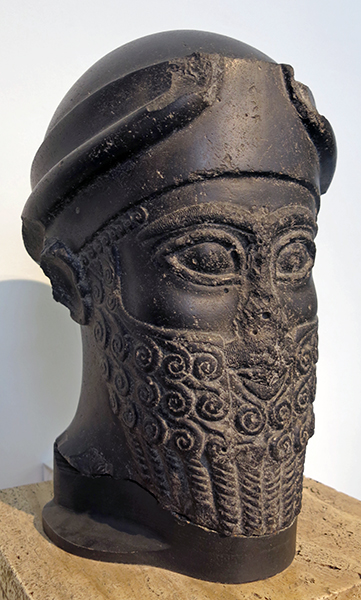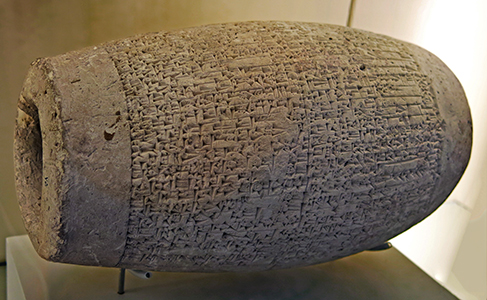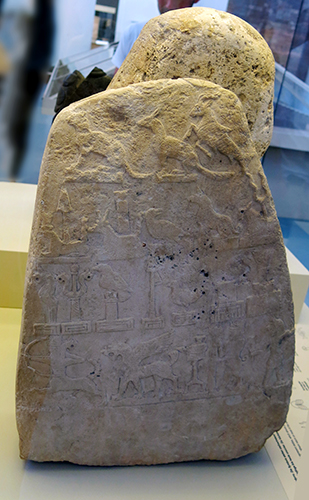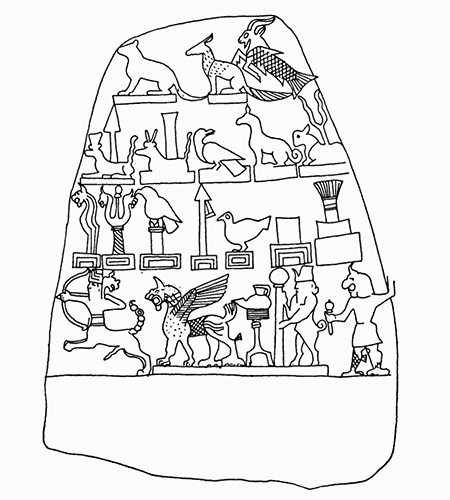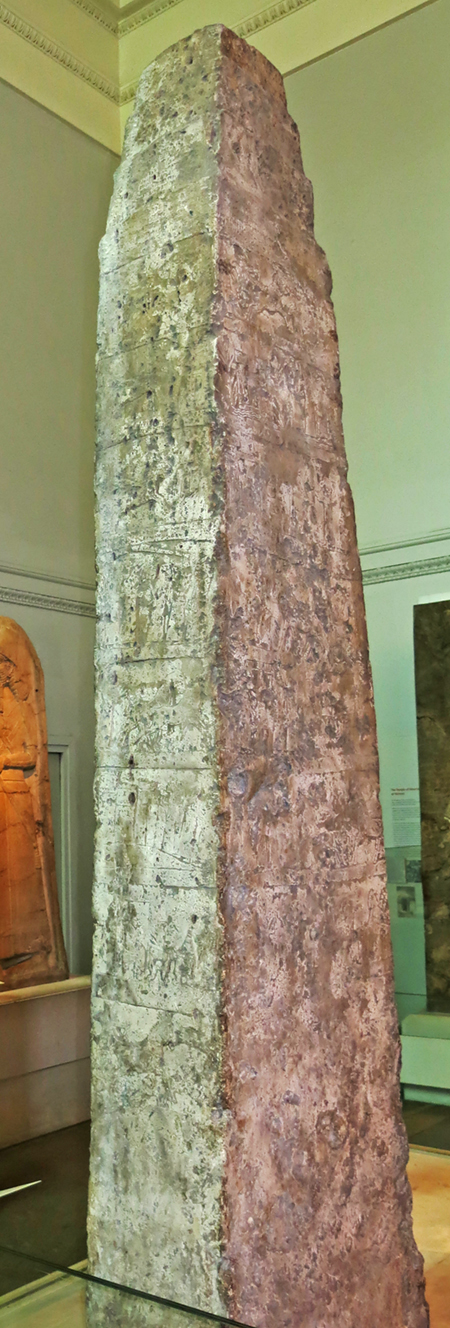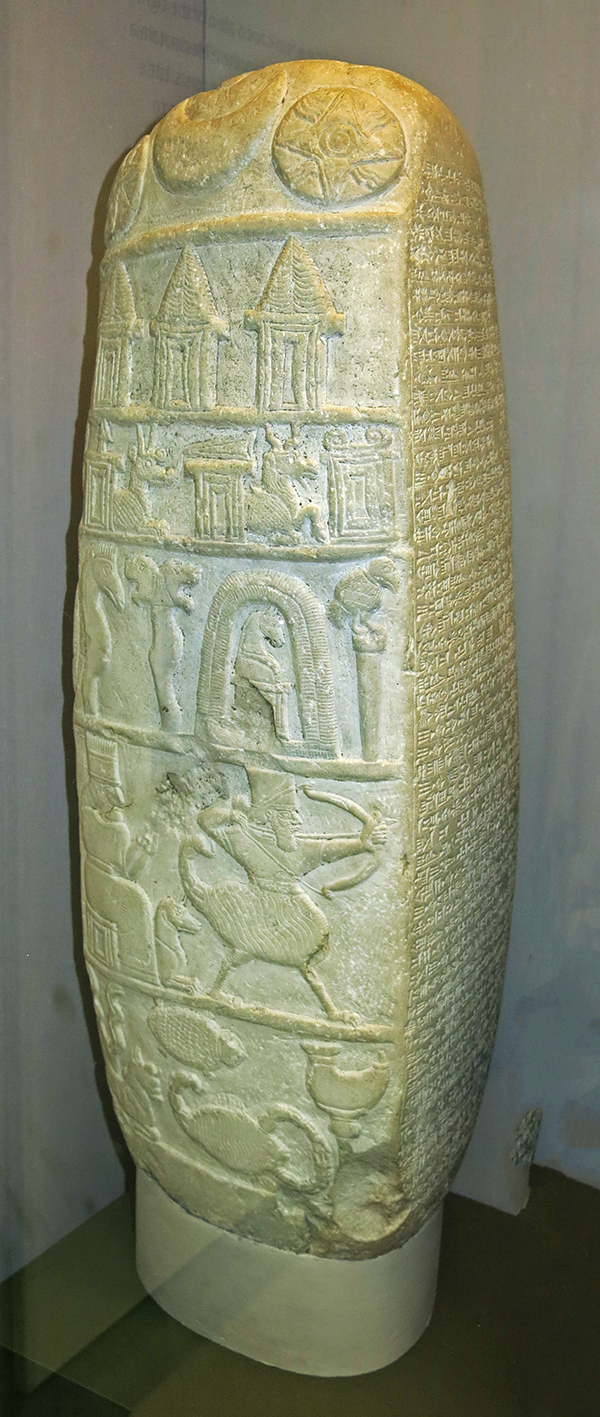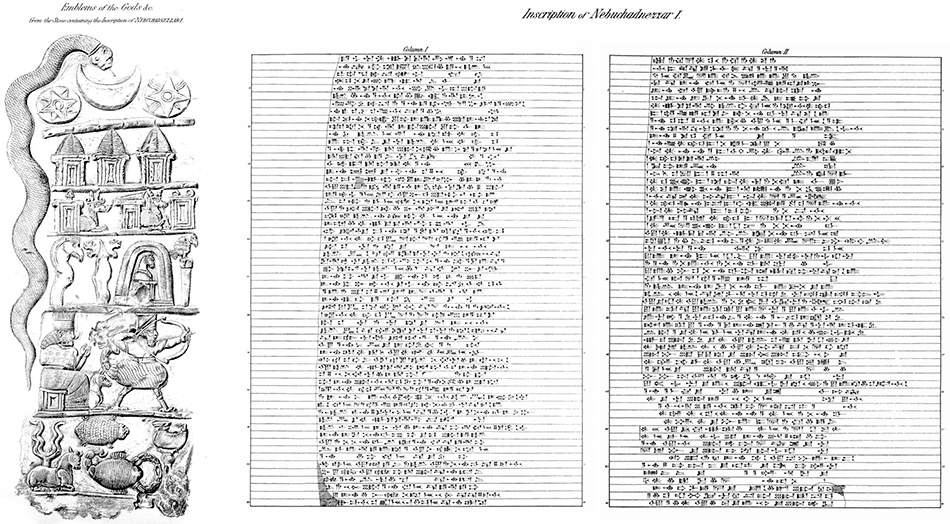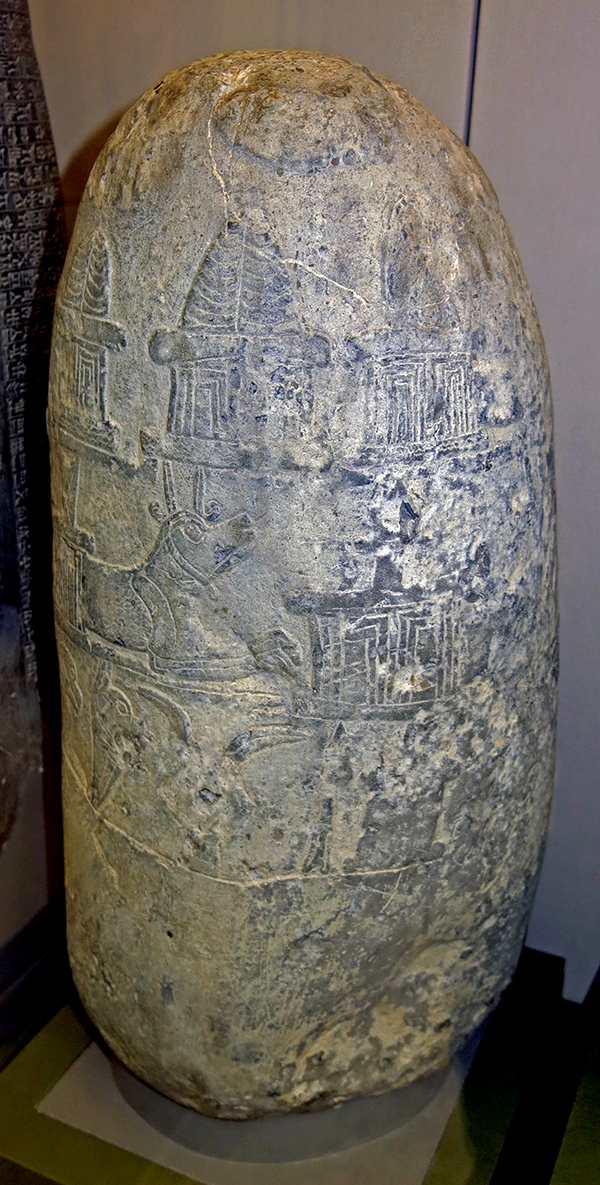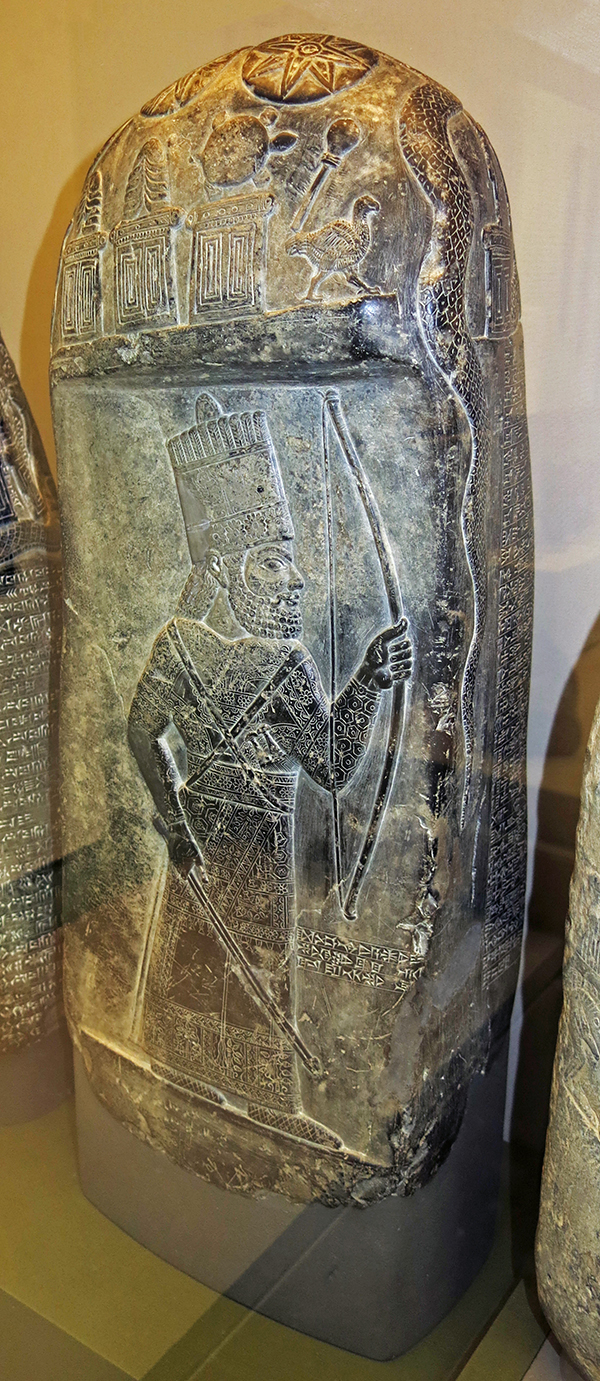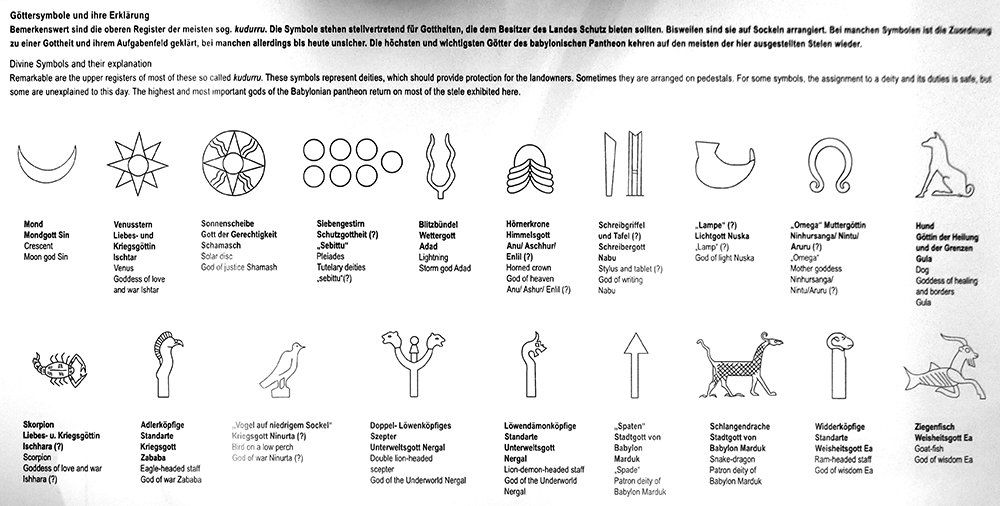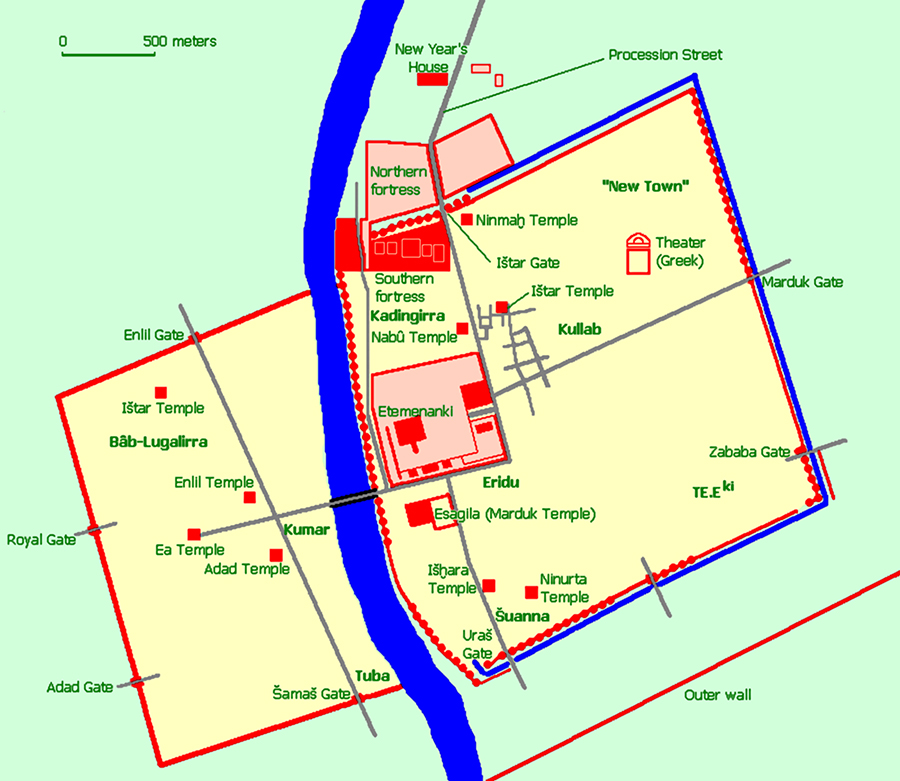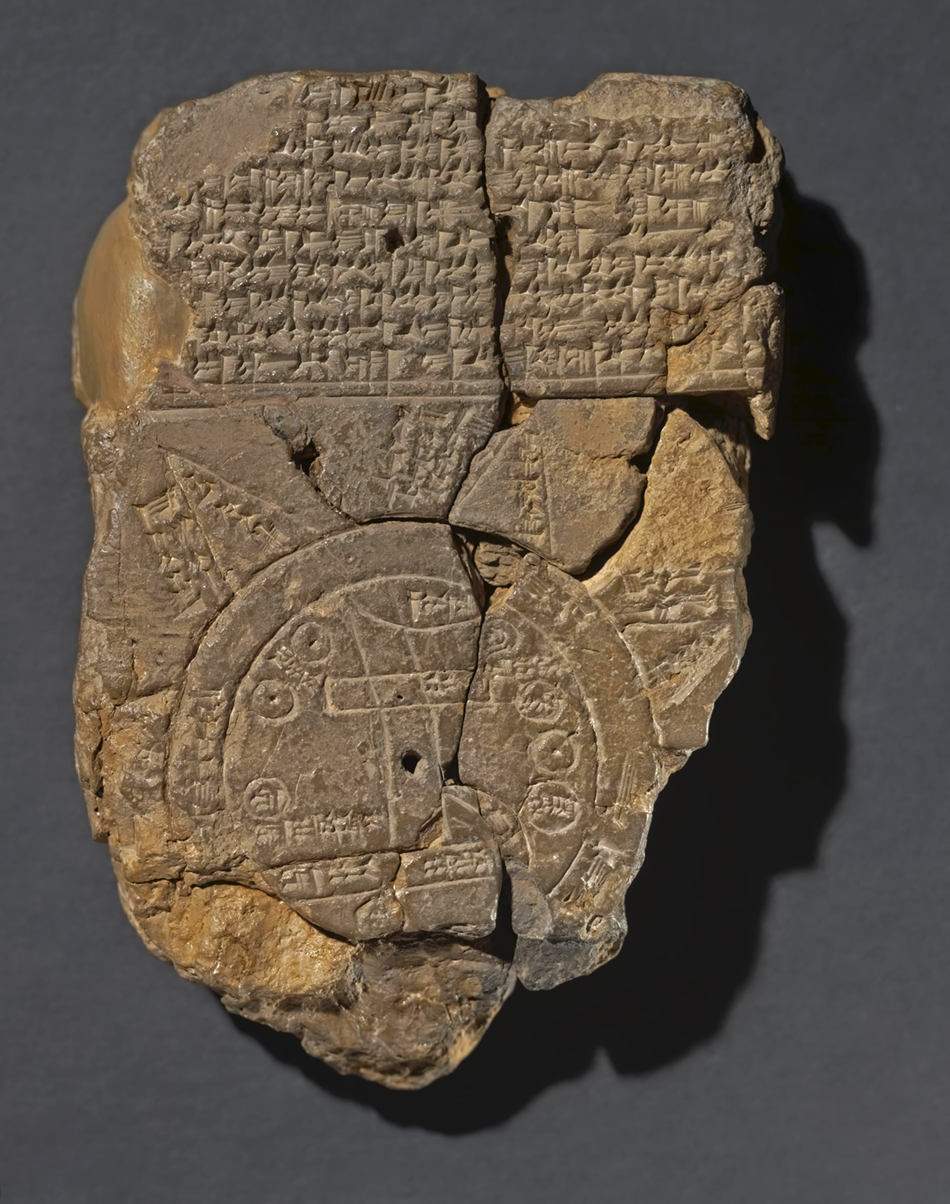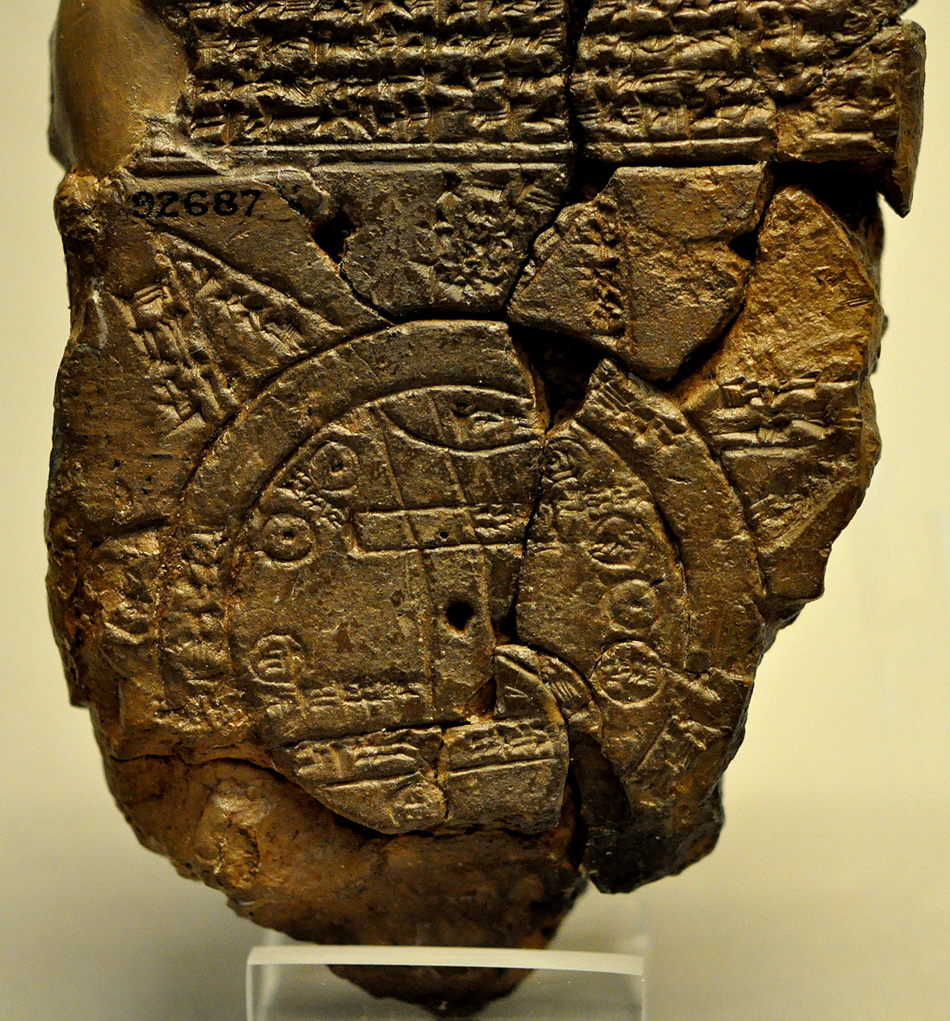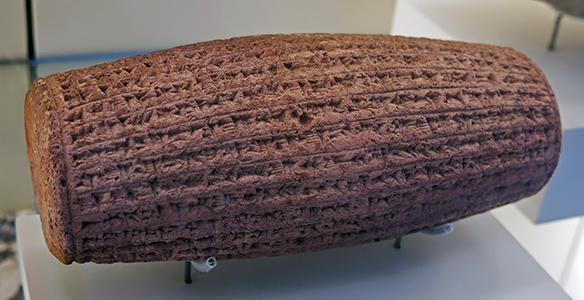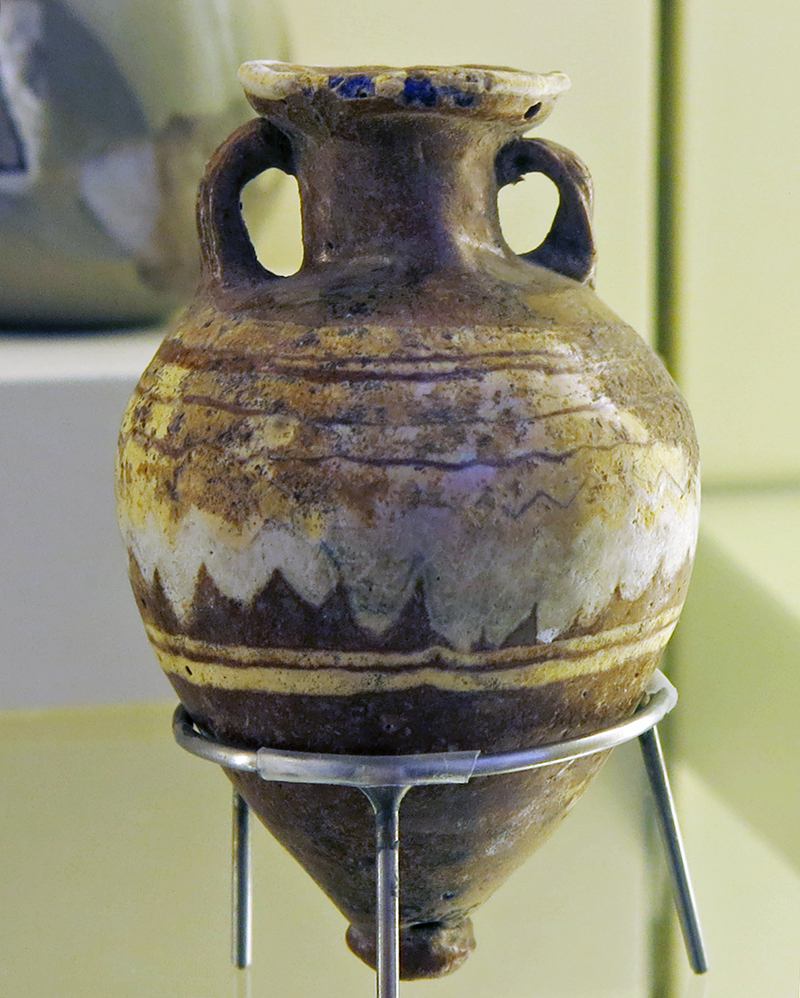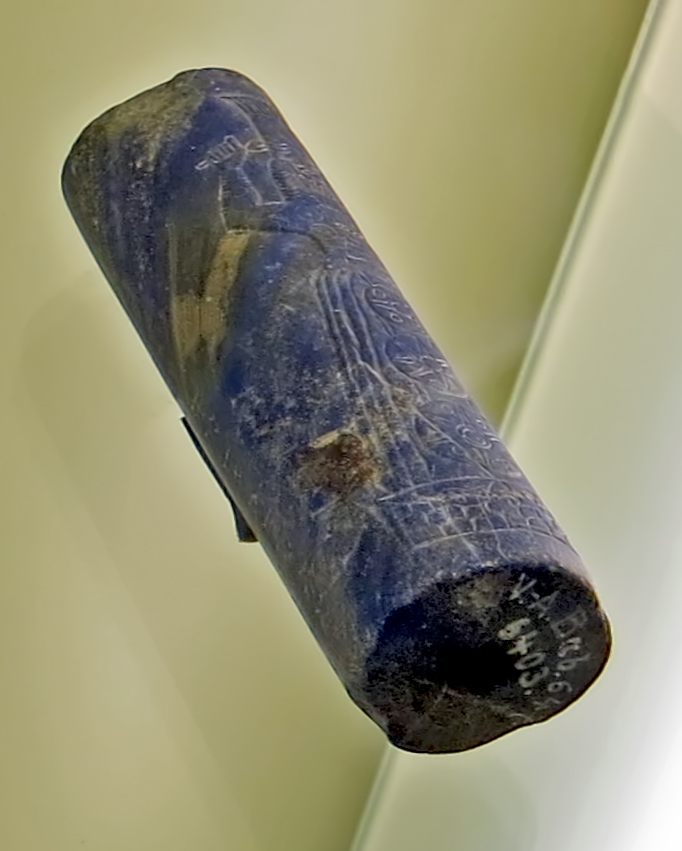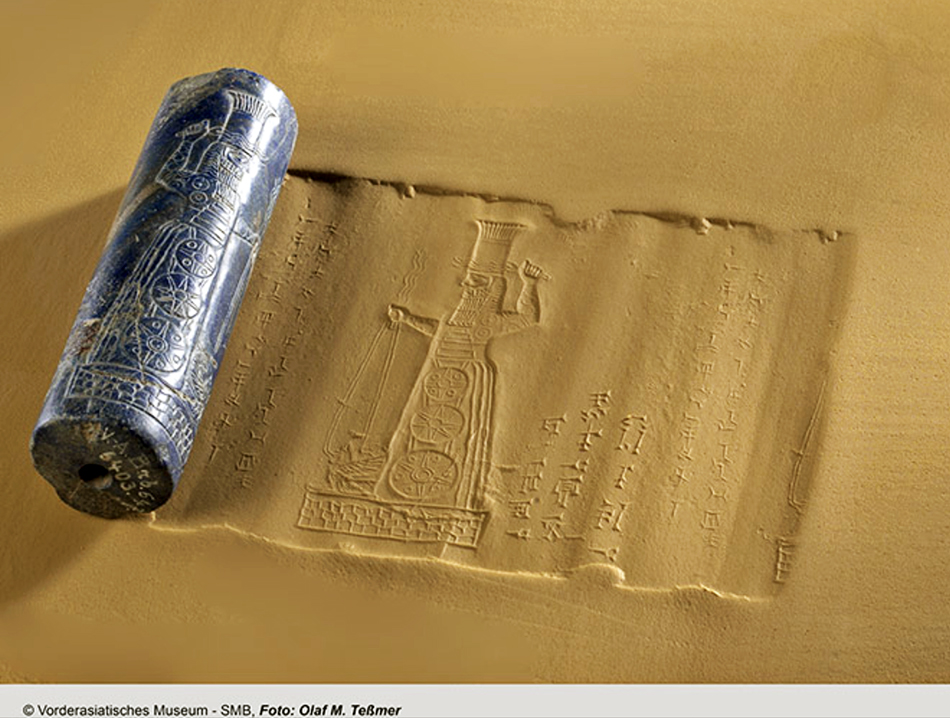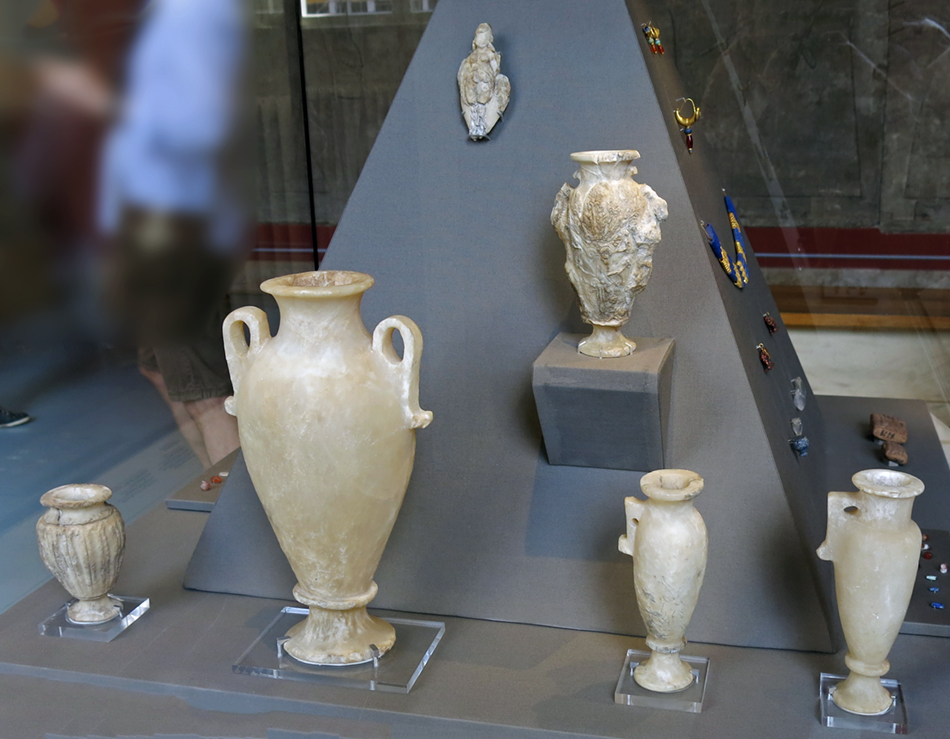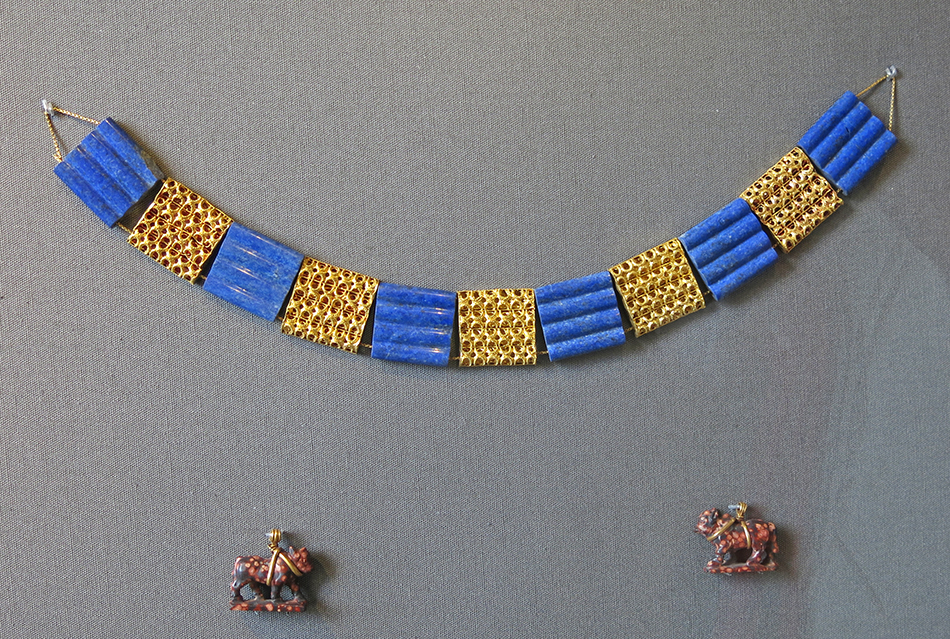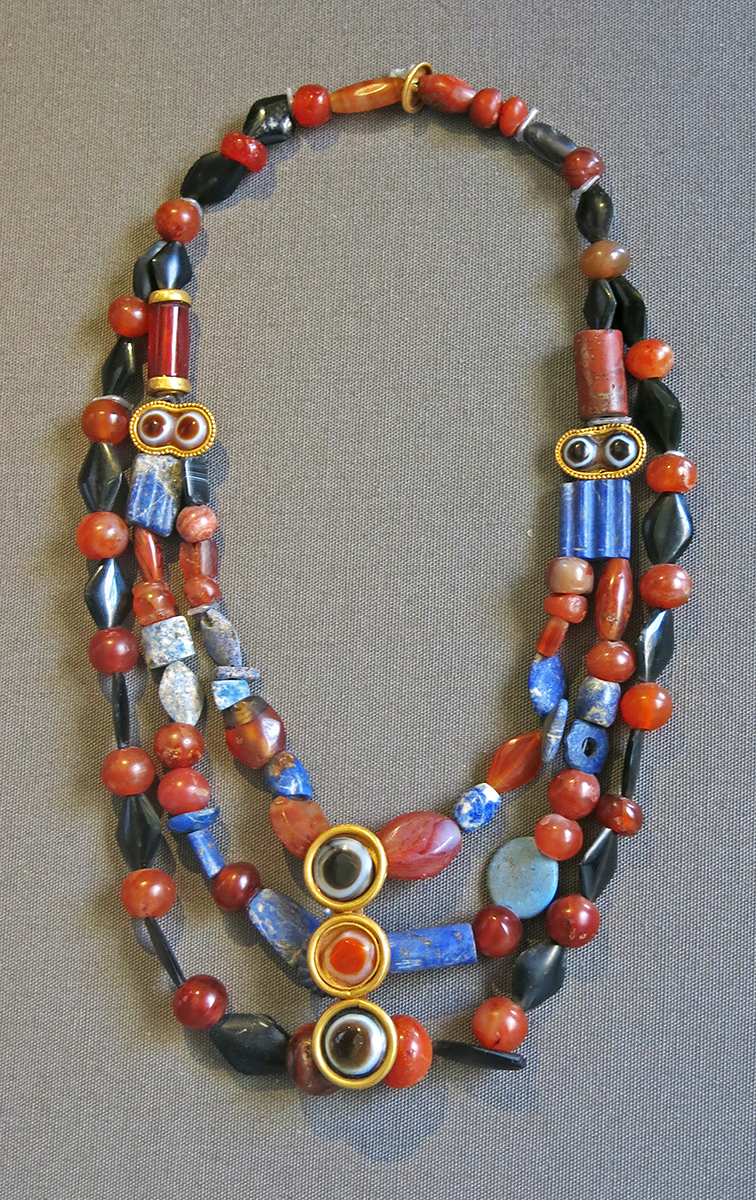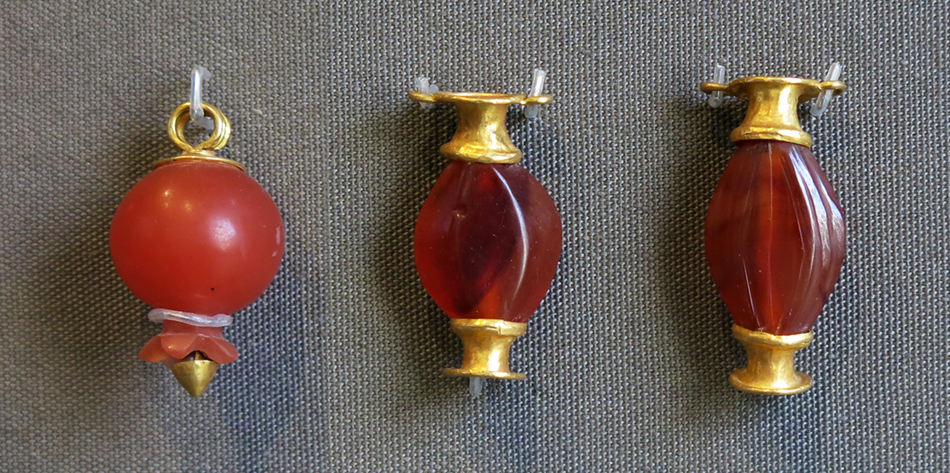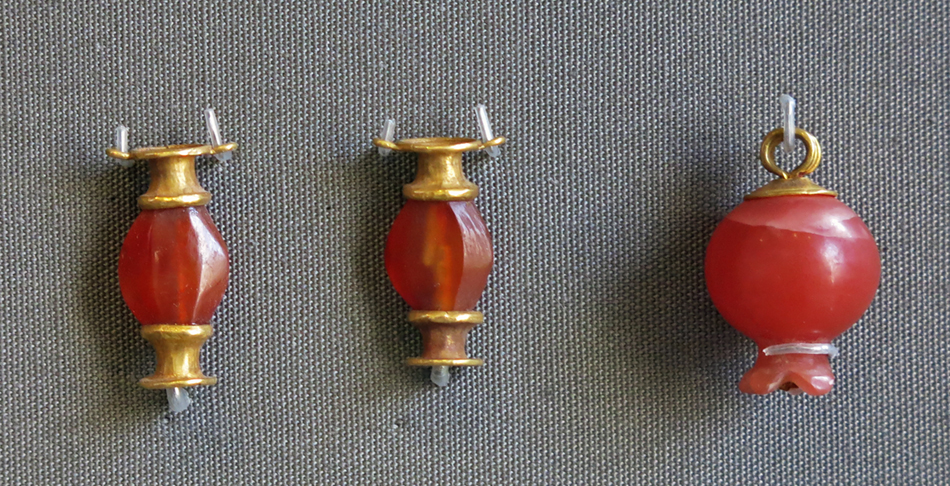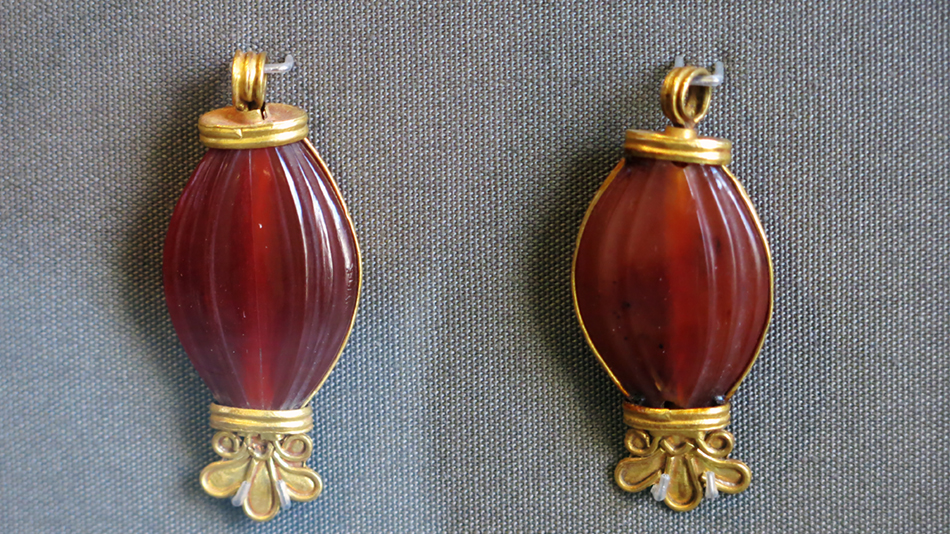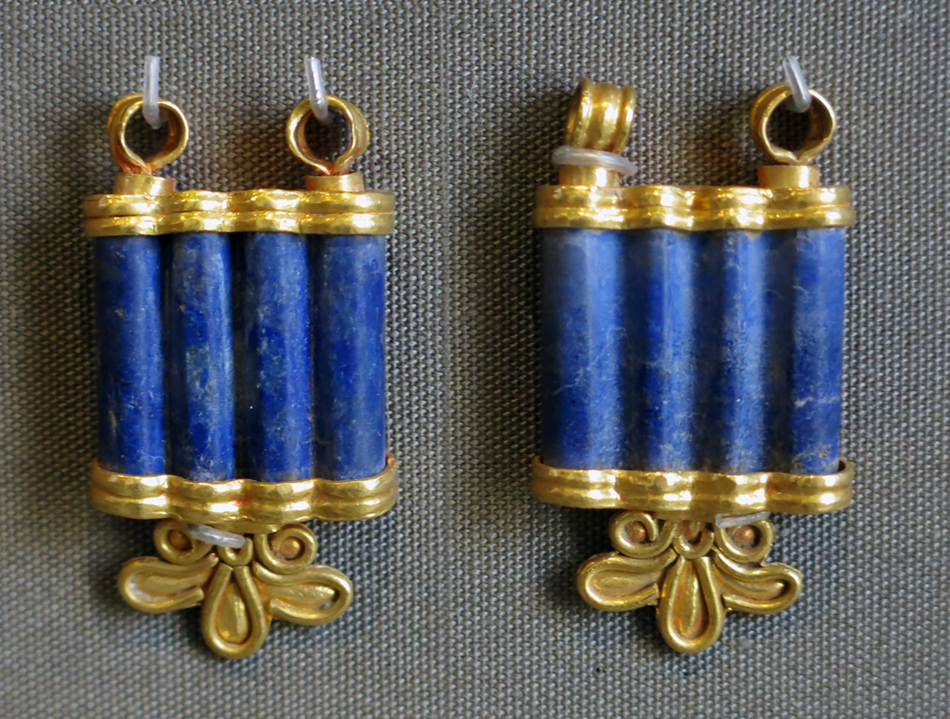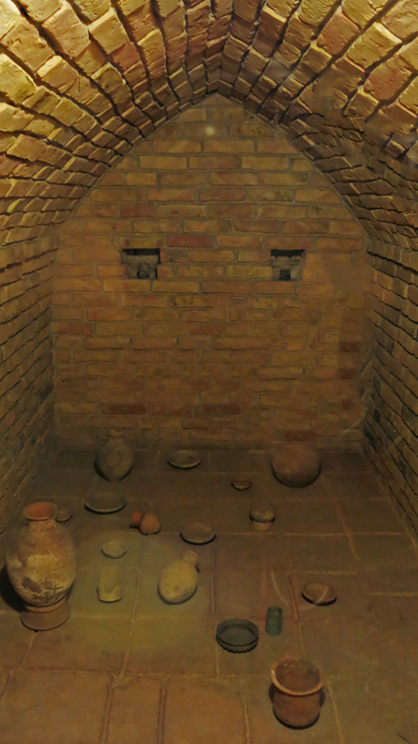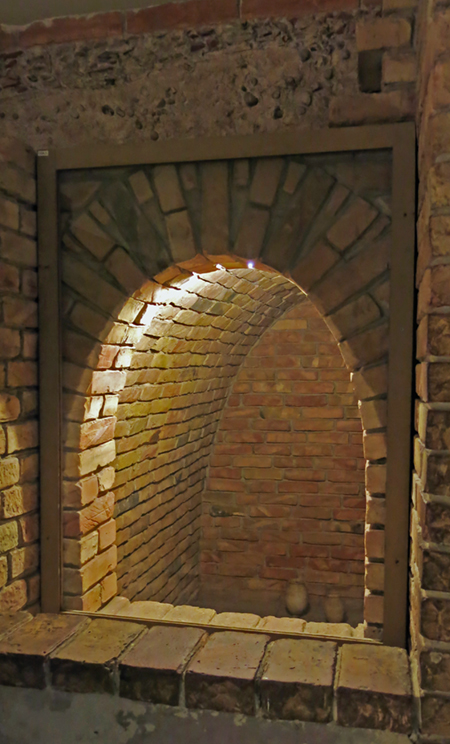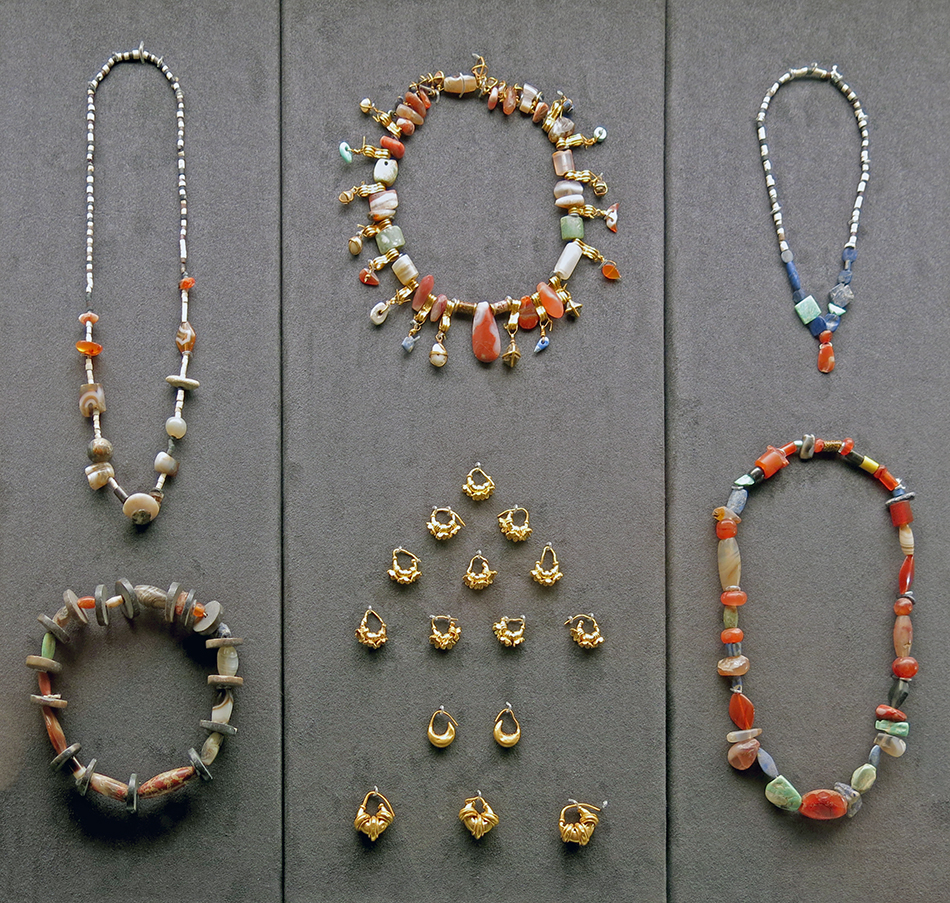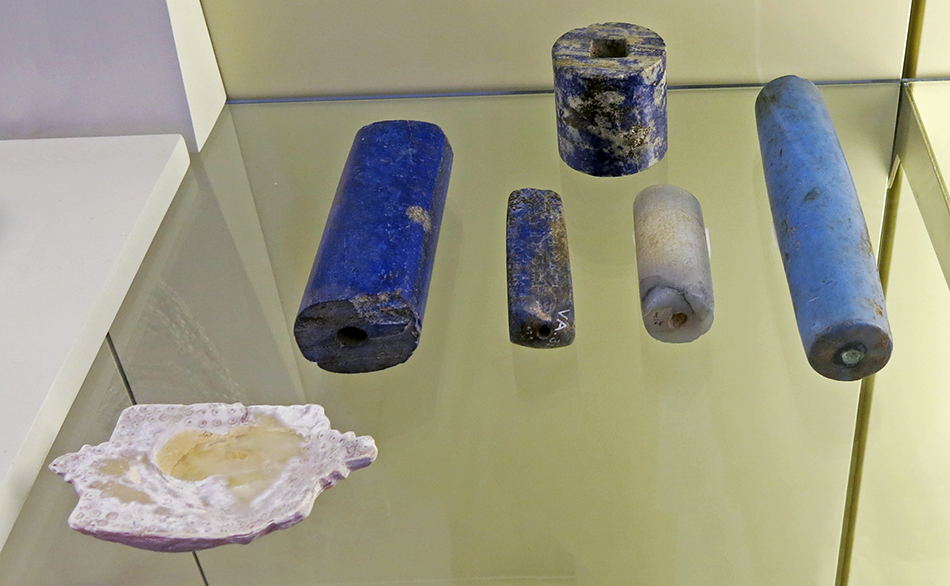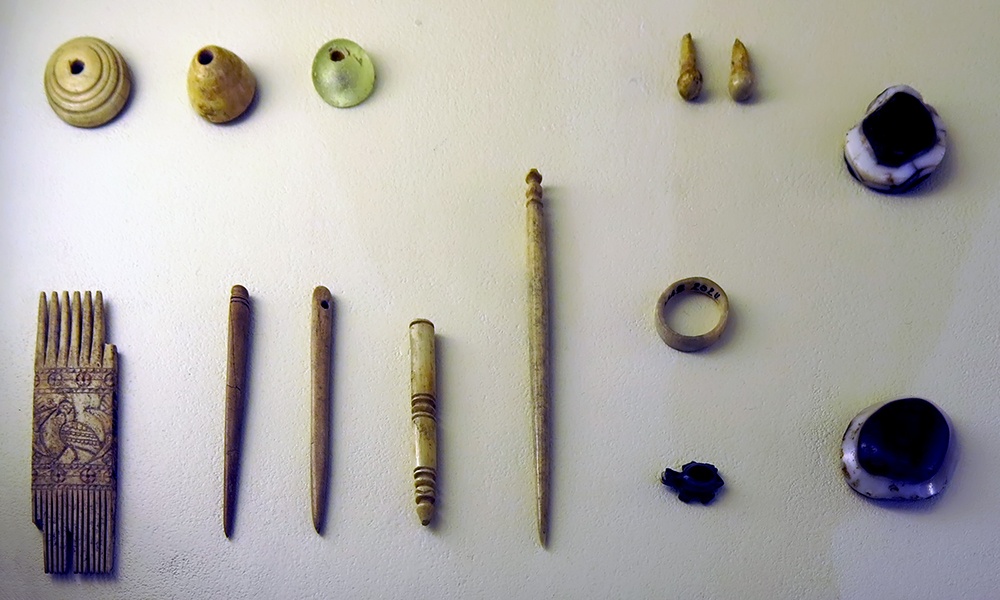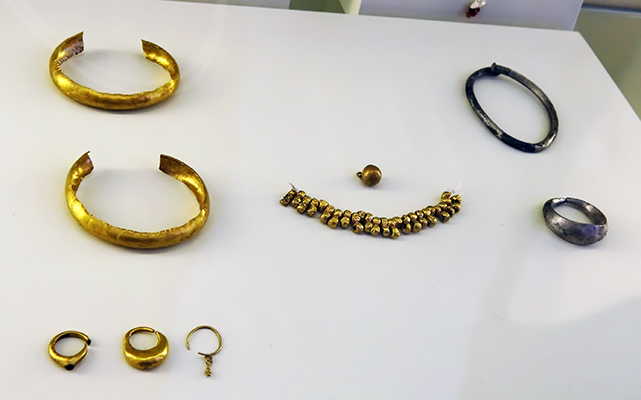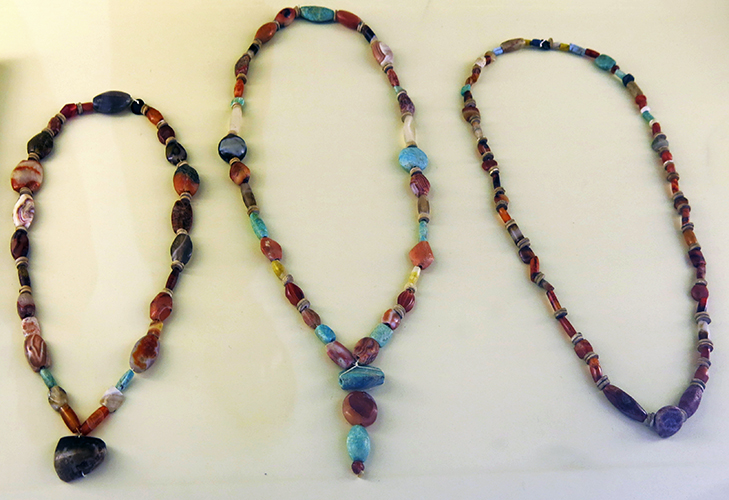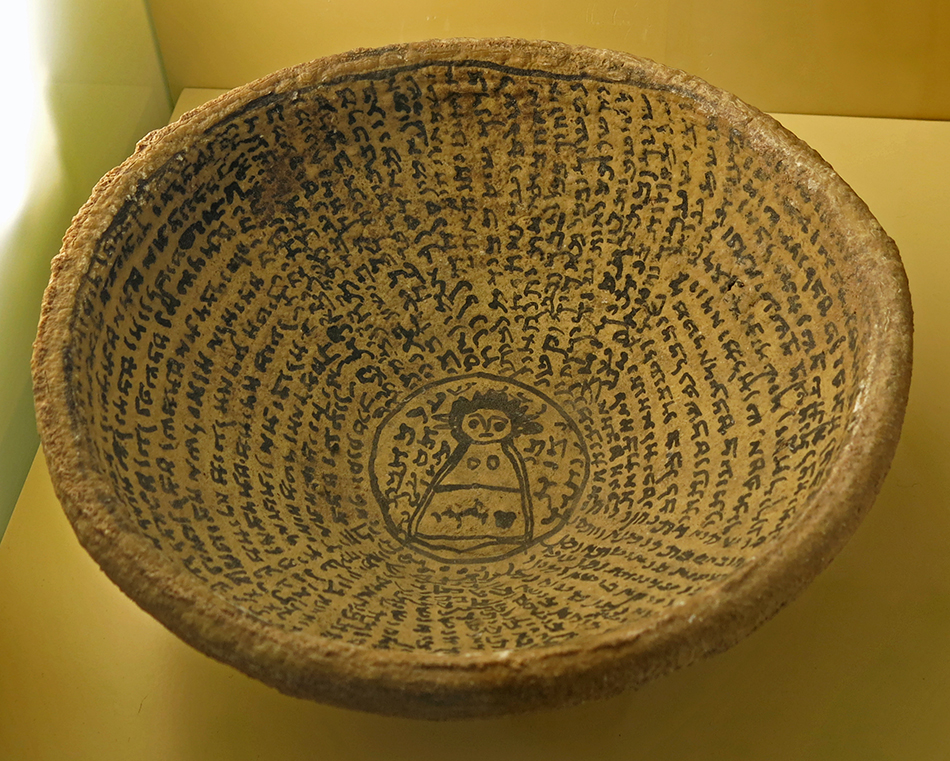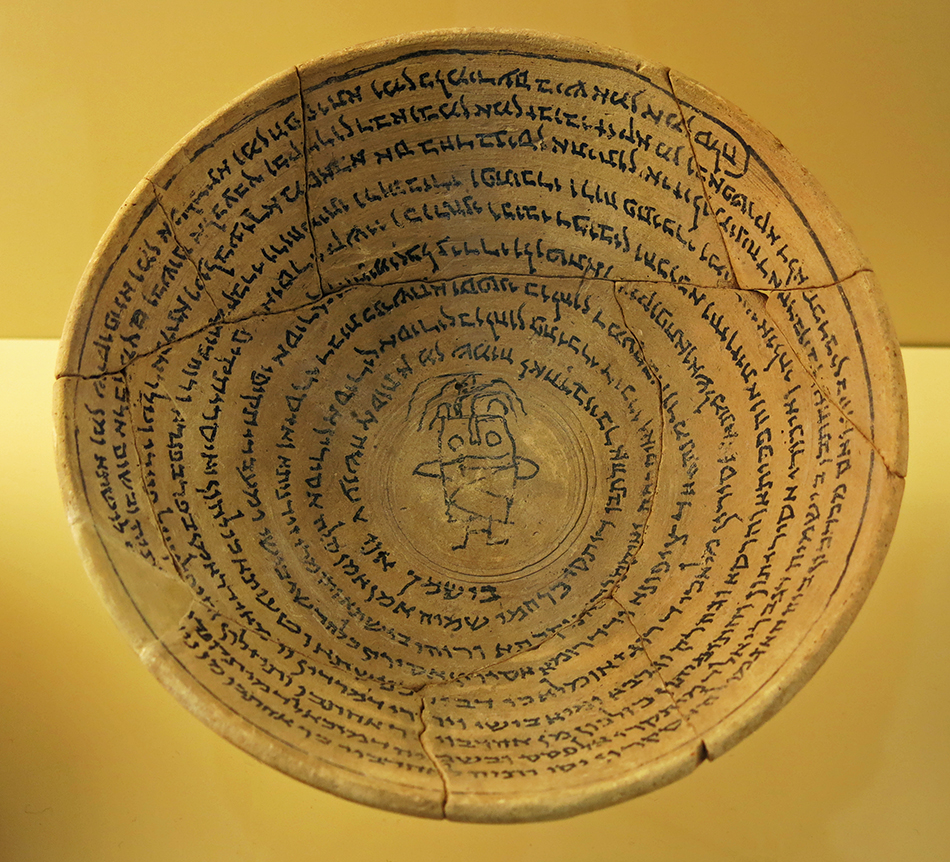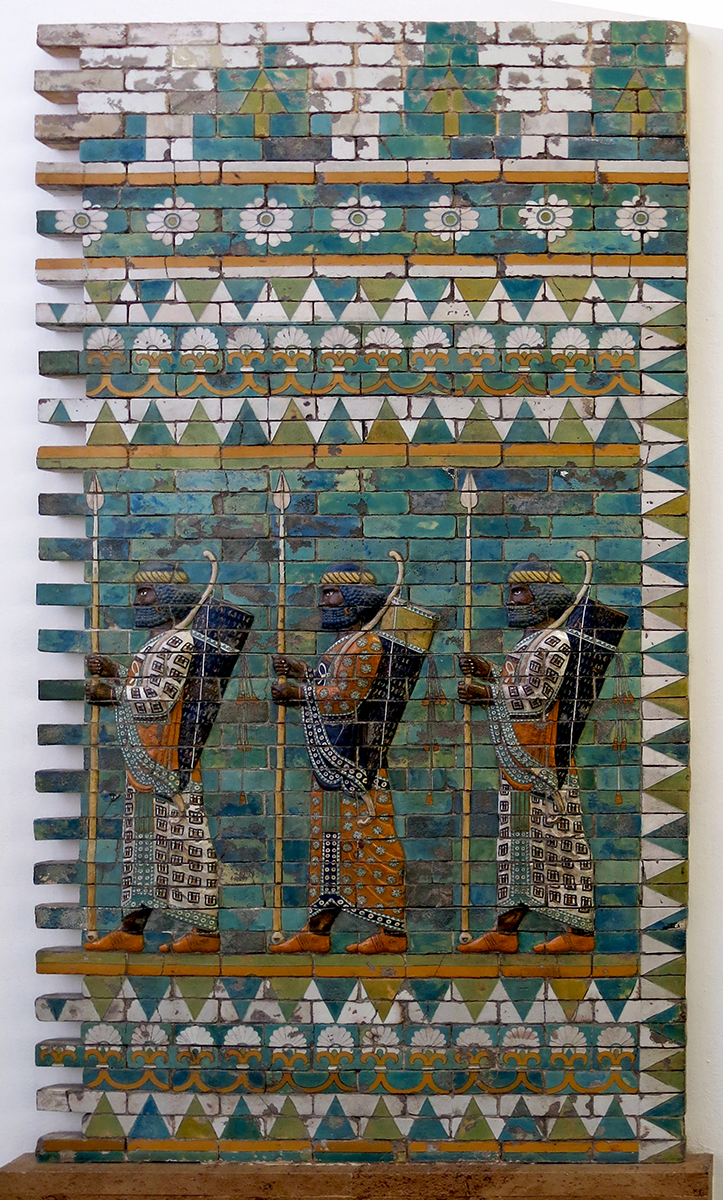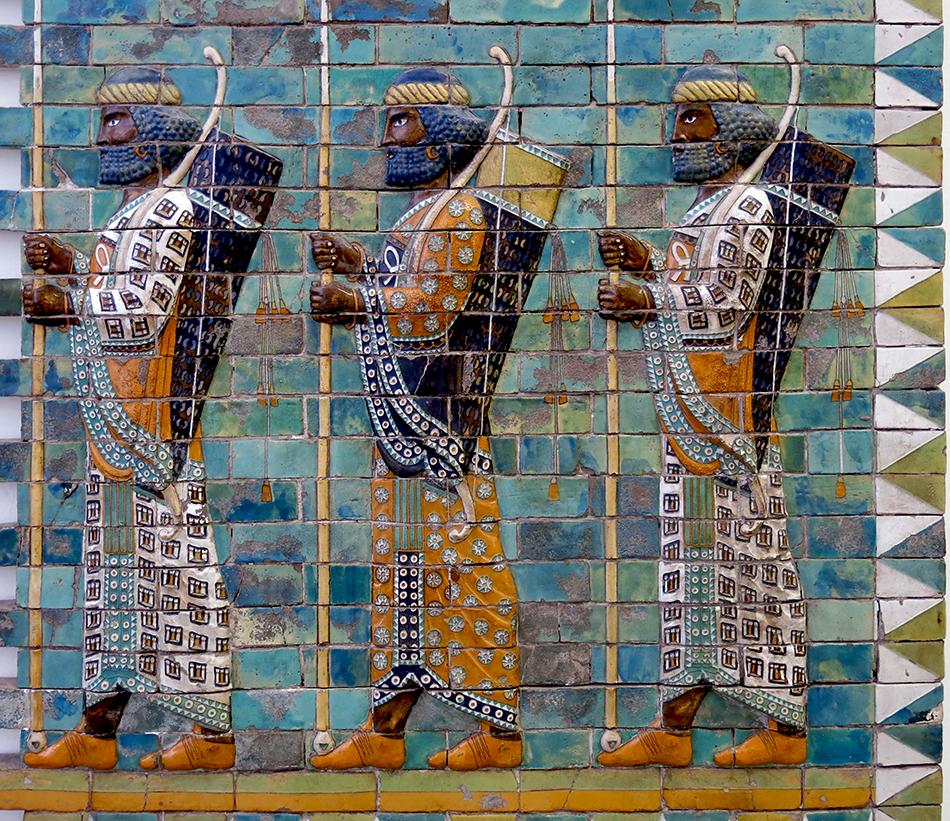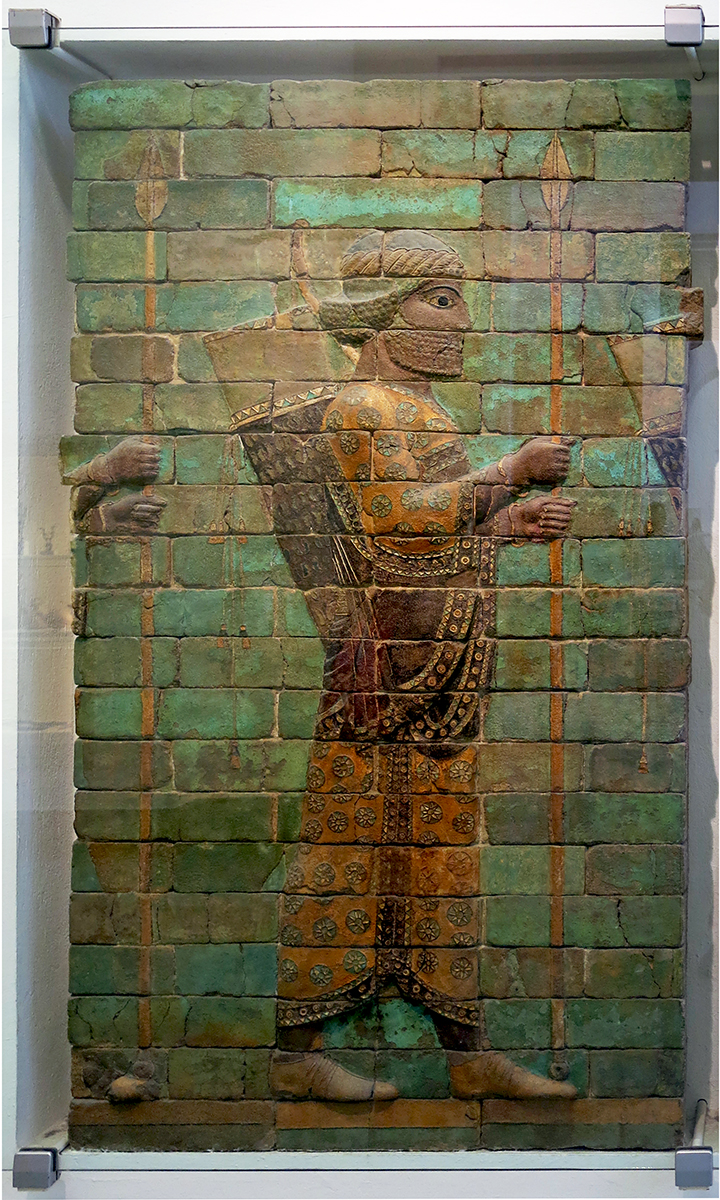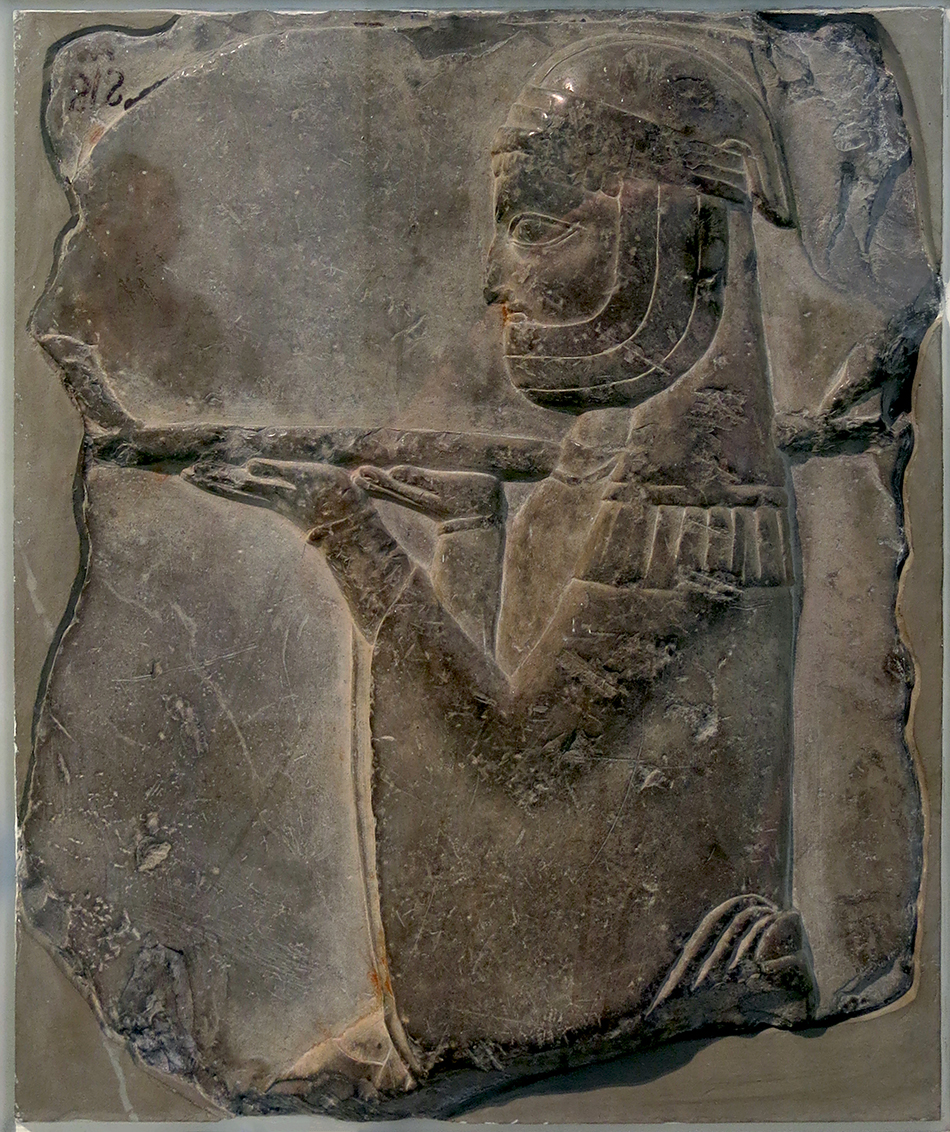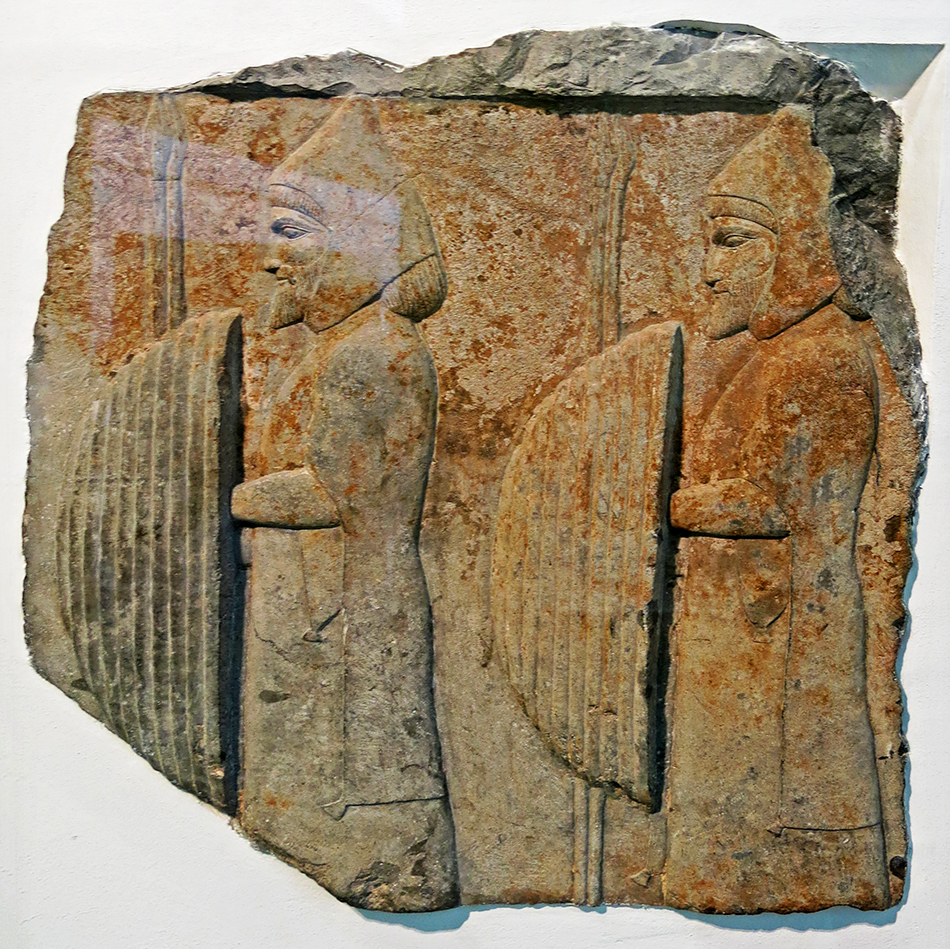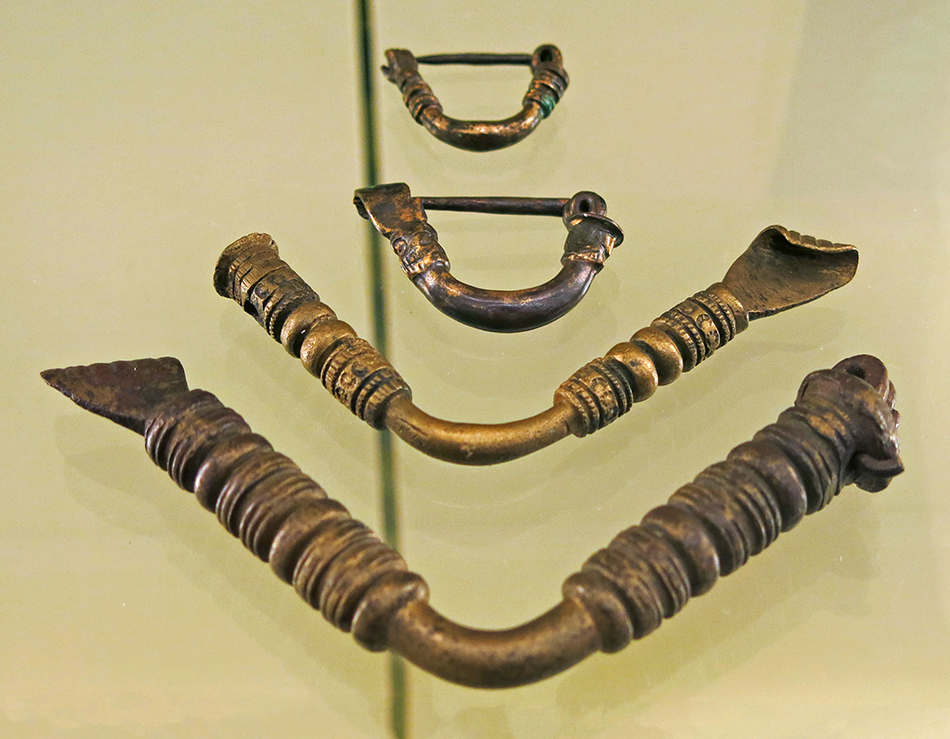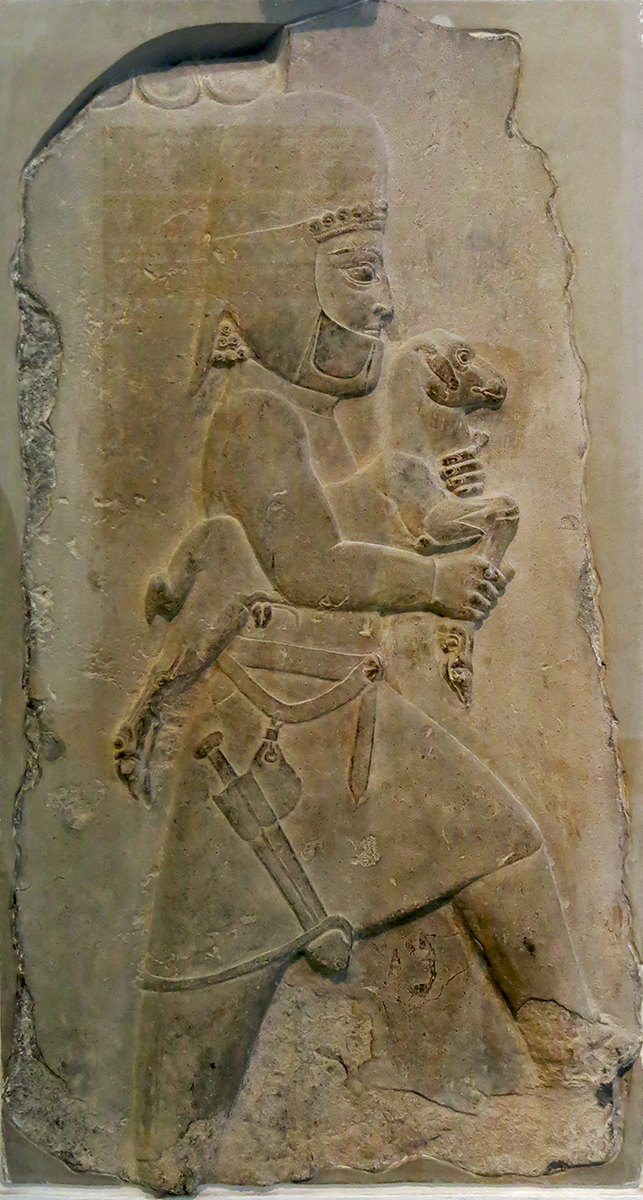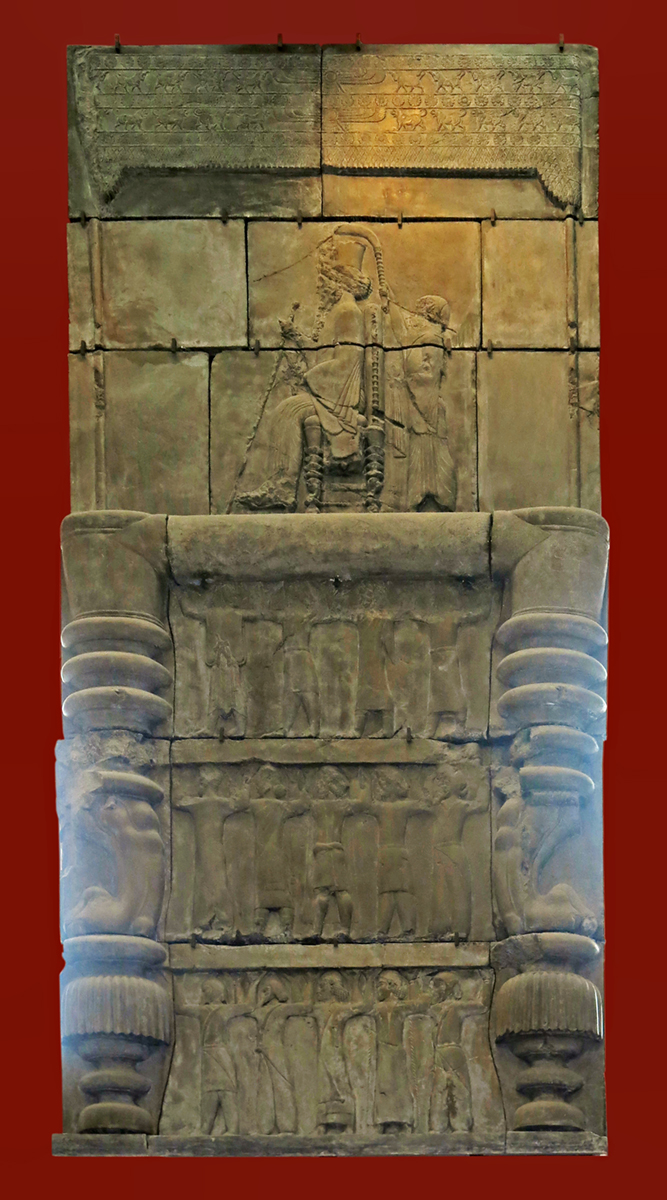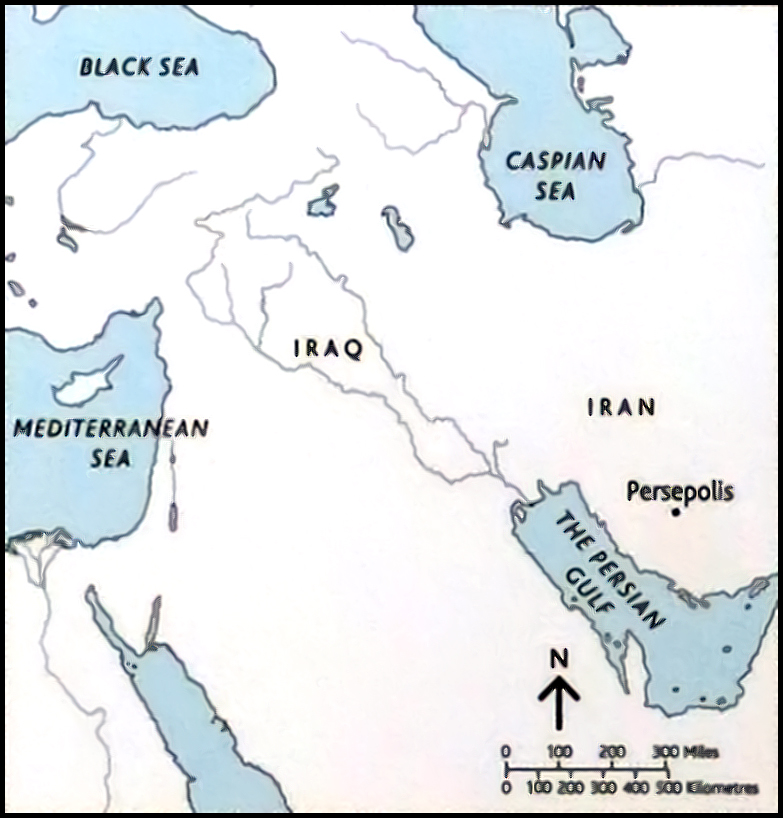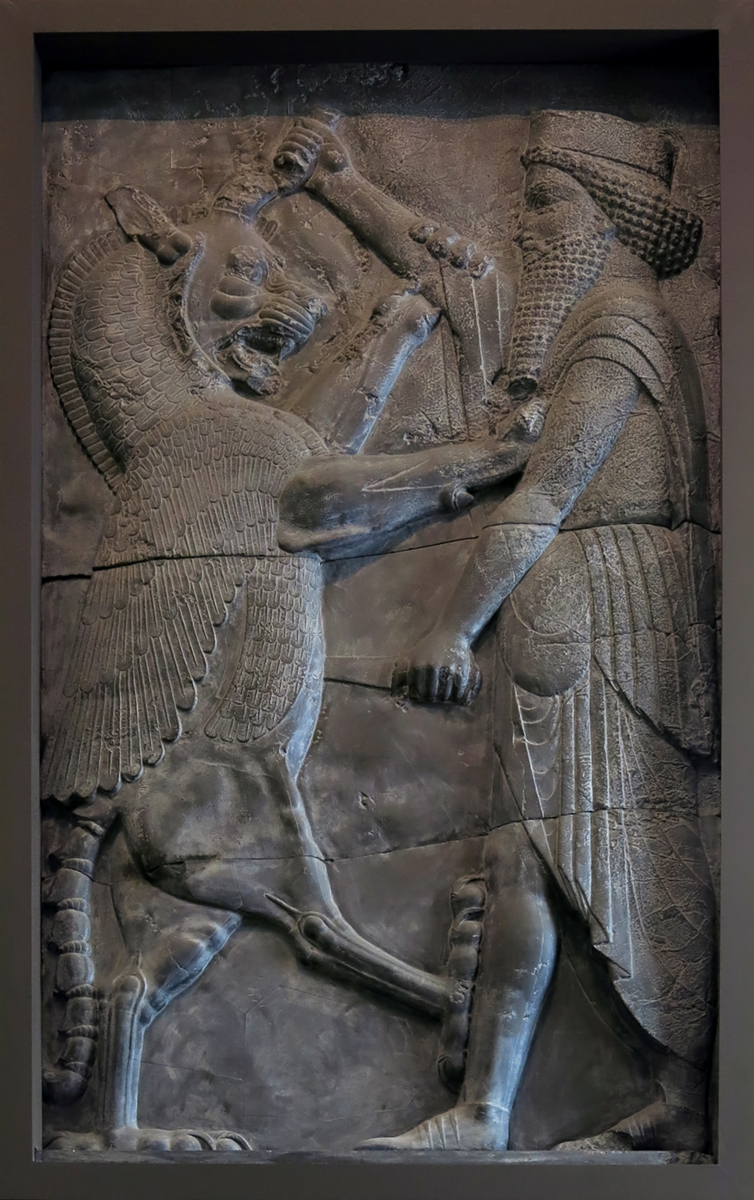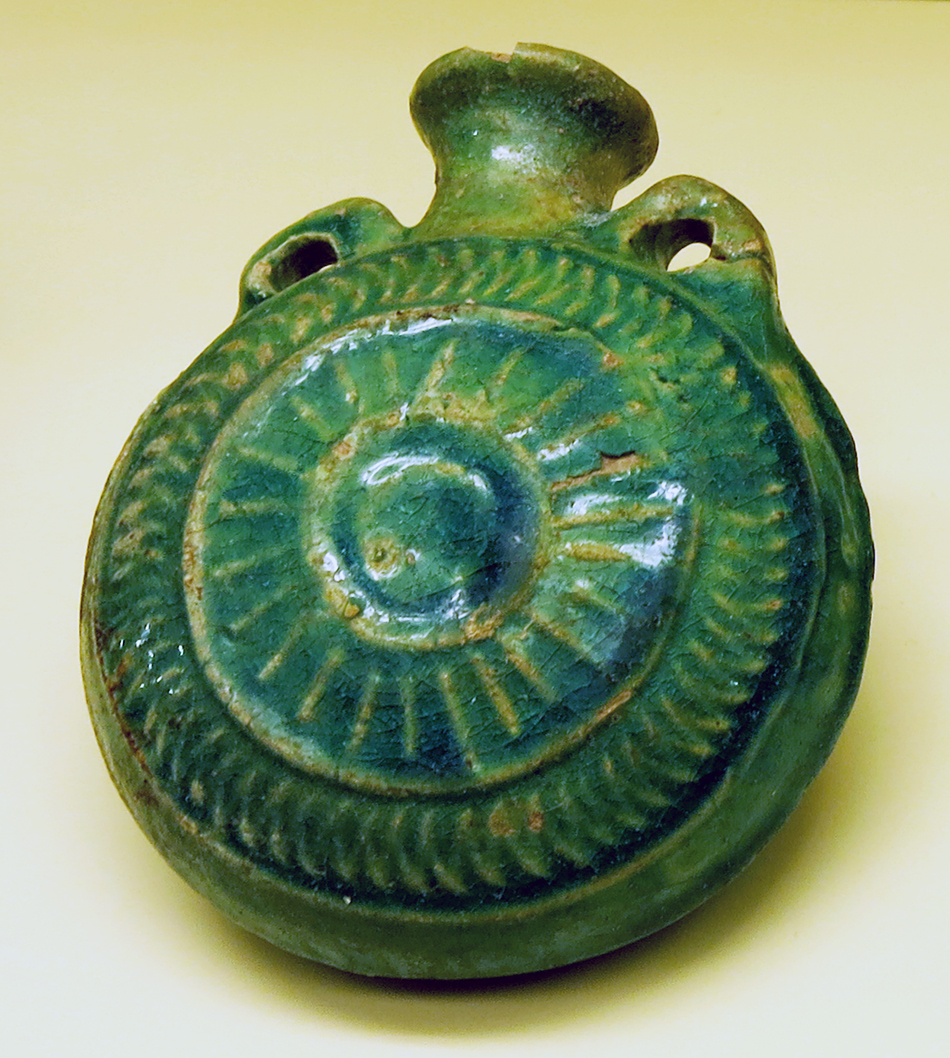Back to Don's Maps
 Back to Archaeological Sites
Back to Archaeological Sites
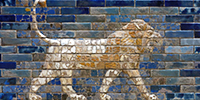 The Ishtar Gate at Babylon
The Ishtar Gate at Babylon
 The Neo-Assyrian Empire
The Neo-Assyrian Empire
Ancient Mesopotamia
Artefacts from Ancient Mesopotamia
The historical region of Mesopotamia included present-day Iraq and parts of present-day Iran, Kuwait, Syria and Turkey
Mesopotamia is the site of the earliest developments of the Neolithic Revolution from around 10 000 BC. It has been identified as having inspired some of the most important developments in human history, including the invention of the wheel, the planting of the first cereal crops, and the development of cursive script, mathematics, astronomy, and agriculture. It is recognised as the cradle of some of the world's earliest civilisations.Sumer is the earliest known civilisation in the historical region of southern Mesopotamia (south-central Iraq), emerging during the Chalcolithic (Copper) and early Bronze Ages between the sixth and fifth millennium BC. It is one of the cradles of civilisation in the world. Living along the valleys of the Tigris and Euphrates rivers, Sumerian farmers grew an abundance of grain and other crops, the surplus from which enabled them to form urban settlements. Proto-writing dates back before 3 000 BC. The earliest texts come from the cities of Uruk and Jemdet Nasr, and date to between 3 500 BC and 3 000 BC.
The Sumerian language was the first to be recorded on clay tablets, with the words being recorded as syllables rather than using an alphabet. Sumerian did not survive, but the cuneiform script was taken up by other groups, and continued to develop after the Sumerians disappeared.
In particular the Assyrians, who used the Akkadian language, also used cuneiform script on clay tablets, and their language formed part of many other languages which either descended from it, or borrowed words from Akkadian.
The Sumerians and Akkadians (including the Assyrians and Babylonians) originating from different areas in present-day Iraq, dominated Mesopotamia from the beginning of written history (circa 3 100 BC) to the fall of Babylon in 539 BC, when it was conquered by the Achaemenid Empire, also known as the First Persian Empire.
The Achaemenid Empire was founded by Cyrus the Great in 550 BC , and stretched from Eastern Macedon, Thrace, Libya and Northern Egypt in the west, to Central Asia and the Indus Valley to the east. It occupied an area of 5.5 million square kilometres, and was the largest empire the world had ever seen up to that time,
Mesopotamia is the site of the earliest developments of the Neolithic Revolution from around 10 000 BC. It has been identified as having inspired some of the most important developments in human history, including the invention of the wheel, the planting of the first cereal crops, and the development of cursive script, mathematics, astronomy, and agriculture. It is recognised as the cradle of some of the world's earliest civilisations.
Text above: adapted from Wikipedia
| Mesopotamian Chronology | ||
|---|---|---|
| Southern Mesopotamia | ||
| Early Dynastic Period | ||
| Gilgamesh of Uruk (legendary) | 2700 BC | |
| Mesanepada of Ur | 2450 BC | |
| Eannatum of Lagash | 2400 BC | |
| Enannatum of Lagash | 2430 BC | |
| Uruinimgina of Lagash | 2350 BC | |
| Lugalzagesi of Uruk | 2350 BC | |
| Dynasty of Akkad (Agade) | ||
| Sargon | 2340 BC - 2285 BC | |
| Rimush | 2384 BC - 2275 BC | |
| Manishtushu | 2275 BC - 2260 BC | |
| Naram-Sin | 2260 BC - 2223 BC | |
| Shar-kali-sharri | 2223 BC - 2198 BC | |
| Dynasty of Lagash | ||
| Gudea | 2150 BC - 2125 BC | |
| Third Dynasty of Ur | ||
| Ur-Nammu | 2112 BC - 2095BC | |
| Shulgi | 2095 BC - 2047 BC | |
| Amar-Sin | 2046 BC - 2068 BC | |
| Naram-Sin | 2260 BC - 2223 BC | |
| Shu-Sin | 2037 BC - 2029 BC | |
| Ibbi-Sin | 2028 BC - 2004 BC | |
| Dynasty of Isin | ||
| Ishbi-Erra | 2017 BC - 1985 BC | |
| Shu-ilishu | 1984 BC - 1975 BC | |
| Iddin-Dagan | 1974 BC - 1954 BC | |
| Lipit-Ishtar | 1934 BC - 1924 BC | |
| Dynasty of Larsa | ||
| Rim-Sin | 1822 BC - 1763 BC | |
| Old Babylonian Dynasty | ||
| Sin-muballit | 1812 BC - 1793 BC | |
| Hammurabi | 1792 BC - 1750 BC | |
| Kassite Dynasty | ||
| Kadashman-Enlil I | 1374 BC - 1360 BC | |
| Burnaburiash II | 1359 BC - 1333 BC | |
| Kurigalzu II | 1332 BC - 1308 BC | |
| Babylonian Dynasty | ||
| Nabu-mukin-zeri | 731 BC - 729 BC | |
| Marduk-apla-iddina II | 721 BC - 710 BC | |
| Shamash-shum-ukin | 667 BC - 648 BC | |
| Neo-Babylonian Dynasty | ||
| Nabopolassar | 625 BC - 605 BC | |
| Nebuchadnezzar II | 604 BC - 562 BC | |
| Amel-Marduk | 561 BC - 560 BC | |
| Neriglissar | 559 BC - 556 BC | |
| Labashi-Marduk | 556 BC | |
| Nabonidus | 555 BC - 539 BC | |
| Northern Mesopotamia | ||
| Old Assyrian Dynasty | ||
| Shamshi-Adad | 1831 BC - 1781 BC | |
| Dynasty of Mari | ||
| Zimri-Lim | 1775 BC | |
| Neo-Assyrian Dynasty | ||
| Ashurnasirpal II | 883 BC - 859 BC | |
| Shalmaneser III | 858 BC - 824 BC | |
| Shamshi-Adad V | 823 BC - 811 BC | |
| Adad-nirari III | 810 BC - 783 BC | |
| Shalmaneser IV | 782 BC - 773 BC | |
| Ashur-dan III | 772 BC - 755 BC | |
| Ashur-nirari V | 754 BC - 745 BC | |
| Tiglath-pileser III | 745 BC - 727 BC | |
| Shalmaneser V | 726 BC - 722 BC | |
| Sargon II | 721 BC - 705 BC | |
| Sennacherib | 704 BC - 681 BC | |
| Esarhaddon | 680 BC - 669 BC | |
| Ashurbanipal | 668 BC - 627 BC | |
| Ashur-etel-ilani | 626 BC - 623 BC | |
| Sin-shar-ishkun | 622 BC - 612 BC | |
| Ashur-uballit II | 611 BC - 609 BC | |
| Mesopotamia United | ||
| Achaemenid Persian Dynasty | ||
| Cyrus II the Great | 559 BC - 530 BC | |
| Cambyses II | 530 BC - 522 BC | |
| Darius I | 521 BC - 486 BC | |
| Xerxes | 486 BC - 465 BC | |
| Artaxerxes I | 465 BC - 424 BC | |
| Darius II | 423 BC - 405 BC | |
| Artaxerxes II | 405 BC - 359 BC | |
| Artaxerxes III | 358 BC - 338 BC | |
| Artaxerxes IV | 338 BC - 336 BC | |
| Darius III | 336 BC - 330 BC | |
Adapted from the Met Museum, Department of Ancient Near Eastern Art
© 2000–2020 The Metropolitan Museum of Art
Map of Mesopotamia, circa 1 200 BC.
This date of 1 200 BC corresponds to the start of the Late Bronze Age Collapse, when the Hittite Empire of Anatolia and the Levant (shown as Hatti on this map) collapsed, while states such as the Middle Assyrian Empire in Mesopotamia and the New Kingdom of Egypt survived but were weakened.
Note that the large area coloured in blue was under water in 1200 BC, part of the Persian Gulf at that time. Siltation from the Tigris/Euphrates created the modern coastline.
Ur was originally a major port on the Euphrates, very close to the Persian Gulf, which extended much farther inland than today, and the city controlled much of the trade into Mesopotamia. At around 2 100 BC, when it was at its height, it was home to perhaps 12 000 people. It is the traditional birthplace of Abraham, patriarch of Christianity, Judaism and Islam. Imports to Ur came from many parts of the world: precious metals such as gold and silver, and semi-precious stones, namely lapis lazuli and carnelian. By the time of Cyrus the Great it was already decadent, and the changing course of the Euphrates sealed its fate. Without irrigation the previously fertile fields became desert, and by 400 BC it was abandoned.
The Elamites (in modern-day Iran, approximately equivalent to the modern region of Khūzestān) were important neighbours to both Babylonia and Assyria in the Bronze Age.
Ancient Sumer, extant from 6 000 BC to 1 750 BC, lay between the Tigris and Euphrates Rivers, and stretched from Kish (Kiš) to Ur. Kiš was 25 km from the site of Babylon. Babylon was established around 1 200 BC as a small religious and cultural centre.
Photo: FDRMRZUSA
Permission: Creative Commons Attribution-Share Alike 4.0 International license.
Proximate source: Wikimedia
Text: Don Hitchcock, Wikipedia, factsanddetails.com
A more detailed map of Mesopotamia.
( As always, click on the small thumbnail above to see the full size image - Don )
Source: sites.google.com/a/umich.edu/imladjov/maps
Map © Ian Mladjov
Permission: Courtesy Ian Mladjov
Map of Mesopotamia below Babylon, showing the changing coastline between 2 000 BC and 1 850 AD in the Persian/Arabian Gulf as a result of deposition of silt from the Tigris-Euphrates river system.
Photo: Varoujan et al. (2020)
This is a useful timeline for the development of Mesopotamian cultures:
www.faculty.umb.edu/gary_zabel/Courses/Phil%20281b/Philosophy%20of%20Magic/Dante.%20etc/Philosophers/Idea/www.wsu.edu_8080/~dee/MESO/TIMELINE.HTM
Sumer
The region which eventually became Sumer was the site of the first civilisation in the history of the world.
Sumer, in Mesopotamia, was mostly between, or within reach of, the lower reaches of the two rivers, the Euphrates and the Tigris, and was the first fully fledged civilisation in both greater Mesopotamia, and the world.
Before that, all we had was hunter gatherers, all over the inhabited world. It is important to realise what civilisation was replacing, and how that happened.
Hunter gatherers practised various forms of birth control in order to keep their numbers low, with a good margin if conditions got bad for food gathering - both hunting and gathering of vegetable matter.
This is why, if you look at the human population from the time of the first humans, it is a flat line until the rise of the planting and harvesting of crops.
This is in marked contrast to the numbers of predators/carnivores and their prey. One example is shown here:
The wolves and moose of Isle Royale have been studied for more than five decades. This research represents the longest continuous study of any predator-prey system in the world.
When the respective populations of predators and prey are not controlled, we get a boom-bust cycle, as shown here for the populations of wolves and moose.
The effect is complicated by random effects of weather, parasites and disease.
Source: Vucetich & Peterson (2012)
If the humans of the Palaeolithic had not taken an active part in regulating their numbers, we would see a similar cycle for human populations.
Instead, the populations of Palaeolithic humans remained at a steady state for tens of thousands of years. This was not an accident.
That flat line for human population was not because there was not enough food, there was plenty of food. But for limited numbers of people.
This is borne out by the fact that the hunter gatherers of what is now Europe and the near east were taller and better fed than the farmers who followed them. More on that later.
There was not the rise of populations when times were good, and the fall when times were bad, such as you see in animal predator/prey numbers.
So long as your numbers matched the productive capacity of the land that you and your local tribes defended, life was good.
The methods they used to control their numbers were many, and varied between tribes and cultures.
By far the most important factor in keeping the numbers low was that hunter-gatherers, were, in the main, nomadic. A hunter - gatherer mother who is shifting camp can carry only one child, along with her few possessions. She cannot afford to bear her next child until the previous toddler can walk fast enough to keep up with the tribe, and not hold it back.
In practice, nomadic hunter-gatherers space their children about four years apart by means of lactational amenorrhea (extended nursing), sexual abstinence, infanticide, and abortion.
By contrast, sedentary people, unconstrained by problems of carrying young children on treks, can bear and raise as many children as they can feed. The birth interval for many farm peoples is around two years, half that of hunter-gatherers. That higher birthrate of food producers, together with their ability to feed more people per hectare, lets them achieve much higher population densities than hunter-gatherers.
In summary, hunter-gatherers use the following methods of keeping their numbers within check:
• Prolonged nursing of newborns
with the resulting lack of fertility for at least two years or more.
• Sexual abstention
Apart from the strains of abstaining from sex within an existing relationship, this is easier than it sounds - all that is necessary is for fertile women to be denied a husband, and vice versa, for a significant period of their reproductive lives. Historically that was achieved by women not being allowed to marry until they had reached a certain age, and/or until a suitable partner was found, thus truncating their possible reproductive life. There are various mechanisms to achieve this goal, and the systems can be very complex.
• Food taboos
to reduce protein, carbohydrates and fat intake for women who were likely to become pregnant, rendering them infertile. In modern times, elite female athletes may experience a loss of menstruation and thus fertility because of low fat levels, low body weight, and the effects of exercise related hormones.
• Infanticide
This could take the form of abandonment/exposure, suffocation, or ritual sacrifice, all methods which have been used in the times before agriculture. Neglect and intentional malnourishment may also have occurred. Even after agriculture was adopted, exposure of newborns was widely practiced in ancient Greece. It may have been that female children were more likely to be the objects of infanticide, further lowering the birth rate. As with present hunter/gatherer societies, they knew perfectly well how many people they could feed, and in times of shortage would have abandoned or killed unwanted children.
• Abandonment of older people who had become a drag on the economy of the tribe.
• Regular territorial wars (with deadly weapons) at the boundaries of the various tribes and groups of tribes.
There are many instances of burials of hunter gatherers with healed wounds that could only have come from malice aforethought.
• Famine in a particular region because of climatic and other factors, and the need to find other, more productive regions to inhabit.
The Requirements for a Civilisation
For civilisations to begin to exist, starting from a hunter gatherer lifestyle, the most important things are twofold:
1. Agriculture - this is by far the most important prerequisite.
2. Domesticated animals - this follows, as night the day, after agriculture is adopted.
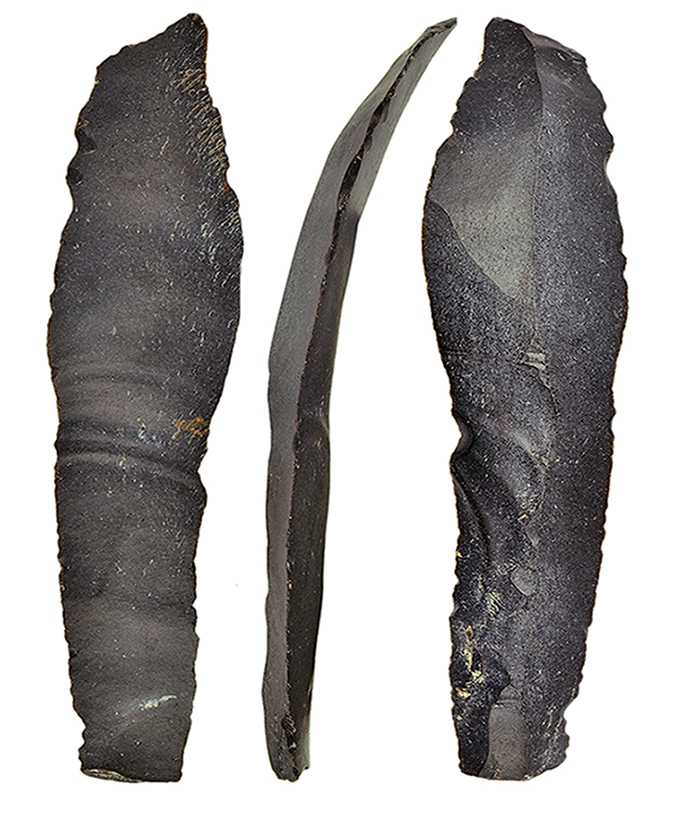
Flint blade for cereal harvesting.
A blade used as a sickle for cereal harvesting, 23 000 years old, from Ohalo II, Israel.
Click on this image to see a full size image showing a number of other blades.
The beginnings of agriculture were long before the development of fully fledged civilisations. Literally, the ground had to be prepared. There was a long period of learning and experimentation before people could became sedentary farmers.
Groman-Yaroslavski et al. (2016) write:
Use-wear analysis of five glossed flint blades found at Ohalo II, a 23 000 years old fisher-hunter-gatherers’ camp on the shore of the Sea of Galilee, Northern Israel, provides the earliest evidence for the use of composite cereal harvesting tools.
The wear traces indicate that tools were used for harvesting near-ripe semi-green wild cereals, shortly before grains are ripe and disperse naturally.
The studied tools were not used intensively, and they reflect two harvesting modes: flint knives held by hand and inserts hafted in a handle. The finds shed new light on cereal harvesting techniques some 8 000 years before the Natufian and 12 000 years before the establishment of sedentary farming communities in the Near East. Furthermore, the new finds accord well with evidence for the earliest ever cereal cultivation at the site and the use of stone-made grinding implements.
Photo: Iris Groman-Yaroslavski , Ehud Weiss, Dani Nadel
Permission: Creative Commons Attribution 2.5 Generic licence
Source: Groman-Yaroslavski et al. (2016)
Proximate Source: Wikipedia
Ancient Egypt
Fifth Dynasty: 2 494 BC - 2 345 BC.
li-nefret
Plowing the field and sowing. By this time, domesticated animals were fully integrated into the production of grains, and had increased production tremendously.
The scene takes place in front of the tomb owner on the right. In front of him appears the head of his lands with two writing reeds (drawing of the tomb relief pictured above).
( the writing reeds referred to appear to be poked into his hair - Don )
To the left of him an overseer drives the ox team pulling the hooked plow by shouting ( and apparently using a cane on their rumps! - Don ).
Behind the plowman guiding the plow the sower scatters seed, and the shepherds control a herd of sheep that trample the seed into the ground. The sheep not only push the seed into the moist earth to germinate successfully, they bury the seed out of reach of birds.
Photo : Don Hitchcock 2018
Source: Original, Badisches Landesmuseum Karlsruhe Germany
Ancient Egypt
Fifth Dynasty: 2 494 BC - 2 345 BC.
Tomb relief: force feeding of cranes.
This is an important record of the domestication (and attempted domestication) of animals in Egypt. There was much trial and error, even thousands of years after the first easily domesticable animals were fully domesticated.
Sheep, goats, cattle, pigs and geese were raised from earliest times in Egypt, and supplied milk, wool, meat, eggs, leather, skins, horn and fat. Even the dung had its uses as fertiliser in the fields. There is little evidence that mutton was consumed, while domesticated pigs were eaten at least since the beginning of the 4th millennium BC, but pork had no place in religious ceremonies.
Goat meat on the other hand was acceptable even to upper class Egyptians. Goat skins served as water containers and floating devices.
The Egyptian farmers, in their early experimental phase, also tried to domesticate other animals such as hyenas, gazelles and cranes, but abandoned these attempts after the Old Kingdom. Here they are shown force feeding cranes, as part of the failed attempt at domestication of these birds.
Catalog: Saqqara, Mastaba of Sopduhotep, limestone, ÄM 14642
Photo: Don Hitchcock 2018
Source: Original, Staatliche Museen zu Berlin, Neues Museum, Germany
Text: © Card at the Staatliche Museen zu Berlin, (CC BY-NC-SA 3.0 DE)
Additional text: http://www.reshafim.org.il/ad/egypt/timelines/topics/domesticated_animals.htm
Sumer and the beginning of civilisation:
I define a civilisation in apparently self-contradictory terms:
You have a civilisation you must first have agriculture, domesticated animals, but there are many other requirements which need to be met:
You also need (or at least will soon have, whether you like it or not!):
• at least two kings with palaces, servants, and slaves, who are at war with each other a lot of the time.
Restoration of a hall in an Assyrian Palace.
Photo: Layard (1849)
Proximal source: New York Public Library
• a very high wall around the palace and associated structures.
Assyrian Palaces
Artist’s impression of Assyrian palaces from The Monuments of Nineveh by Sir Austen Henry Layard, 1853.
Nineveh, also known in early modern times as Kouyunjik, was an ancient Assyrian city of Upper Mesopotamia, located in the modern-day city of Mosul in northern Iraq. It is located on the eastern bank of the Tigris River and was the capital and largest city of the Neo-Assyrian Empire, as well as the largest city in the world for several decades. Today, it is a common name for the half of Mosul that lies on the eastern bank of the Tigris, and the country's Nineveh Governorate takes its name from it.
It was the largest city in the world for approximately fifty years until the year 612 BC when, after a bitter period of civil war in Assyria, it was sacked by a coalition of its former subject peoples including the Babylonians, Medes, Persians, Scythians and Cimmerians. The city was never again a political or administrative centre, but by Late Antiquity it was the seat of a Christian bishop. It declined relative to Mosul during the Middle Ages and was mostly abandoned by the 13th century AD.
Its ruins lie across the river from the historical city center of Mosul, in Iraq's Nineveh Governorate. The two main tells, or mound-ruins, within the walls are Tell Kuyunjiq and Tell Nabī Yūnus, site of a shrine to Jonah, the prophet who preached to Nineveh. Large amounts of Assyrian sculpture and other artifacts have been excavated there, and are now located in museums around the world.
Photo: Layard (1853) from a sketch by James Fergusson (1808–1886)
Proximal source: New York Public Library
Text: Wikipedia
• a permanent, well armed, paid army, whose only job is to be part of the army, to be in training a lot of the time, and to be making raids or full scale wars the rest of the time.
This image shows an Assyrian soldier at left with a full size standing shield, a soldier with the smaller, more ubiquitous circular shield, and an archer on the right.
The standing shield was designed to rest on the ground, with the archer having much more protection than from a handheld small round shield, yet from a very mobile and relatively light device.
The standing shield was a two person device, one to hold the shield upright, and move it as necessary, and the other, an archer, to use it as protection while shooting arrows.
( This particular design (there are others) combines stiffness, strength and light weight by its curved but thin construction, perhaps achieved by the steaming of a suitable plank of wood. - Don )
Photo: Braun & Schneider (circa 1861 - 1880)
Permission: Public Domain
Proximal Source: Wikimedia Commons
• a caste of priests.
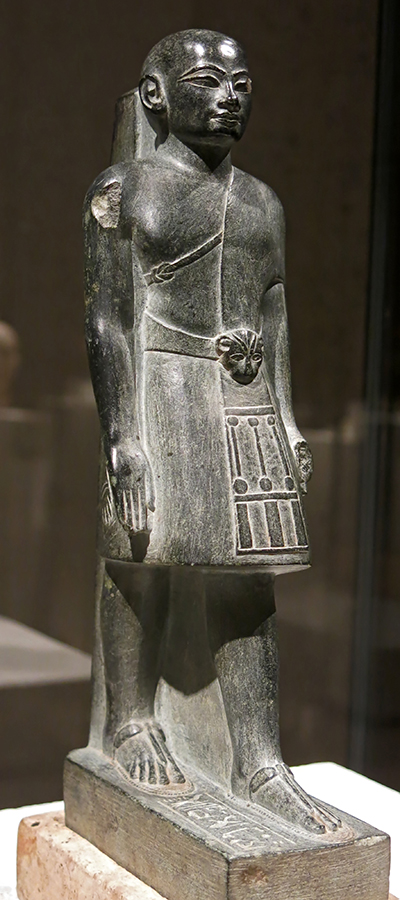
Ancient Egypt
Eighteenth Dynasty: 1 550 BC - 1 292 BC
Taitai
Standing-striding figure of the priest and astronomer Taitai, or Tchaichi.
Circa 1 323 BC -1 319 BC
Priests in ancient civilisations were, by definition, learned men or women, usually with many talents apart from their knowledge of religion.
They often filled important administrative roles.
Tchaichi is wearing a short robe, as well as the priestly leopard fur, whose head rests on the front of the belt. Below is a pocket for an instrument, which identifies the wearer as an astronomer.
275 x 80 mm.
Catalog: Greywacke, Limestone, ÄM 17021
Photo: Don Hitchcock 2015, 2018
Source: Original, Staatliche Museen zu Berlin, Neues Museum, Germany
Text: © Card at the Staatliche Museen zu Berlin, (CC BY-NC-SA 3.0 DE)
Additional text: http://www.jenseits-des-horizonts.de/downloads/pressebilder/
• a caste of scribes with a functioning writing system, or at least people who can keep tabs on how much is in the granaries and the herds, and how much will be needed, on at least a yearly basis.
Inscribed baked clay nail of King Ipik-ishtar (Ipiq-Ishtar) of Malgium, circa 1 770 BC.
The ancient city of Malgium is now known to be located at modern Tell Yassir.
These Sumerian clay nails or foundation pegs with cuneiform inscriptions were used by the Sumerians and other Mesopotamian cultures 4 000 years ago.
They were engraved by a scribe, baked, and then inserted into the mud-brick walls to serve as evidence that the temple or building was the divine property of the god to whom it was dedicated.
Photo: Don Hitchcock 2015
Source and text: Pergamon Museum, Berlin, recherche.smb.museum
Additional text: joyofmuseums.com
This is not a definitive list, but it does include the basics.
Why Sumer?
Why not France or Spain for the beginnings of agriculture?
Let me count the ways....
First, the bad news:
Most plant and animal species are useless to us as food, for one or more of the following reasons:
1. They are indigestible
- like the bark of trees and shrubs, or to give just one example, the leaves of Eucalyptus sp. shown here.
I live in Australia. Koalas use the caecum (at the beginning of the large intestine) to digest Eucalyptus leaves, and their caecum is 2 metres long, ours is only a few centimetres long.
This image is of the distinctive rock formations seen when heading upstream along the Chandler River gorge, from Slaughter House Gully, in the superb 'gorge country' east of Armidale NSW.
There is little that is edible in this image, most of the trees are Eucalyptus sp.
However at certain times of the year, the Casuarina cunninghamiana seeds from the trees right beside the river may be gathered (a tedious task, most are out of reach, and the seeds are small), roasted and eaten. These seeds are however an important food source for red and yellow tailed black cockatoos.
Photo: Don Hitchcock 2007
2. They are poisonous
- Such as deadly nightshade, a Solanum, as well as most other members of the Solanum family (the potato being an honourable exception, though it was selected for non-poisonous characteristics by the South Americans of the Andes Mountains), many wild mushrooms and so on.
A white flowered plant growing on the side of the radweg, from the poisonous Datura genus, known as Thorn apple, which grows widely across the world as a weed. From the Solanaceae or Solanum family.
This plant was growing beside the Donau radweg (Danube cycle path) near the town of Sap in Slovakia.
The entire plant, but especially the foliage and seeds, is toxic due to its content of tropane alkaloids.
Photo: Maria Hitchcock 2008
3. They are low in nutritional values - jellyfish for example.
Sea Nettle Jelly, Jellyfish, Monterey Bay Aquarium, California.
Photo: Fred Hsu
Permission: Released under the GNU Free Documentation License.
Proximate source: Wikipedia
4. They are tedious to prepare - nuts or seeds which are small and sparse in numbers in the wild.
These trees are River Red Gums, Eucalyptus camaldulensis, Edward River Crossing, the Riverina, NSW.
Though edible, the seed is typically 1 to 1.5 mm long, is difficult to gather in any significant quantities.
Speaking from personal experience (my wife is a botanist, and I am taller than she) the woody pods containing the seeds of most Eucalyptus sp. are usually well out of reach of someone standing on the ground beside them.
Photo: MargaretRDonald
Permission: Creative Commons Attribution-Share Alike 4.0 International license.
Proximate source: Wikipedia
5. They are difficult to gather in the wild (larvae of most insects).
Witchetty grubs are a sought after food in Australia, but typically there is only one grub per hole in one tree, and the grub often has to be hooked out after cutting away some of the tree with a knife or small axe to expose the hole properly.
I have very occasionally found one in semi-rotted wood while cutting firewood on our bush block, though I have never plucked up enough courage to eat one.
... And our witchetty grubs are very much smaller than those shown here.
Photo: Sputnikcccp
Permission: Creative Commons Attribution-Share Alike 3.0 Unported license
Proximate source: Wikipedia
6. They are dangerous to hunt - Rhinos and Hippos. Hippos kill about 500 people per year.
Rhinoceros in a national park in South Africa.
Photo: Komencanto, modified by ArtMechanic
Permission: This work has been released into the public domain
Proximate source: Wikipedia
So what did Sumer have going for it so far as agriculture is concerned?
Sumer had a warm climate, suitable for the growing of grains and other vegetables. Although it only received about 25 mm of rain in a year, this was more than made up for by the yearly flooding of the Tigris and Euphrates rivers, which brought not only water, but left nutrient rich muds which were available for growing annual crops when the the floods receded.With irrigation canals, the yearly flooding could be made to water a large area of highly fertile soil.
Nasiriyah near the remains of the ancient city of Ur, has an average annual high of 32.3 °C (90.1 °F) and an average annual low of 17.8 °C (64.0 °F).
The basic crop for the beginning of agriculture is a grain of some kind.
But not just any grain. First it has to exist in the region where agriculture is going to start. That knocks out France and Spain straight away.
As it turns out, the grains available and suitable 'as is' for agriculture were barley, wheat, and peas, and they grew wild in the fertile crescent.
Sumer had grains which were eminently suitable for domestication.
The Sumerians had the ancestors of what would become beans, peas, wheat, and barley. These do not need to be planted individually, and they grow by broadcasting their seeds onto the ground where they grow. These plants initially had disadvantages such as small size, and their seedheads and seedpods shattered early, but by selecting the biggest grains, and harvesting from the plants which happened to keep their seedheads intact for longer, their harvests gradually improved to the point where it was possible to grow enough grains to allow sedentary farming.
Most grains have the huge advantage that they remain viable and edible for years, so long as they are kept in dry conditions, such as in caves or in vessels such as ceramic jars, or in silos or in houses, so long as they are protected from rodent attack.
In addition, there were animals in the area such as wild cattle, pigs, goats, sheep and donkeys, which were amenable to domestication - that is, they became docile in captivity, and were able to be penned and herded.
Cattle were able to be harnessed to carts, as were donkeys, and pigs and sheep and goats provided meat and leather, and sheep provided wool for spinning into useful yarns for weaving clothing.
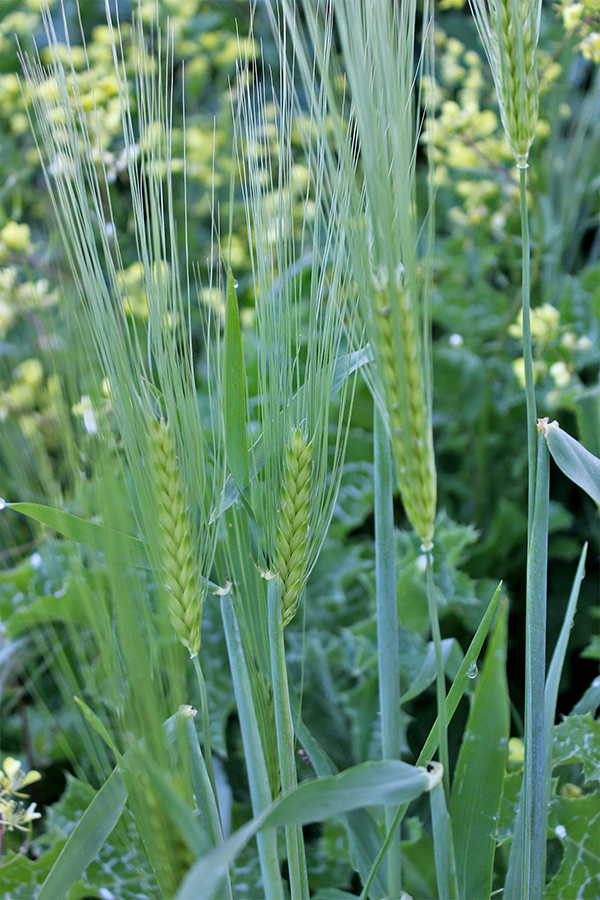
Wild wheat, Triticum turgidum subsp. dicoccoides, growing in a stand of mustard.
Photo: Davidbena
Permission: Creative Commons Attribution-Share Alike 4.0 International license
Proximal source and text: Wikipedia
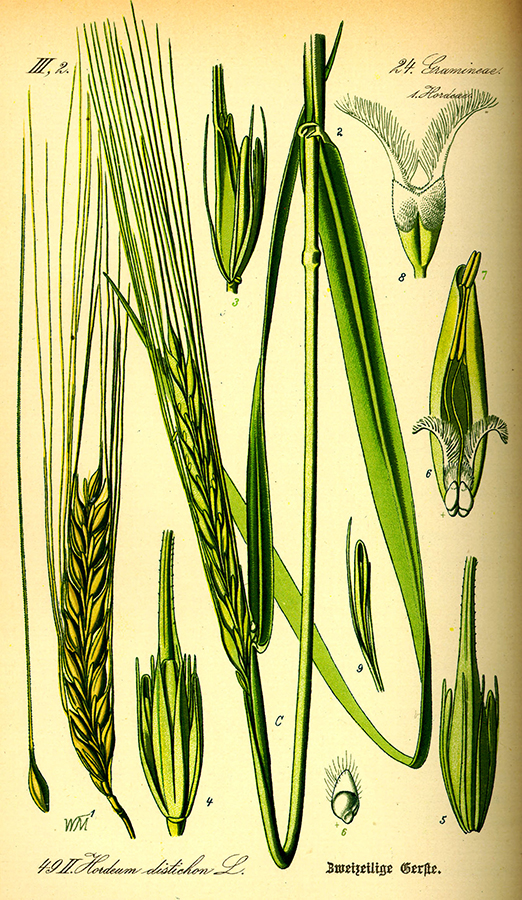
Common Barley, Hordeum distichon.
Hordeum distichon., the common barley or two-rowed barley, is a cultigen of barley, family Poaceae. It is native to Iraq, and is widely grown throughout temperate regions of the world.
Barley, a member of the grass family, is a major cereal grain grown in temperate climates globally. It was one of the first cultivated grains, particularly in Eurasia as early as 10 000 years ago.
Globally 70% of barley production is used as animal fodder, while 30% as a source of fermentable material for beer and certain distilled beverages, and as a component of various foods. It is used in soups and stews, and in barley bread of various cultures. Barley grains are commonly made into malt in a traditional and ancient method of preparation.
In 2017, barley was ranked fourth among grains in quantity produced (149 million tonnes or 330 billion pounds) behind maize, rice and wheat.
Photo: Prof. Dr. Otto Wilhelm Thomé Flora von Deutschland, Österreich und der Schweiz 1885, Gera, Germany
Permission: This work has been released into the public domain
Proximal source: www.biolib.de
Text: Wikipedia
If we select just a few species of animals and plants that we can eat, so that for example they form 90% of the biomass on a hectare of land rather than 0.1%, the productivity of the land (so far as we are concerned) increases astronomically.
Thus, one hectare can feed 10 or 100 times more farmers and herders than it can for hunter gatherers.
But which species of plants (the most important food producing item, at least at first, before animals get domesticated, and are at least partially fed on the plants we grow) are the best?
The plants which were able to be domesticated in the Fertile Crescent, which includes Sumer, were barley, einkorn and emmer wheat, oat, rye, chickpea, lentil and pea.
Domestication can be a difficult process, and some foods (zebras and gazelles for example) cannot be domesticated.
With grains and legumes, the wild varieties do all sorts of bad things if you let them have half a chance - they have small grain sizes, are sometimes bitter, they shed and scatter their seed too quickly before they can be harvested, the seeds do not all reach maturity at the same time, they are not compact in size, and they have a low yield in terms of kilograms/tons per hectare.
These unwanted traits were selected out, not by careful scientific breeding, but by what you might call 'natural selection'. The farmers could not harvest the grains which shed their seeds too soon, so they got the ones which stayed to be harvested, and the resulting seed that they saved and planted next year, and the year after that, had an increasing tendency to remain on the stalk until harvesting. In addition, the farmers would have chosen the largest and least bitter seeds, and planted those in the next season, collected the ones which matured at the same time, and so on.
Sumer
Circa 4 500 - 1 900 BC
Map of Ancient Sumer
Circa 4 500 - 1 900 BC.
The general location on a modern map, and main cities of Sumer with ancient coastline. The coastline was very near Ur in ancient times, and Ur was an important port, with the Euphrates River on the city's western side.
Sumer was bounded by the Tigris and Euphrates rivers, and extended as far north as Kiš (Kish) and Djemdet Nasr. North of this, and to the east of the lower Tigris and to the west of the lower Euphrates was the Akkadian Empire.
Photo: NASA
Permission: This file is in the public domain in the United States because it was solely created by NASA.
Proximate source: Wikipedia
Sumer is the earliest known civilisation in the historical region of southern Mesopotamia (south-central Iraq), emerging during the Chalcolithic (Copper) and early Bronze Ages between the sixth and fifth millennium BC. It is one of the cradles of civilisation in the world. Living along the valleys of the Tigris and Euphrates rivers, Sumerian farmers grew an abundance of grain and other crops, the surplus from which enabled them to form urban settlements. Proto-writing dates back before 3 000 BC. The earliest texts come from the cities of Uruk and Jemdet Nasr, and date to between 3 500 BC and 3 000 BC.
Ancient Sumer, extant from 6 000 BC to 1 750 BC, lay between the Tigris and Euphrates Rivers, and stretched from Kish (Kiš) to Ur. Kiš was 25 km from the site of Babylon. Babylon was established around 1 200 BC as a small religious and cultural centre.
This is an excellent resource, particularly for Ancient Mesopotamian Warfare in Sumer and Akkad, as well as the first Sargon, known as Sargon the great and Sargon of Akkad:
www.youtube.com/watch?v=10Kc7NmPpME
The First Dynasty of Ur was a 2 600 BC to 2 400 BC dynasty of rulers of the city of Ur in ancient Sumer. It is part of the Early Dynastic period III of the history of Mesopotamia. It was preceded by the earlier First Dynasty of Kish and the First Dynasty of Uruk.
According to the Sumerian King List, the final ruler of the First Dynasty of Uruk Lugal-kitun was overthrown by Mesannepada of Ur. There were then four kings in the First Dynasty of Ur: Mesannepada, Mes-kiagnuna, Elulu, and Balulu. Two other kings earlier than Mes-Anepada are known from other sources, namely Mes-kalam-du and A-Kalam-du. It would seem that Mes-Anepada was the son of Mes-kalam-du, according to the inscription found on a bead in Mari, and Mes-kalam-du was the founder of the dynasty. A probable Queen Puabi is also known from her lavish tomb at the Royal Cemetery at Ur. The First Dynasty of Ur had extensive influence over the area of Sumer, and apparently led a union of south Mesopotamian polities.
Ethnicity and language
Like other Sumerians, the people of Ur were a non-Semitic people who may have come from the east circa 3300 BC, and spoke a language isolate. Sumer was conquered by the Semitic-speaking kings of the Akkadian Empire around 2270 BC (short chronology), but Sumerian continued as a sacred language. Native Sumerian rule re-emerged for about a century in the Third Dynasty of Ur at approximately 2100–2 000 BC, but the Akkadian language also remained in use.
Text above: adapted from Wikipedia.
In the late Uruk Period, shortly before the end of the 4th millennium BC (circa 3 700 BC - 3 0001 BC), statues of great plasticity and expressiveness were created to depict both humans and animals. The 3rd millenium BC ( 3 000 BC - 2 001 BC) witnessed the appearance of a new statue type that represented a standing worshipper; the repertory was further enriched by the addition of seated figures and groups. Naturalistic representations make their first appearance during the Akkadian Period and the Third Dynasty of Ur, at the end of the 3rd millenium.
Stone, metal, and combinations of various materials were used to make statues which ranged from a few cm in height to lifesized figures. The perishability of wood is responsible for the rare attestation of statuary in that material.
Text above: Pergamon Museum, Berlin, recherche.smb.museum
Statuettes of a woman and a man in prayer positions, circa 2 600 BC
These statuettes show the believers in the typical prayer position with their hands folded over their stomachs. In the archaic Ishtar temples, statuettes of worshipers stood on pedestals along the walls. They were supposed to represent the founder and remained in the temple as ancestral images after his death.
The large eyes in Sumerian sculptures like these signified wisdom and knowledge.
Catalog: Location unknown, alabaster.
Photo: Don Hitchcock 2015
Source and text: Pergamon Museum, Berlin, recherche.smb.museum
Animal heads, circa 3 000 BC
Left: Ram's head, sandstone, Uruk.
Catalog: VA 14570
Height 75 mm, width 146 mm, thickness 111 mm.
Permalink: id.smb.museum/object/2107547/kopf-eines-schafes
Centre: Fragment of a ram's head, limestone
Circa 2 800 - 2 700 BC.
Period: Djemdet-Nasr Period
Height 126 mm, width 95 mm, thickness 145 mm, weight 2120 gm (2570 gm with base)
Catalog: VA 13354
Permalink: id.smb.museum/object/1743405/bruchst%C3%BCck-eines-widderkopfs
Right: Lion's head, marble, unknown origin.
Photo: Don Hitchcock 2015
Source and text: Pergamon Museum, Berlin, recherche.smb.museum
Reclining ram with silver staff
Circa 2 800 - 2 700 BC.
Height 107 mm, width 42 mm, length 97 mm, weight 669 gm.
Period: Djemdet-Nasr
Catalog: Bituminous limestone, silver, VA 11025
Location: Oe 16-3, collective find
Permalink: id.smb.museum/object/1744367/liegender-widder-mit-silberstab
Photo: Don Hitchcock 2015
Source and text: Pergamon Museum, Berlin, recherche.smb.museum
Animals, circa 3 000 - 2 500 BC.
Front left: Figure representing a leaping lion
Circa 2 800 - 2 700 BC.
Height 22 mm, width 13 mm, length 85 mm, weight 40 gm.
Catalog: VA 09871
Permalink: id.smb.museum/object/1743403/fig%C3%BCrliche-darstellung-eines-springenden-l%C3%B6wen
Front centre: Lying dog, limestone, Uruk?
Beginning of the 3rd millennium
Front right: lying bull with inlays - Uruk
Beginning of the 3rd millennium
Back centre: lying calf with inlaid recesses in marble - Uruk
Statuette of a lying calf with cloverleaf-shaped inlays made of lapis lazuli. The drill hole on the underside suggests an attachment, for example for its use as a handle for a cylinder seal.
Circa 2 800 BC - 2 700 BC.
Period: Djemdet-Nasr Period
Height 26 mm, length 52 mm, depth 23 mm, weight 38 gm.
Catalog: Marble, inlays of lapis lazuli, find quadrant Pa XVI 2, VA 14536
Location detail: Collection find from the room of the smokehouse III, in front of the Zikurrat +19m, in the courtyard of the building.
Permalink: id.smb.museum/object/1744371/liegendes-rind
Photo: Don Hitchcock 2015
Source and text: Pergamon Museum, Berlin, recherche.smb.museum
Games and Musical Instruments
Music played an important part in religious and secular ceremonies and banquets. There is evidence for a variety of instruments. Assyrian reliefs of the 9th - 7th centuries BC are a rich source of information. String instruments including the lute and harps and lyres of different types. Bulls' and ducks' heads on these may have been an indication of their pitch. There were also many wind instruments such as flutes and pipes, as well as a range of percussion, including drums, cymbals, bells, and rattles.
The occasions when music was used are well-documented on cuneiform tablets. Hymns were written down and so were lists of musical instruments arranged according to category. Some texts provide information for tuning and playing instruments. The Mesopotamian musical system, like that of the ancient Greeks, seems to have included a set of 7 heptatonic, diatonic scales. A heptatonic scale has seven tones per octave, such as C major, CDEFGABC, and the relative minor, ABCDEFGA.
Text above: © Poster on display at the British Museum, © Trustees of the British Museum, CC BY-NC-SA 4.0, as well as extra information on scales from Wikipedia.
The Queen's Lyre
This lyre was found in the tomb of Queen Puabi. The lapis lazuli, shell and red limestone decoration and the head of the bull are original. The wooden parts, pegs and strings and bull horns are modern reconstructions.
The bull's head is covered with gold. The eyes are lapis lazuli and shell, and the hair an beard are lapis lazuli. The scenes on the front of the lyre show a lion-headed eagle between gazelles, bulls with plants on the hills, a bull-man between leopards and a lion attacking a bull.
Queen's Lyre. Wooden parts, pegs and string are modern. Lapis lazuli, shell and red limestone mosaic decoration, set in bitumen and the head (but not the horns) of the bull are ancient. The bull's head in front of the sound box is covered with gold, the eyes are lapis lazuli and shell and the hair and beard are lapis lazuli.
The significance of the beard is not known. The panel on front depicts a lion-headed eagle between gazelles, bulls with plants on hills, a bull-man between leopards and a lion attacking a bull. The edges of the sound-box are decorated with inlaid bands. There are eleven gold-headed pegs for the strings.
Circa 2 600 BC - 2 400 BC
Height 125 mm, length 180 mm (pins), length 955 mm (top bar), total length 730 mm, width 70 mm (body).
The original paraffin wax of the field reconstruction is partially melted, with the detachment of the beard, following an intense buildup of heat in the relevant gallery on 1 July 1961 (Report to Trustees, 8 July 1961). The object was consolidated, and apparently reconstructed in 1971/72 from part of Woolley's harp-lyre, 121198.
Catalog: lapis lazuli, limestone (red), bitumen, gold, shell, 121198A
Findspot: Royal Cemetery (Ur)
Photo: Don Hitchcock 2015
Source: Original, British Museum
Text: © Card with the display at the British Museum, © Trustees of the British Museum, CC BY-NC-SA 4.0.
Silver lyre; the silver which covers this lyre and its bull's head, and the shell, lapis lazuli and red limestone inlay decoration are ancient, but the frame, the pegs, strings and bridge are modern; the original silver pegs are exhibited separately; the panel on the front of the lyre depicts fallow deer and a tree on a hill, lions attacking a goat, and a lion attacking a gazelle.
Circa 2 600 BC
Leonard Woolley discovered several lyres in graves of the Royal Cemetery at Ur. This was one of four musical instruments that he found in the Great Death Pit. The wood of the instruments had decayed, but Wooley poured plaster into the holes left by the vanished wood and so preserved their shapes and decoration.
The silver which covers this lyre and its bull's head are original. It is almost certain that the soundboard was made only with sheet silver, but it is now supported on a wooden frame.
The shell, lapis lazuli and red limestone inlay decoration is also ancient, but the strings and pegs are modern.
Height: 155 mm (shell decoration), height 975 mm, length 1030 mm (bar), length 180 mm (pin) length 690 mm.
Width: 55 mm (body)
Wood fragments from 'paddles' (tuning pegs?) identified by Caroline Carwright as Buxus sempervirens, Boxwood 2/11/15.
Catalog: silver, shell, limestone (red), lapis lazuli, wood, Grave PG 1237, The Great Death Pit, Ur, ME 121199
Findspot: Royal Cemetery (Ur)
Photo: Don Hitchcock 2015
Source: Original, British Museum
Text: © Card with the display at the British Museum, www.britishmuseum.org, © Trustees of the British Museum, CC BY-NC-SA 4.0.
These are the original silver pegs from the silver lyre shown above.
Circa 2 600 BC
Catalog: silver, Grave PG 1237, The Great Death Pit, Ur, ME 121199
Findspot: Royal Cemetery (Ur)
Photo: Don Hitchcock 2015
Source: Original, British Museum
Text: © Card with the display at the British Museum, www.britishmuseum.org, © Trustees of the British Museum, CC BY-NC-SA 4.0.
Left: Harp.
Reconstructed boat-shaped harp.
Original from the Royal Cemetery (Ur).
Curator's comments:
This object was reconstructed in 1971-1972. It has often been referred to as a lyre but is more accurately described as a boat-shaped harp and is labelled as such in the 'Early Mesopotamia' gallery where it is displayed.
Catalog: both 121198b and 121198c are given in the BM online catalog for this piece, though it is probably 121198c.
Right: Queen's Harp
Reconstruction of a boat-shaped harp with 13 strings; on the left are the actual remains of the gold headed tuning pegs and lapis lazuli decoration of the harp; the shape of the instrument was reconstructed on the basis of representations of the instrument on seals, and on sketches made at the time of excavation.
Circa 2 600 BC
Height, Total as shown here 1085 mm, height 810 mm (top of cap to bottom), length 650 mm as shown here, width 150 mm as shown here.
Curator's comments:
Reconstructed in 1971-2 from part of Woolley's harp-lyre 121198; harp had eleven strings prior to July 1955; when under repair another pin was found and an additional string was fitted; during reconstruction in 1971-2 x-ray photographs indicated a further pin buried in Woolley's plaster which was removed and fitted on the upright.
Findspot: Royal Cemetery (Ur)
Catalog: Gold, lapis lazuli, wood, 121198,b
Photo: Don Hitchcock 2015
Source: Original, British Museum
Text: © Card with the display at the British Museum, www.britishmuseum.org, © Trustees of the British Museum, CC BY-NC-SA 4.0.
The Royal Game of Ur
At least six graves in the Royal Cemetery contained a wooden game board inlaid with shell, red limestone and lapis lazuli for the game now known as the Royal Game of Ur.
This is an early example of a game that was played all over the ancient Near East for about 3 000 years.
Early Dynastic III, 2 600 - 2 300 BC from grave PG 513, Ur.
This wooden game board was originally hollow, with the top covered with 20 inlaid square shell plaques. The edges were made of small plaques and strips, some sculpted with an eye and some with rosettes. On the back are three lines of triangular shell ornamental inlays set as part of the modern reconstruction.
Height 24 mm, length 301 mm, width 57 mm (narrow part of b), width 110 mm.
Curator's comments:
Circumstances of discovery and consolidation in the field described by Woolley (and quoted by Grunfeld) as follows:
'The board lay face upwards in the soil. With the decay of the wood the whole of the encrustation of the upper surface had sunk down into the void so left, while the strip-work along the sides remained sticking up above it; this collapse had this collapse had resulted in the dislocation of much of the fine mosaic border, and the regularity of the surface was disturbed, the shell squares often lying at an angle and the lapis strips overlapping them
Further, the end of the larger section had been broken and the three last plaques (all except the corner of that on the left, which was still attached) and the right-hand plaque of the next row lay separated from each other and half an inch or more away from the main board, and the border and edging here had been scattered. It was this broken end that we found first and probably some pieces of the strip edging were overlooked by us; when the presence of the object was recognised we worked along it a square or so at a time, pouring hot wax over it as we went, and finally the whole was secured with waxed cloth and lifted. It has not been taken to pieces and remade. The inside was cleaned and covered with waxed muslin and the cloth and wax removed from the face and then it was placed face downwards on a sheet of glass and by applying heat we were able to push the component parts down into their places.
The three loose plaques were replaced in the order in which they were found, but nothing was done to restore the missing part of the border and edging. The red and blue spots inlaid in the shell plaques and petals of the flowers were loose in their sockets when found, but were fixed by the wax poured over them and very few of them have been disturbed and replaced. The object was reconstructed by the WAA conservator I G Tremayne following sagging through a build-up of intense heat in the gallery (Report to Trustees 5 July 1961).
An important point to note, often forgotten, is that this was a hollow box and not a solid board: it was therefore a much more delicate item than the present reconstruction suggests and the interior of the box contained the pieces and the dice, just as a silver version did when excavated in another grave. Moreover, there are several other boxed sets for this game found in this Cemetery.
The others are in the Iraq Museum in Baghdad and on display. Another version carved entirely of wood was excavated in a grave at Shahr-i Sokhta in eastern Iran, and inlaid versions of a yet different style excavated in the 'Royal Cemetery' at Gonur depe in present-day southern Turkmenistan. The origins of all are thought to lie in the Indus valley.
Catalog: Wood, shell, Grave PG 513, Royal Cemetery (Ur), ME 120834
Photo: Don Hitchcock 2015
Source: Original, British Museum
Text: © Card with the display at the British Museum, www.britishmuseum.org, © Trustees of the British Museum, CC BY-NC-SA 4.0.
The Royal Game of Ur
The Game and Route
The game is a race for two players using dice with seven identical pieces each. All playing squares are decorated, but on later boards only the 'rosette' squares are marked.
The likely route is suggested on the diagram above. Pieces are 'at war' along the central path, but turn off to their own side to exit.
Counters
Playing pieces were simple discs of shell or lapis lazuli. Sometimes these were plain, but usually they were inlaid with five points.
Square pieces have also been found, some plain and others decorated with a 'good luck' eye or animal motif.
Dice: White pieces
Players at Ur had two kinds of dice. Here, the white player has very unusual four sided (tetrahedral) dice, in which two corners were marked with contrasting inlay.
Each player had four or six dice. To move around the board they threw the dice and the number of marked corners told them how far they could go.
ME 120839: Grey-black stone tetrahedral dice; depression in top; small spot of white inlay in two of the corners.
ME 1935,0113.847: Stone tetrahedral dice.
Height 13 mm, length 16 mm (side of base).
Dice: Black pieces
Here, the black player has four-sided stick dice. A player's score told them how far they could move. Scores of 1, 2, and 3 were shown by concentric circles and 4 by cross-hatching.
Similar dice are found at Indus Valley sites of the 3rd millenium BC and are still used in India today.
ME 1930,1213.534: Stick die of bone, inlay pattern on one narrow side, length 57 mm, width 5 mm
ME 1935,0113.848: Stick die of bone, length 68 mm, width 6 mm, depth 4 mm.
ME 1929,1017.438: Stick die of mother-of-pearl, traces of engraving on one edge, length 33 mm, width 6 mm.
Rephotography: Don Hitchcock 2015
Source: Poster, British Museum
Text: © Text on the poster at the British Museum, www.britishmuseum.org, © Trustees of the British Museum, CC BY-NC-SA 4.0.
The Rules Tablet for the Royal Game of Ur
This cuneiform tablet contains the world's oldest known rules for a board game, written by a Babylonian astronomer in 177 BC. The original game had evolved and was now played for bets with five different pieces per player. The front of the tablet shown here shows that the central squares were also used for fortune telling.
Based on this tablet and the shape of the gameboard, British Museum curator Irving Finkel reconstructed the basic rules of how the game might have been played. The object of the game is to run the course of the board and bear all one's pieces off before one's opponent. Like modern backgammon, the game combines elements of both strategy and luck.
(
Irving Finkel is one of this world's treasures. He can read cuneiform as easily as you and I can read a newspaper. His knowledge of the ancient world and his ability to make it available in an hilarious (sic) and highly interesting way to the rest of us is worthy of the highest honours this world can bestow. He is not only a scholar, but an entertainer par excellence - Don )
Clay cuneiform tablet; explanatory diagram and rules for playing the game of 20 squares (Royal Game of Ur). Colophon of Itti-Marduk-balatu.
Ruler: Seleucus IV Philopator
Regnal date 135/8/3 (day ?) (day ?)
Height 100 mm, width 94 mm, depth 28 mm.
Inscription language: Akkadian
Inscription script: cuneiform
Catalog: clay, ME 33333,b
Photo: Don Hitchcock 2015
Source: Original, British Museum
Text: © Card with the display at the British Museum, www.britishmuseum.org, © Trustees of the British Museum, CC BY-NC-SA 4.0.
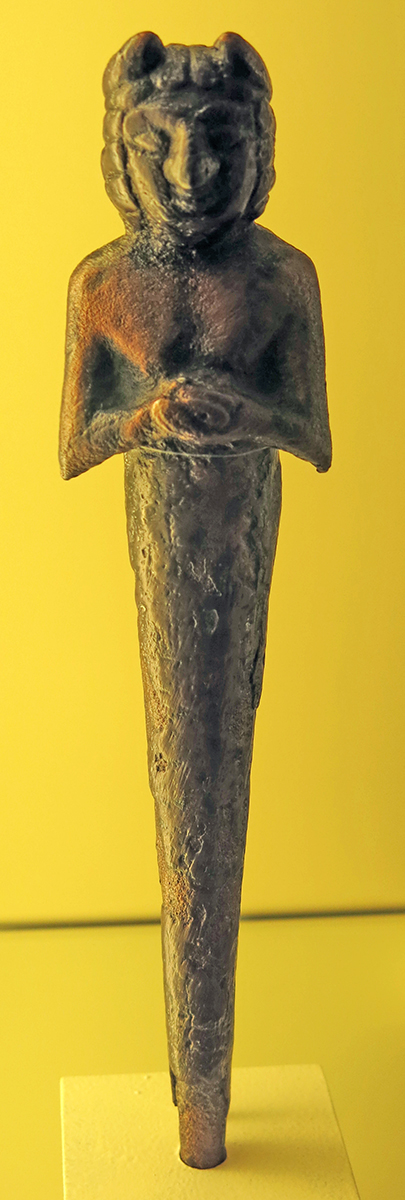
Early Dynastic Period
Founding figure which originally supported an inscribed alabaster plate in brick form, from Lagash, circa 2 430 BC.
Height: 250 mm, width 55 mm, thickness 37 mm, weight 77 gm.
Significant buildings have been erected since the 3rd millennium BC. Founding documents were laid down in the 1st century BC, which had a wide variety of shapes and sizes and were mostly hidden in the structure. They state the purpose of the building, its name and often the reason for the construction work. Names, location information and mentions of deities are of great value, as this makes it possible to identify the finding and more precisely date it.
The metal figure with a stone plate is a special form. It consists of the composition of a nail-shaped deity (recognisable by the pair of horns) who wears a 'brick' on the head. The main inscription of the builder is on its underside. In Sumerian it names twelve buildings that the prince En-ME.TE-na of Lagash had built.mentions of deities are of great value, as this makes it possible to identify the finding and more precisely date it.
The figure that anchors the stone in the masonry like a nail bears a short version of the same inscription. The spiritual effect of the text can therefore be seen as a concentration from the stone via the figure into the masonry, which does not require visibility. The writing clearly refers to the shape of the cuneiform on clay documents: the characters are partly scratched with wedge-shaped attachments. However, the archaic character of early Mesopotamian stone inscriptions is preserved. [Joachim Marzahn]
Catalog: Bronze figure, VA 03024
Permalink: id.smb.museum/object/1744356/gr%C3%BCndungsfigur-und-beschriftete-alabasterplatte-in-ziegelform
Photo: Don Hitchcock 2015
Source and text: Pergamon Museum, Berlin, recherche.smb.museum
Early Dynastic Period
Inscribed alabaster plate in brick form, originally on top of the bronze founding figure above, from Lagash, circa 2 430 BC.
Alabaster plate: height 250 mm, width 55 mm, thickness 37 mm, weight 77 gm.
Catalog: Alabaster plate, VA 03095
Permalink: id.smb.museum/object/1744356/gr%C3%BCndungsfigur-und-beschriftete-alabasterplatte-in-ziegelform
Photo: Don Hitchcock 2015
Source and text: Pergamon Museum, Berlin, recherche.smb.museum
Early Dynastic Period
Founding figure and inscribed alabaster plate in brick form, from Lagash, circa 2 430 BC.
Figure as originally assembled.
Catalog: Bronze figure, VA 03024, alabaster plate, VA 03095
Permalink: id.smb.museum/object/1744356/gr%C3%BCndungsfigur-und-beschriftete-alabasterplatte-in-ziegelform
Photo: Staatliche Museen zu Berlin, Vorderasiatisches Museum / Olaf M. Teßmer CC BY-SA 4.0
Early Dynastic Period
Babylonian bronze bull's head , circa 2 600 BC.
The origin of this bronze bull's head is uncertain, but based on stylistic peculiarities, identifying characteristics can be identified that lead to a classification. Upon closer inspection, the sculpture differs noticeably from the model of a living animal.
The basic shape is taken from nature, but the horn bulge appears to be set too high, the ears protrude inorganically from the head and form trowel-shaped shells, and the nose area also has a more decorative character due to the formation of the nostrils into volutes. Some of this can certainly be attributed to the casting and assembly technology, as the ears are pinned to the head and the inserted horns require manageable attachment points.
Nevertheless, the head is subject to its own design principles, which also use the casting technique for their style-forming purposes.
Bull protomes shaped in the same and similar way are known from several places. They were used as wall decorations or adorned the sound boxes of harps or lyres, as examples from Ur show. The head shown can also be placed in this series of comparison pieces. Its intended decorative effect was enhanced by coloured inlaid eyes, of which only a remnant remains today. This piece is rightly regarded as evidence of the masterful mastery of metallurgical processes. [Joachim Marzahn]
Height 207 mm, width 187 mm, depth 105 mm, weight 1480 gm.
Permalink: id.smb.museum/object/1744282/kopf-eines-stieres
Photo: Don Hitchcock 2015
Source and text: Pergamon Museum, Berlin, recherche.smb.museum
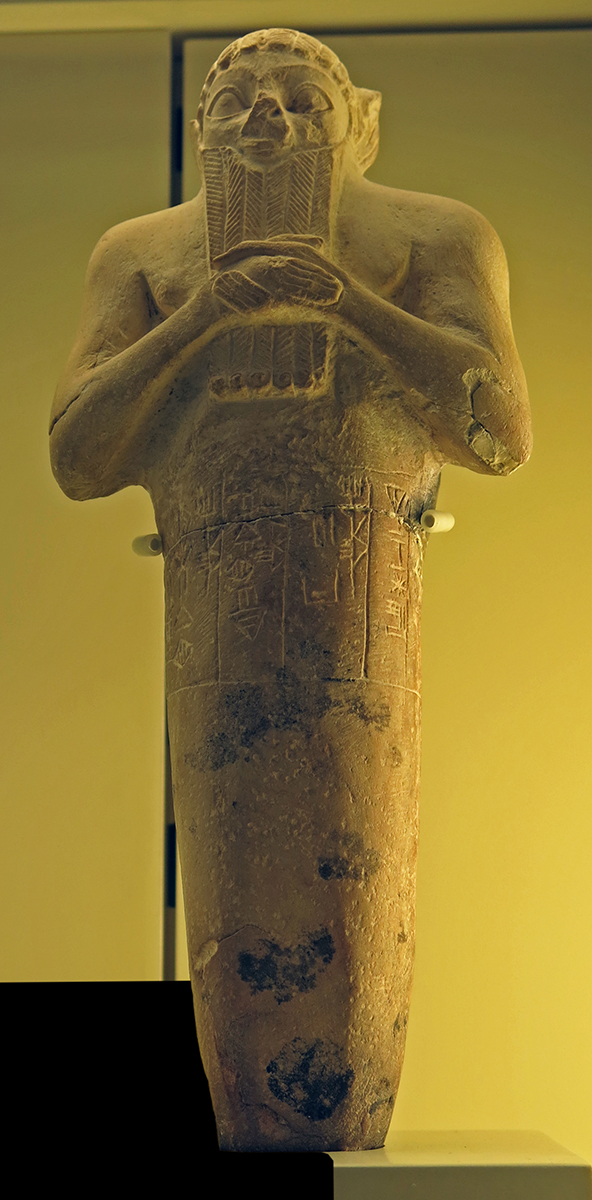
Second Dynasty of Uruk
Limestone nail figurine with a dedication inscription by King Lugal-kisalsi of Uruk for a temple of the goddess Namma, circa 2 380 BC.
Limestone foundation peg of King Lugal-kisalsi, from Uruk, Iraq, circa 2 380 BC. Pergamon Museum VA 04855. The inscription reads 'For (goddess) Namma, wife of (the god) An, Lugalkisalsi, King of Uruk, King of Ur, erected this temple of Namma'.
Reign: circa 2 400 BC.
Predecessor: Lugal-kinishe-dudu.
Successor: Enshakushanna.
Height 245 mm, width 100 mm, depth 58 mm, weight 1040 gm.
Catalog: VA 04855
Permalink: id.smb.museum/object/1744366/gr%C3%BCndungsurkunde-in-form-einer-statuette-mit-inschrift-des-k%C3%B6nigs-lugalkisalsi
Photo: Don Hitchcock 2015
Source and text: Pergamon Museum, Berlin, recherche.smb.museum
Door hinge stone with an inscription of King En-METE-na of Lagash, circa 2 340 BC
Photo: Don Hitchcock 2015
Source: Pergamon Museum, Berlin, recherche.smb.museum
Text: Adapted from Wikipedia
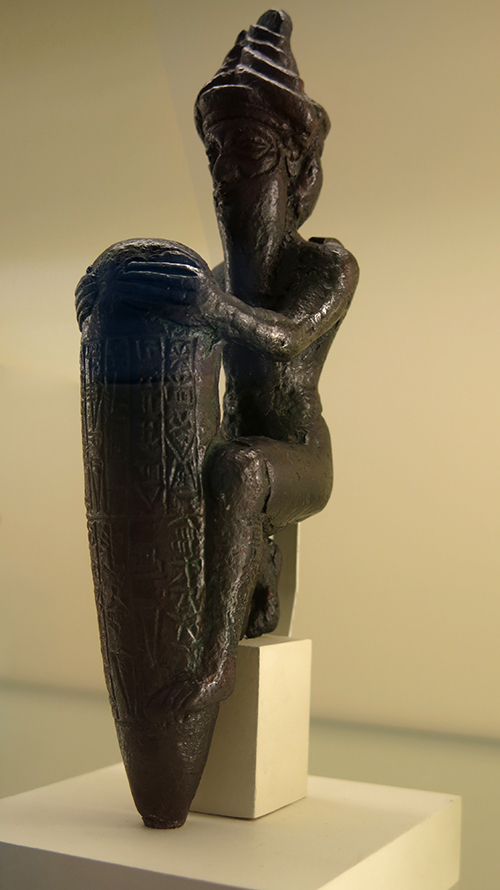
Kneeling god wearing a horned crown, with a dedication inscription of Gudea, holding a foundation peg, bronze.
2 144 BC - 2 124 BC
Height 174 mm, width 52 mm, weight 730 gm.
Catalog: Bronze, VA 03023
Permanent link: id.smb.museum/object/1744283/kniender-gott-mit-gr%C3%BCndungsnagel
Photo: Don Hitchcock 2015
Source and text: Pergamon Museum, Berlin, recherche.smb.museum
Baked clay nail with inscription of Prince Gudea of Lagash, circa 2 140 BC
Baked clay cones and nails were inscribed in the name of a ruler of a Mesopotamian city-state to commemorate an act of building or rebuilding, often of a temple for a specific deity. Deposited in the walls or under the foundations of these structures, the words of the texts were directed at the gods but would be found by later restorers.
Photo: Don Hitchcock 2015
Source and text: Pergamon Museum, Berlin, recherche.smb.museum
Additional text: art.thewalters.org
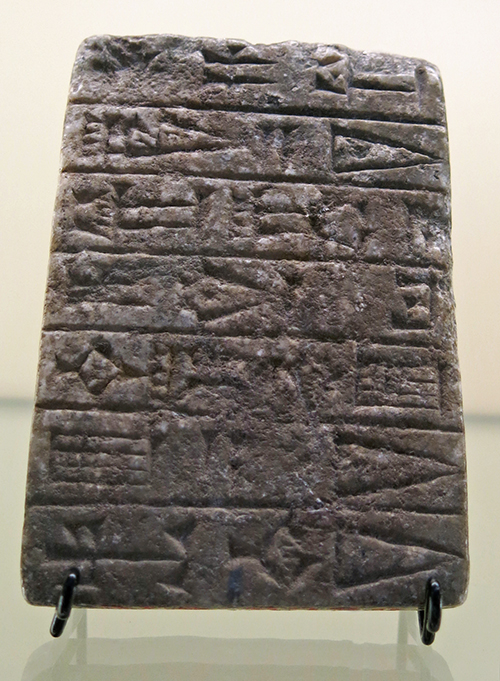
Alabaster tablet with an inscription of Gudea of Lagas dedicated to the god Pabilsang, circa 2 140 BC.
Gudea was a ruler (ensi) of the state of Lagash in Southern Mesopotamia, who ruled circa 2 144 - 2 124 BC (middle chronology). He probably did not come from the city, but had married Ninalla, daughter of the ruler Ur-Baba (2 164 BC – 2 144 BC) of Lagash, thus gaining entrance to the royal house of Lagash. He was succeeded by his son Ur-Ningirsu. Gudea ruled at a time when the centre of Sumer was ruled by the Gutian dynasty, and when Ishtup-Ilum ruled to the north in Mari. Under Gudea, Lagash had a golden age, and seemed to enjoy a high level of independence from the Gutians.
Gudea Ensi Lagashki, 'Gudea, Governor of Lagash', may be seen in the inscription.
Gudea chose the title of énsi (town-king or governor), not the more exalted lugal (Akkadian šarrum). Gudea did not style himself 'god of Lagash' as he was not deified during his own lifetime, this title must have been given to him posthumously, in accordance with Mesopotamian traditions for all rulers except Naram-Sin of Akkad and some of the Ur III kings.
The 20 years of his reign are all known by name; the main military exploit seems to have occurred in his Year 6, called the 'Year when Anshan was smitten with weapons'.
Although Gudea claimed to have conquered Elam and Anshan, most of his inscriptions emphasise the building of irrigation channels and temples, and the creation of precious gifts to the gods.
Materials for his buildings and statues were brought from all parts of western Asia: cedar wood from the Amanus mountains, quarried stones from Lebanon, copper from northern Arabia, gold and precious stones from the desert between Canaan and Egypt, diorite from Magan (Oman), and timber from Dilmun (Bahrain).
Photo: Don Hitchcock 2015
Source and text: Pergamon Museum, Berlin, recherche.smb.museum
Additional text: Wikipedia
( Note that there was only one identification for both these objects, and I was unable to find either in the online catalog - Don )
Stone tablet with a dedication inscription of Gudea of Lagash for the Baba temple.
Baba was the patron goddess of Girsu and the city-state of Lagaš. Beginning in 2 000 BC she became known as a healing goddess.
Photo: Don Hitchcock 2015
Source and text: Pergamon Museum, Berlin, recherche.smb.museum
Additional text: oracc.museum.upenn.edu
( Note that Ur and Uruk are not the same, although they seem to be used interchangeably in many sources, and I have found disentangling these reports quite difficult, a task I have not yet completed. They were both located in Lower Mesopotamia, but they were separate city-states. Uruk was the larger city-state and was founded around 4 500 BC, while Ur, which is located nearer to the Persian Gulf, was constructed around 3 800 BC, and was continuously inhabited until 450 BC - Don )
This map shows the extent of the Ur III Empire in Mesopotamia circa the 22nd century BC, i.e. between 2 200 BC and 2 101 BC.
The map is based on Garelli, Paul: 'El Imperio de Ur y su herencia', en El Próximo Oriente asiático. Barcelona: Labor 1974. ISBN 8433593102.
Map from File:Ciudades del antiguo Oriente Medio.svg.
Photo and text: Wikimedia Commons
Shu-Sin, Penultimate ruler of the Third Dynasty of Ur, also known as the Neo-Sumerian Empire
Shu-Suen or Shu-Sin was the penultimate ruler of the 3rd dynasty of Ur, reigning in 2 037 - 2 030 BC. (middle chronology), son of Shulgi and brother of Amar-Suena.
The kingdom of the Third Dynasty of Ur, which experienced its greatest prosperity during the reign of Shulgi (2096-2048 B.C.), was constantly on the defensive from the beginning of Shu-Suen's reign. First, from the north and north-east, tribes of nomadic Amorites broke away from other peripheral areas, then peacefully entered the interior of the country in smaller or larger groups, creating a problem for the royal administration.
Unable to cope with the invaders militarily, they tried to deal with them in various ways. Land and pastures were allocated to the newcomers for temporary use, in an attempt to stimulate their assimilation, or sometimes entire tribes and families were enlisted into the royal army, sometimes successfully using them to fight the newly arriving, more aggressive kinsmen. This created a very delicate and potentially dangerous situation of dependence not only on the defense but also on the internal cohesion of the state on the loyalty of the not fully assimilated, new subjects of the King of Ur.
The system could probably function for some time, provided that the borders and military prestige of the royal army were maintained. Meanwhile, already in the 4th year of the reign of Shu-Suen, building somewhere on the outskirts of Sumero-Akkad itself a large belt of fortifications called the 'wall against the Amorites' (sum. bad3 MAR.TU), he finally came to terms with the loss of the vast areas of northern and central Mesopotamia, which provided huge tributes. This had an impact on the country's already weakening economy.
Text above from the Polish language version of Wikipedia.
Third Dynasty of Ur
On this inscribed stone ring from a fountain, the name of the Ur III king Shu-Sin appears. circa 2 030 BC, from Iraq.
Shu-Sin was king of Sumer and Akkad, and was the penultimate king of the Ur III dynasty. He succeeded his father Amar-Sin, and reigned circa 1 973 BC – 1 964 BC .
Following an open revolt of his Amorite subjects, he directed the construction of a fortified wall between the Euphrates and the Tigris rivers in his fourth year, intending it to hold off any further Amorite attacks. He was succeeded by his son Ibbi-Sin.
An erotic poem addressed to Shu-Sin by a female speaker is preserved in a cuneiform tablet. The poem's speaker expresses her strong desires and longings for the king.
An inscription states that he gave his daughter in marriage to the ruler of Simanum. Simanum, Habura, and the surrounding districts then rebelled against the king, and they chased his daughter away from her residence. Shu-Sin subsequently conquered Simanum and restored his daughter there.
The year names for the reign of Shu-sin, or Szu-Sin, are all known and give information about the events of his reign. The most important ones are:
1: Year Szu-Sin became king
2: Year Szu-Sin the king of Ur made / caulked the boat of Enki (called the) 'ibex of the abzu'
3: Year Szu-Sin the king of Ur destroyed Simanum
4: Year Szu-Sin the king of Ur built the amurru wall (called) 'muriq-tidnim / holding back the Tidanum'
6: Year Szu-Sin the king of Ur erected a magnificent stele for Enlil and Ninlil
7: Year Szu-Sin, the king of Ur, king of the four quarters, destroyed the land of Zabszali
9: Year Szu-Sin the king of Ur built the temple of Szara in Umma
Photo: Don Hitchcock 2015
Source: Pergamon Museum, Berlin, recherche.smb.museum
Text: Adapted from Wikipedia
Third Dynasty of Uruk
Head of a man statuette, circa 2000 BC
Height 2140 mm, width 100 mm, thickness 145 mm, weight 2560 gm.
Although it comes from an unknown discovery context, the dating of the approximately half life sized head to the so-called Neo-Sumerian period (around 2 150 - 2 000 BC) is certain. The iconographic similarity to depictions of the priest-prince of the city-state of Lagash-Girsu, Gudea, limits the time period of the head to the early phase of the Neo-Sumerian period, in which a large number of outstanding round sculptural works were created. The man's head with a clean-shaven skull may be one of the numerous surviving Gudea sculptures. The baldness is not only a feature of the period, but also an indication that the statuette represents a priest - a function that the ruler held at the same time as his role as secular leader.
The independent stylistic features that characterise the sculptures of the early Neo-Sumerian period are characterised by a certain naturalism, which, however, cannot quite reach the quality of the Akkadian period (around 2 350 – 2 150 BC). Despite its small size, the limestone head proves to be a masterpiece of sculpture. This is evident not only in the canon of proportions, but also in the finely cut facial features with a gently moving surface. The appeal of the little head is based not least on the alternation between the areas of the face that are emphasised by their special plasticity - ears, large eyes with strongly arching eyebrows, prominent chin - and the delicate and softly modelled cheek areas. The man's very personal characteristics are particularly emphasised in the lower half of the face with the narrow nose and the mouth with almost sensual lips, whereby the artist's creative power can be experienced in the profile view. [Ralf-Bernhard Wartke]
Catalog: Limestone, VA 02910
Permalink: id.smb.museum/object/1743396/kopf-einer-m%C3%A4nnerstatuette
Photo: Don Hitchcock 2015
Source and text: Pergamon Museum, Berlin, recherche.smb.museum
Cult Relief, 2 000 BC - 1 500 BC
Height 1360 mm, width 930 mm, thickness 240 mm, weight 450 kg.
This is a representation of the god Assur, as identified by Karen Radner, LMU Munich and University College London, an expert on Assyria.
Assur was a mountain god, and the whole small city called Assur was regarded as the god Assur incarnate.
Catalog: Gypsum, Assur, Find quadrant i B 3 IV, in the well of the Assur Temple, VA Ass 01358
Permalink: id.smb.museum/object/1742862/kultrelief
Photo: Don Hitchcock 2015
Source and text: Pergamon Museum, Berlin, recherche.smb.museum
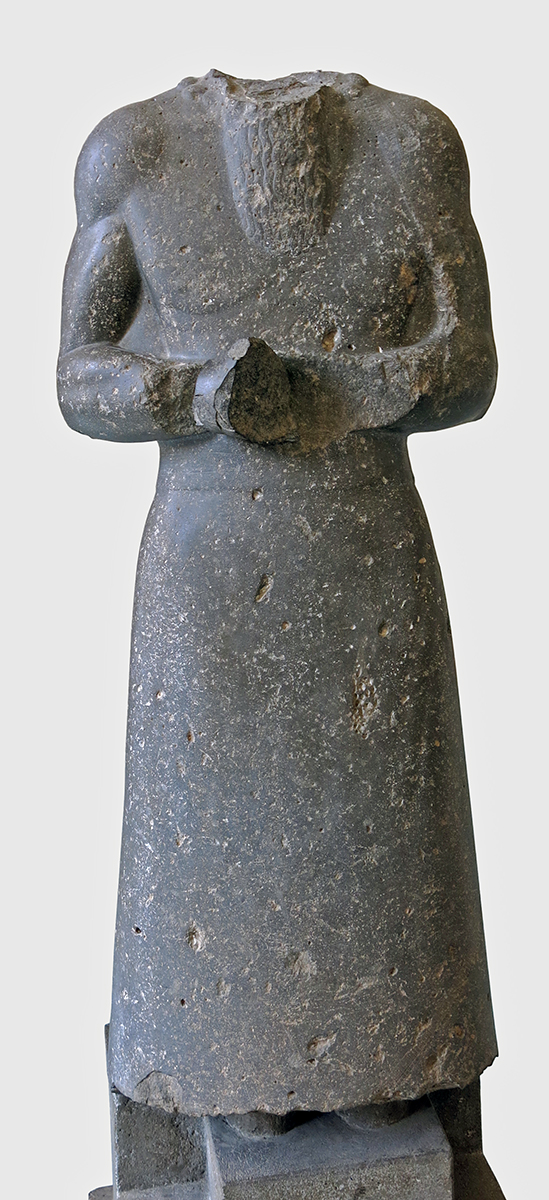
Statue of a ruler Circa 2 000 BC
This statue probably originates from the Younger Ishtar Temple which was partly refurbished by a local governor called Zariqum who was loyal to Amar-Sin, king of Ur. It is possible that the statue in fact represents this local ruler. He wears a fringed robe. The garment and the posture are identical with works of art from that period.
Catalog: Alabaster, Ashur
Photo: Don Hitchcock 2015
Source and text: Pergamon Museum, Berlin
Haematite weights, circa 2 000 BC - 1 600 BC.
Haematite is an iron ore found in Syria and Turkey. Weights of this shape were first introduced during the Old Babylonian period.
The weights are cylindrical, with almost square ends. The examples shown range from a full mina, about 500 gm, down to 3 shekels, about 25 gm.
For ME 117900, the diameter is 13 mm, length is 44 mm, weight is 25.6 gm.
For ME 117891, the diameter is 25 mm, length is 114 mm, weight is 496 gm.
Catalog: Haematite, ME 117891 - ME 117900.
Photo: Don Hitchcock 2015
Source: Original, British Museum
Text: © Card with the display at the British Museum, www.britishmuseum.org, © Trustees of the British Museum, CC BY-NC-SA 4.0.
Baked clay cone with inscription of King Sin-iddinam of Larsa, 1 849 BC - 1 843 BC
Photo: Don Hitchcock 2015
Source and text: Pergamon Museum, Berlin, recherche.smb.museum
Inscribed baked clay nail of King Ipik-ishtar (Ipiq-Ishtar) of Malgium, circa 1 770 BC.
The ancient city of Malgium is now known to be located at modern Tell Yassir.
These Sumerian clay nails or foundation pegs with cuneiform inscriptions were used by the Sumerians and other Mesopotamian cultures 4 000 years ago.
They were engraved, baked, and then inserted into the mud-brick walls to serve as evidence that the temple or building was the divine property of the god to whom it was dedicated.
Photo: Don Hitchcock 2015
Source and text: Pergamon Museum, Berlin, recherche.smb.museum
Additional text: joyofmuseums.com
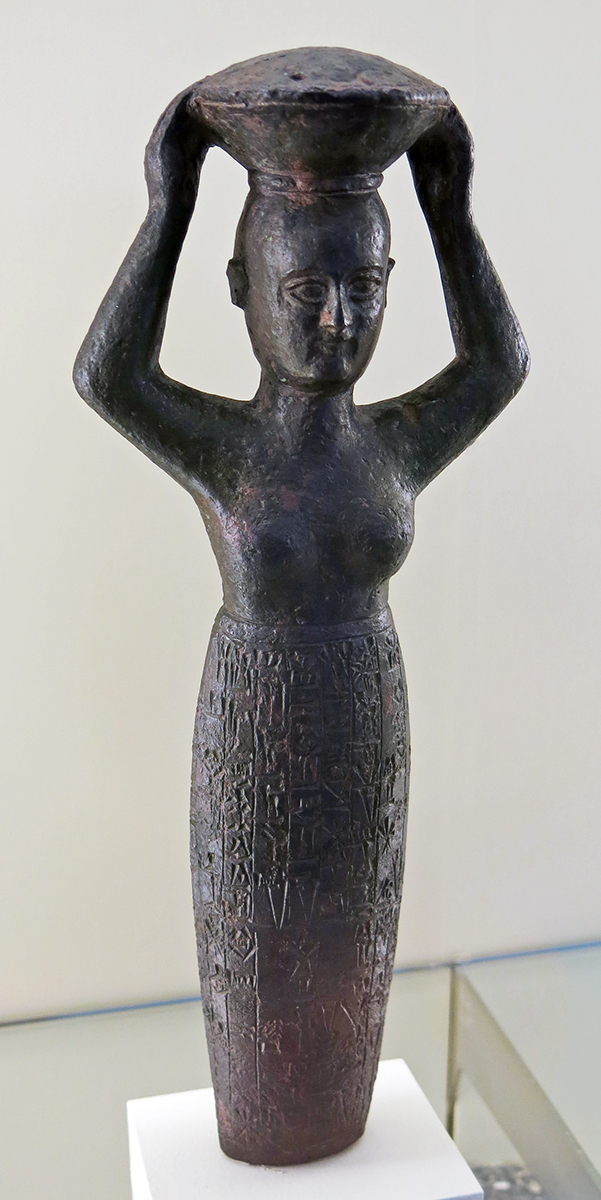
Founding figure of the Kudur-Mabuk (1 770 BC) in the form of a basket-carrier, Pergamonmuseum, Berlin.
Kudur-Mabuk ( Akkadian Ku-du-ur-ma-bu-uk ) was the father of sons Rim-Sin I and Warad-Sin and daughter En-ane-du, who according to ancient tradition was born in 1 764 BC, and who became an Entu priestess in Ur. He himself was the son of Simti-Silhak. The Elamite name as title Adda/Abu Ja-Emutbala (father of Jamutbal) and the self-identification as Adda KUR Martu (father of the Amurrite land) lead historians to make two assumptions about his origins.
According to more recent views, Dietz-Otto Edzard, for example, assumes that Kudur-Mabuk's father was an Amurrite military leader who later came into Elamite service and for this reason took on an Elamite name, without, however, denying his origins as an Amurrite. In the older versions the thesis of a complete origin from an Elamite ruling house is presented.
Kudur-Mabuk installed his sons Warad-Sin and Rim-Sin I as kings in Larsa, but personally renounced the title of king there.
Photo: Don Hitchcock 2015
Source and text: Pergamon Museum, Berlin, recherche.smb.museum, Wikipedia
Hammurabi's Babylonia, showing the Babylonian territory upon his ascension in 1 792 BC and upon his death in 1 750 BC. The river courses and coastline are those of that time period.
The assumed position of Malgium is shown, circa 100 km east of Kish.
Photo and text: MapMaster
Permission: GNU Free Documentation License, Version 1.2 or any later version
Uruk, in Sumer
In myth and literature, Uruk was famous as the capital city of Gilgamesh, hero of the Epic of Gilgamesh. Scholars identify Uruk as the biblical Erech (Genesis 10:10), the second city founded by Nimrod in Shinar.Text above: Wikipedia
Uruk was an ancient city in Mesopotamia, located in modern-day Iraq. It was one of the most important cities in ancient Sumer and is considered one of the earliest cities in the world. Uruk was first settled around 4 500 BC and became a major center of trade and culture by around 3 000 BC. It was home to some of the earliest examples of writing, including the famous Epic of Gilgamesh, which tells the story of a king who seeks immortality.
The city of Uruk was surrounded by a massive wall that was over 6 metres thick in some places and stood over 12 metres tall. The wall had several gates that were guarded by soldiers, and the city was home to several temples and palaces. The most famous of these was the Temple of Inanna, the goddess of love and war. The temple was decorated with elaborate mosaics and reliefs and was the center of religious life in Uruk.
Uruk had an advanced irrigation system, which allowed the city to produce a surplus of food. This surplus allowed for the growth of a complex social hierarchy, with priests, merchants, and warriors at the top of society. Uruk's wealth and power declined over time, and the city was abandoned around 300 BC.
Map of Uruk
Photo: Don Hitchcock 2015
Source and text: Adapted after a poster, Pergamon Museum, Berlin, recherche.smb.museum
An Uruk settlement
3 500 BC - 3 000 BC
Reconstruction of a room with household goods
Habuba Kabira-South, which was on the banks of the Euphrates, about 100 km east of the modern town of Aleppo.
Late 4th millennium BC, circa 3 500 BC - 3 000 BC.
Habuba Kabira (also Hubaba Kabire) at Tell Qanas is the site of an Uruk settlement along the Euphrates in Syria, founded during the later part of the Uruk period. It was about 1 300 km from the city of Uruk. The site is now mostly underwater due to the Tabqa Dam project. It consists of Habuba Kabira South, which is protoliterate, and Habuba Kabira North, which is protoliterate, Middle Bronze Age, Late Bronze Age, and Roman.
This reconstructed adjoining room of a house is intended to give an impression of the clay architecture and the equipment and vessels used for storing and preparing food. In addition to ceramic vessels such as spout bottles, four-eyelet vessels, bottles and bowls, saddle mills (grinding stones) as well as stone mortars and pestles can be seen. The shoulder vessels with red smoothed coating, cord eyelets,
Mock spouts and small handles may have served prestige purposes rather than utilitarian ones.
The houses of the late Turkic settlement were built close together. The basic type was the so-called central hall house, which was characterised by a central room in the middle and side rooms. The passages of the strictly symmetrically structured central hall always faced each other, while the side rooms were accessible through doors on the long sides.
In the late Turkic period, air-dried bricks with an almost square cross-section of 10 x 10 cm and a length of 25 cm were used. The clay extracted on site was very calcareous and had reddish areas. Lintels and doors were made of wood, the interior walls were whitewashed or covered with reed mats.
Photo: Don Hitchcock 2015
Source and text: Pergamon Museum, Berlin, recherche.smb.museum
The Inanna Temple at Uruk
1 450 BC - 1 400 BC
Moulded bricks from the facade of the Inanna Temple, in the Eanna District of Uruk.
During excavations in the precinct of the temple of Eanna at Uruk (southern Iraq), archaeologists discovered the remains of an isolated temple dedicated to the Sumerian goddess Inanna (Ishtar). From the evidence of a brick inscription, its construction can be dated to the reign of the Kassite ruler Kara-indash. The outer façade of the rectangular building, measuring 22.5 m by 17.5 m, stood until the Seleucid period (4th - 3rd centuries BC), and was articulated with niches. Fragments of moulded bricks found in the temple precinct were identified as belonging to the base of the edifice.
(left, lower) Head of a female water deity from the Karaindash facade.
Height 10cm, width 30 cm, depth 20 cm.
Catalog: Ceramic, Kassite period, VA 16740
Permalink: id.smb.museum/object/1744496/kopf-einer-weiblichen-wassergottheit-aus-der-sog--karaindasch-fassade
(right, upper)
Head of a male mountain deity from the Karaindash facade.
Height 10cm, width 30 cm, depth 20 cm.
Catalog: Ceramic, Kassite period, VA 16741
Permalink: id.smb.museum/object/1744497/kopf-einer-m%C3%A4nnlichen-berggottheit-aus-der-sog--karaindasch-fassade
Late 15th century BC, circa 1 450 BC - 1 400 BC.
Photo: Don Hitchcock 2015
Source and text: Pergamon Museum, Berlin, recherche.smb.museum
Additional text: artsandculture.google.com
Segments from the facade of the Inanna Temple built by the Kassite ruler
Kara-indash, Uruk, circa 1 413 BC.
In the northeast corner of the wall surrounding the Eanna Precinct at Uruk, archaeologists unearthed the remains of a small temple with a strictly symmetrical plan. There were bastion-like towers at all four corners of the building which stood on a platform measuring 22.5m x 17.Sm. The niched facade was made
of moulded, fired bricks.
The segment of it reconstructed in the museum incorporates a great many fragments of original bricks.
Standing male and female deities alternate in the niches. Life-giving water pours forth onto the earth from the vessels in their hands. The hump-like symbols on the projecting elements of the niched fa~de and on the garments of the male divinities refer to the mountainous region where the Kassites originated. An
inscription on the bricks names the Kassite ruler Kara-indash as the person who commissioned the structure.
The Kassites came into Mesopotamia from the mountains to the east, probably beginning about 2 000 BC.
By the mid-second millennium, they had achieved hegemony over Babylonia. 1he Kassites' worship of Inanna/Ishtar in proximity to the ancient Eanna Temple at Uruk documents their adoption and continuation of Babylonian traditions.
Inanna was an ancient Mesopotamian goddess of love, beauty, war, and fertility. She is also associated with sex, divine law, and political power. She was originally worshipped in Sumer under the name 'Inanna', and later by the Akkadians, Babylonians, and Assyrians under the name Ishtar.
She was known as 'the Queen of Heaven' and was the patron goddess of the Eanna temple at the city of Uruk, which was her early main cult centre. She was associated with the planet Venus and her most prominent symbols included the lion and the eight-pointed star.
Her husband was the god Dumuzid (later known as Tammuz) and her sukkal, or personal attendant, was the goddess Ninshubur (who later became conflated with the male deities Ilabrat and Papsukkal).
Text above: Wikipedia
Photo: Don Hitchcock 2015
Source and text: Pergamon Museum, Berlin, recherche.smb.museum
Additional text: Wikipedia
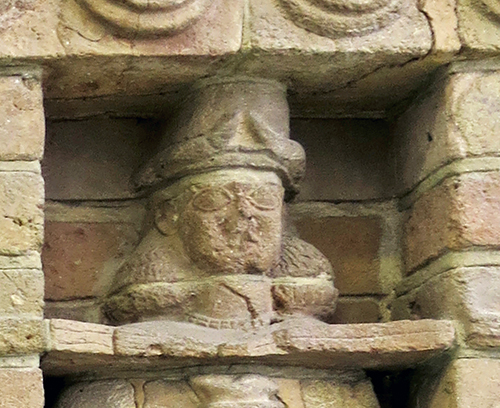
Note the horned crowns of the deities. This convention was still in use in Neo-Assyrian gypsum alabaster bas-reliefs commissioned by King Ashurnasirpal II (883 BC - 859 BC), more than 500 years later. However the convention by then had became a marker of tiered status.
In the Neo-Assyrian, one pair of horns as shown here was for minor deities, but two or three indicated increasingly superior status with the number of pairs of horns.
Photo and text: Don Hitchcock 2015
Source: Pergamon Museum, Berlin, recherche.smb.museum
Part of a cone mosaic panel from a podium facade in the courtyard of the Eanna Temple, circa 3 000 BC.
Several large cult buildings were discovered during excavations to the south-east and south-west of the ziggurat of King Ur-Nammu in the temple district of Eanna in Uruk. The architectural remains of these can be assigned to strata group VI-IV, one on top of the other. These relics of great architectural creations already characterise the period that can be equated with layers VI-IV as a high point of one of the oldest urban cultures in Mesopotamia. Also belonging to the late Uruk period, with its remarkable monumental architecture, was the invention of a writing system in connection with administrative accounting, which used numerals and pictograms and was written on clay tablets.
Part of a multi-tiered cult complex in Eanna, the temple precinct of the city goddess Inanna, is a rectangular courtyard flanked on the SW and NW sides by higher terraces. On the so-called pillar terrace in the NW rose an open transverse hall with four pairs of massive round pillars and four semi-round pillars. In the axis of the third *intercolumnium, the terrace had been extended to form a platform from which the courtyard could be reached via two side staircases (layer IVb). This platform façade emphasises the middle of the north-western side of the courtyard and is richly structured between the stairs to the courtyard. The front side is dominated by double stepped niches, the pillars in between were each decorated with two vertical incised lines. Cone mosaics fill the niche surface with colourful geometric patterns. The upper end of the platform façade is formed by four continuous rows of uncoloured clay cones with decorative shallow cupped heads, in dimensions significantly larger than the usual format (diameter 3 cm).
*intercolumnium: the proportional spacing between columns in a colonnade
The decorative patterns of the eight different cone mosaic fields in the niches are probably modelled on a wickerwork technique. The excavation finds are followed, starting from the left, by the surface-filling patterns zigzag (in horizontal orientation), rhombuses (beginning below as triangles), triangles, triangles, rhombuses, triangles, zigzag (in vertical orientation, beginning as triangles below) and rhombuses. The compositional rules of the decoration, the sequence and the alternation of statically and dynamically perceived patterns can be regarded as preliminary stages to the cone mosaic decoration of the younger pillared hall in Uruk (stage IVa). [Ralf Bernhard Wartke]
Height 150 cm, width 315 cm.
( Note that in German language descriptions of these walls, the cones are usually referred to as 'pins'. Pin is German for Pine tree, so 'drawing a long bow', it may be an alternate word for cones, as in the english expression 'pine cones'. Also, 'pin' in German can also mean 'peg' or 'plug', a more likely explanation. To further complicate matters, machine translation often changes the German 'stift' to the English 'pen' instead of 'peg' which is a better translation in this case - Don )
Catalog: Ceramics, plaster, VA 10997
Photo: Don Hitchcock 2015
Source: Pergamon Museum, Berlin, recherche.smb.museum
Text: Google Arts and Culture, Ralf Bernhard Wartke
Cone mosaic panel from Eanna Temple, circa 3 000 BC.
Cone mosaic in the temple precinct Eanna of the city goddess Inanna of Uruk.
In the late 4th millennium BC The construction of the sacred precinct Eanna in Uruk reached its peak. In addition to cult houses, round pillar halls with cone mosaics, bathing facilities and a so-called 'reception palace', a large courtyard with terraces was used for the cult worship of the goddess Inanna. On the north-west terrace, which was reached by two side flights of stairs on a dais-shaped extension, rose an open transverse hall with four pairs of massive round pillars and four semi-round pillars.
From the middle of the 4th millennium BC The cone-mosaic technique became a characteristic architectural element in the cult and representational buildings of the Eanna district. 10 cm long cones made of fired clay or plaster were pressed close together into the thick clay plaster of the walls. The heads of the cones were mostly painted black, red and white. In some cases, larger uncoloured ceramic or stone pins were also used. The resulting decorative patterns show rhombuses, triangles as well as band and zigzag shapes. Apparently, the design was based on models from wickerwork and textile production. In addition to the decorative effect, the cladding of the adobe walls with cone mosaics also had a structural function. The outer wall areas and pillars designed in this way were protected from weathering by wind or water thanks to the material strength of the cones.
Height 175 cm, length 1100 cm (11 metres), depth 100 cm.
Catalog: Ceramics, plaster, VA 11000
Photo: Don Hitchcock 2015
Source: Pergamon Museum, Berlin, recherche.smb.museum
Text: Google Arts and Culture, Ralf Bernhard Wartke
Three footed marble bowl, Uruk.
Circa 3 500 - 3 000 BC.
Photo: Don Hitchcock 2015
Source and text: Museum Card, Pergamon Museum, Berlin, recherche.smb.museum
Fragment of a vessel depicting the goddess Nisaba (?) and an inscription of Entemena, ruler of Lagash.
Circa 2 430 BC - 2 375 BC.
Height 251 mm, width 186 mm, thickness 40 mm, weight 3310 gm.
Unfortunately, only the fragment shown has survived from a stone vessel that was once more than 40 cm in diameter. Nevertheless, this piece is both an example of the advanced processing technique of objects made of hard rock and of a special type of relief. In accordance with the sequence of moving pictorial narratives that predominated in relief art, figures in profile were usually preferred. The figure preserved here, on the other hand, is at least partially clearly depicted en face, a relatively rare occurrence in Mesopotamian flat art. However, only the upper part of the body is turned toward the viewer, as can be seen from the rest of a seat that was formally pushed into the figure on the left edge of the fragment. The image of the woman initially appears stocky and disproportionate, unless the sitting position explains the gross stoop.
The overall picture in terms of posture and equipment shows a typical goddess representation with a short-sleeved undergarment and a cloak lying over the shoulder. While the facial cut remains within the bounds of the usual, the rich headdress, both natural and artificial, catches the eye. The goddess wears a cap befitting her dignity with a pair of horns, in addition with a mouthless face mask, also horned, and fitted with feathers. The overflowing hair is braided into four visible pigtails that end in curls. As is often the case with such representations, symbols that can be interpreted as poppies grow out of the shoulders. In her right hand she carries a bunch of dates. Designated in this way as a deity of vegetation, the symbolism alone does not allow any statement about her name. The inscription visible on the edge of the vessel and on both sides of the shoulders does not provide any certainty either, since it has only been preserved in fragments. The most common interpretation of the depiction as a depiction of the grain goddess Nisaba is ultimately not provable, but not improbable. There is no doubt that the vessel is a sacred object, for which the image of the goddess and the rest of the dedicatory inscription stand. From comparisons with other inscriptions of this period, only Entemena of Lagash can be considered as the donor, since the surviving section largely coincides with his inscriptions, especially for the establishment of a brewery for the city god Ningirsu. A connection between the depiction of a grain goddess with bunches of dates - an important part of beer production - and the brewery of Ningirsu, which is documented by inscriptions and in which the vessel could have been used for ritual purposes, can only be assumed. [Joachim Marzahn].
Catalog: Basalt, unknown provenance, VA 07248
Photo: Don Hitchcock 2015
Source and text: Museum Card, Pergamon Museum, Berlin, recherche.smb.museum, CC BY-NC-SA @ Vorderasiatisches Museum
Bowl with a notched edge, of calcareous sinter, from Uruk, presented on a modern ivory coloured support.
Calcareous sinter is a freshwater calcium carbonate deposit, also known as calc-sinter. Deposits are characterised by low porosity and well-developed lamination, often forming crusts or sedimentary rock layers.
Circa 4 000 - 3 000 BC.
Height 34 mm, diameter 97 mm (mouth), 35 mm (bottom), thickness 8 mm, weight 130 gm.
Catalog: Calcareous sinter, Uruk, VA 14524
Photo: Don Hitchcock 2015
Source and text: Museum Card, Pergamon Museum, Berlin, recherche.smb.museum, CC BY-NC-SA @ Vorderasiatisches Museum
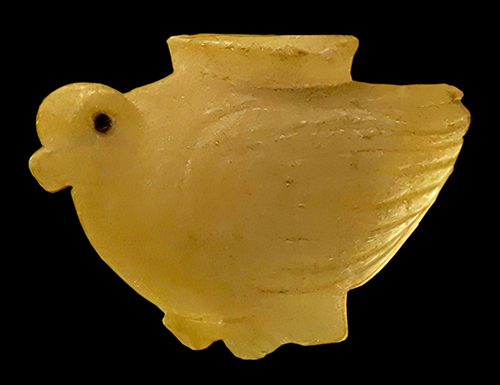
Vessel in the shape of a dove.
This small alabaster vessel has the shape of a seated dove. The base of the bottle consists of the two wedge-shaped feet of the dove. The vessel opens at the top and has a short, circular neck that could be closed with a stopper. The lip of the bottle is irregular in shape and slightly curved outwards.
The inner cavity of the vessel was created by chiseling out the stone. The bird's wings consist of several horizontal incised lines that were worked into the side of the vessel's belly.
The head of the dove was carved in a rounded, plastic, manner in contrast to the tapered tail feathers.
The remains of bitumen preserved in the eye sockets are evidence of former deposits. The bottle was probably used to store oils or ointments.
Height 40 mm, length 65 mm, diameter (mouth) 25 mm, weight 80 gm.
Circa 3 500 - 3 000 BC.
Catalog: Alabaster, Uruk, Quadrant K 17, on the floor of the White Temple, in the south stairwell between the north-east wall and the stair stringer (support for the treads and risers), VA 10357
Photo: Don Hitchcock 2015
Source and text: Museum Card, Pergamon Museum, Berlin, recherche.smb.museum, CC BY-NC-SA @ Vorderasiatisches Museum
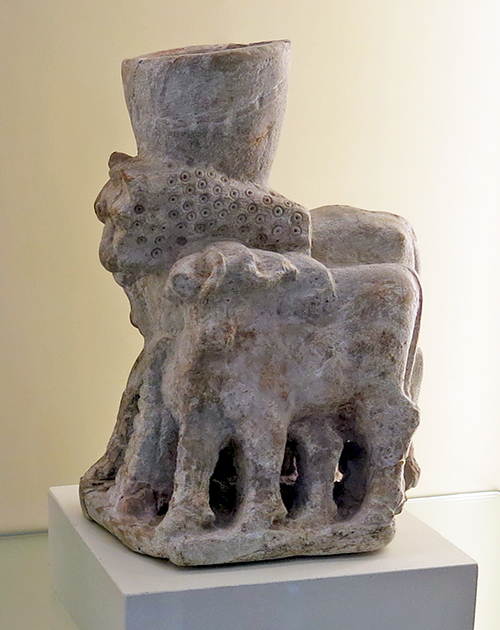
Skulpturbecher, circa 3 000 BC.
Literally 'sculpture mug', these objects survive in modern times as objects such as British 'toby mugs'.
The animals are difficult to identify, but there may be two lions and a sheep.
Photo: Don Hitchcock 2015
Catalog: Soapstone sculpture mug, unknown provenance.
Source and text: Museum Card, Pergamon Museum, Berlin, recherche.smb.museum, CC BY-NC-SA @ Vorderasiatisches Museum
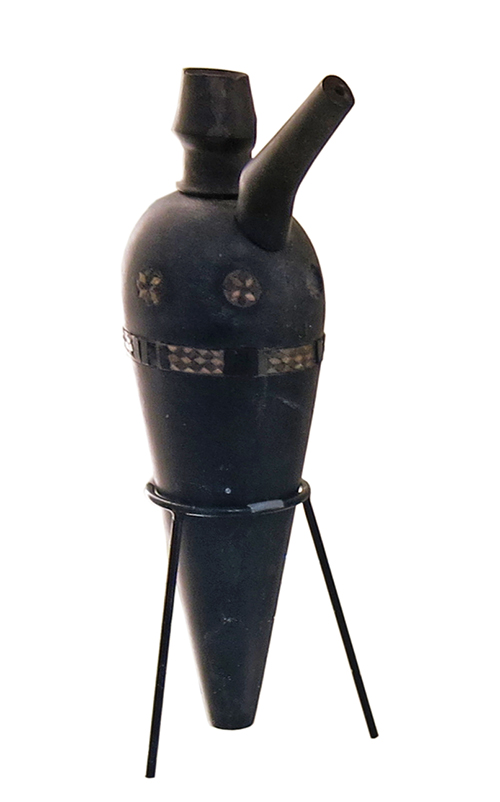
Spouted libation vessel in bituminous limestone, with mosaic inlays, circa 3 500 BC - 3 000 BC.
Jemdet Nasr/Early Dynastic Period.
The Jemdet Nasr Period is an archaeological culture in southern Mesopotamia (modern-day Iraq). It is generally dated from 3 100 BC to 2 900 BC. It is named after the type site Tell Jemdet Nasr, where the assemblage typical for this period was first recognised. Its geographical distribution is limited to south-central Iraq. The culture of the proto-historical Jemdet Nasr period is a local development out of the preceding Uruk period and continues into the Early Dynastic I period.
Bituminous limestone is limestone impregnated and sometimes deeply coloured with bituminous matter derived from the decomposition of animal and plant remains entombed within the mass or in its vicinity.
Height 215 mm, diameter 63 mm (max.), diameter 14 mm (bottom), thickness 8 mm, weight 250 gm.
From the Eanna ziggurat, Oe 16-3, located in front of the south-western façade of the ziggurat.
Photo: Don Hitchcock 2015
Catalog: Bituminous limestone, Uruk, VA 11055
Source and text: Museum Card, Pergamon Museum, Berlin, recherche.smb.museum, CC BY-NC-SA @ Vorderasiatisches Museum
Additional text: van Ess & Fassbinder (2019), Wikipedia
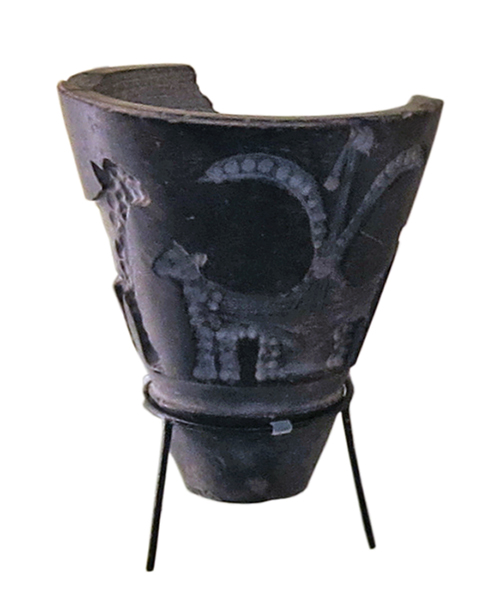
Fragment of a jar with mosaic inlays, place of discovery unknown.
( The mosaics appear to include images of fanciful cats - Don )
Circa 2 000 - 2 500 BC.
Photo: Don Hitchcock 2015
Source and text: Museum Card, Pergamon Museum, Berlin, recherche.smb.museum, CC BY-NC-SA @ Vorderasiatisches Museum
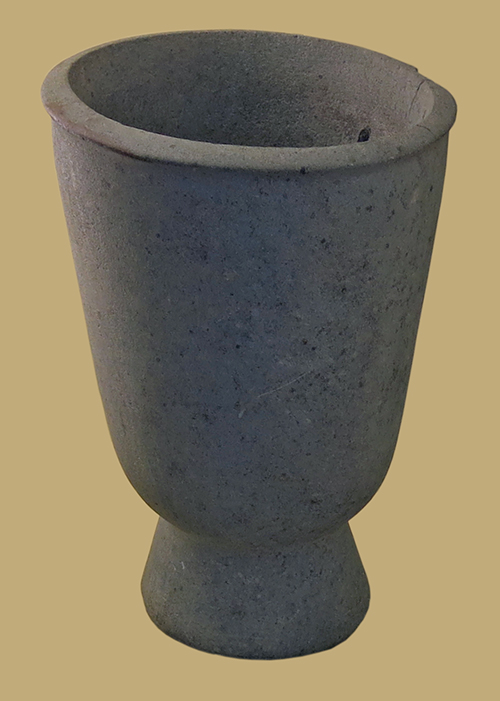
Footed cup in diabase, an intrusive igneous rock with the same mineral composition as basalt. Diabase cools moderately quickly under basaltic volcanoes, like those at mid-oceanic ridges, when magma moves up into fractures and weak zones below a volcano.
Jemdet Nasr/Early Dynastic Period.
Circa 3 300 - 2 700 BC.
Height 220 mm, diameter of mouth 180 mm, diameter of foot 120 mm, thickness 10 mm.
Catalog: Diabase, Uruk, quadrant Pa 16-2, VA 11061
Photo: Don Hitchcock 2015
Source and text: Museum Card, Pergamon Museum, Berlin, recherche.smb.museum, CC BY-NC-SA @ Vorderasiatisches Museum
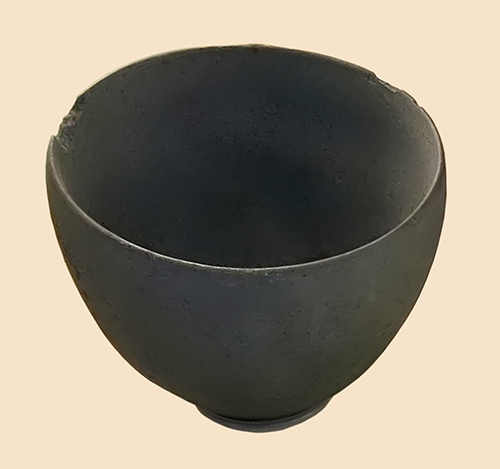
Stone bowl in diabase, resting on a modern support.
Circa 4 900 BC - 3 100 BC.
Height 95 mm, diameter mouth 116 mm, diameter base 42 mm, thickness 10 mm, weight 660 gm.
Catalog: Abu Ğidah (?) southeast of Uruk, direction Larsa, VA 14523
Photo: Don Hitchcock 2015
Source and text: Museum Card, Pergamon Museum, Berlin, recherche.smb.museum, CC BY-NC-SA @ Vorderasiatisches Museum
Lenticular drill
These drills used either high speed or high pressure to grind out the inside of a solid jar.
Circa 3 000 BC.
The grinding object was a lens shaped piece of hard quartzite, with two depressions, one on each side of the stone. These provided a purchase for the ends of a double arced wooden centrepiece, which was either rotated quickly back and forth by a bow and cord, or more slowly by hand with two fairly heavy stones attached to the handle, as shown.
Photo: Don Hitchcock 2015
Source and text: Museum Card, Pergamon Museum, Berlin, recherche.smb.museum, CC BY-NC-SA @ Vorderasiatisches Museum
Alabaster bowl in the form of a snail.
Circa 2 500 BC - 2 000 BC.
Found at Tell Fara, ancient Shuruppak. Shuruppak, 'the healing place', was an ancient Sumerian city situated about 55 km south of Nippur on the banks of the Euphrates in Iraq's Al-Qādisiyyah Governorate. Shuruppak was dedicated to Ninlil, also called Sud, the goddess of grain and the air.
The site extends about a kilometre from north to south. The total area is about 120 hectares, with about 35 hectares of the mound being more than 3 metres above the surrounding plain, with a maximum of 9 metres.
Shuruppak became a grain storage and distribution city and had more silos than any other Sumerian city. The earliest excavated levels at Shuruppak date to the Jemdet Nasr period about 3 000 BC; it was abandoned shortly after 2 000 BC. Erich Schmidt found one Isin-Larsa cylinder seal and several pottery plaques which may date to early in the second millennium BC. Surface finds are predominantly Early Dynastic.
Height 65 mm, length 170 mm, width 94 mm, weight 850 gm.
Catalog: Alabaster, Tell Fara, VA 09921
Photo: Don Hitchcock 2015
Source and text: Museum Card, Pergamon Museum, Berlin, recherche.smb.museum, CC BY-NC-SA @ Vorderasiatisches Museum
Additional text: Wikipedia
Statuette of Ur-ningirsu
Circa 2 120 BC, Ur III period, from Lagash.
This small statuette of a bearded man is identified by the cuneiform inscription on the back: 'Dedicated to the god Ningizzida, his god, by Ur-ningirsu, priest-prince of Lagash, son of Gudea, priest-prince of Lagash.'
The text indicates that it was the ruler who dedicated this portrait of himself to the temple - in continual worship of Ningizzida, a Sumerian divinity with chthonic attributes. (He is the god of the underworld and also guardian of the gate of heaven.)
The upper body is all that survives of the statuette, and the nose and the mouth amid the long beard look as if they have been deliberately damaged. Ur-ningirsu wears a smooth garment with decorated braid trimming which leaves the right shoulder bare. He has his hands clasped in prayer.
The statuette has the formal qualities of Neo-Sumerian sculpture. Characteristic here are the ample hair and its stereotypical representation in individual locks, the strong eyebrows with their hatched rendering, and the schematic folds of the robe; equally characteristic are the lively modelling of the face and the gentle rounding of the limbs and torso. The play of light on the carefully polished surface of the hard stone emphasises the statuette's plastic qualities.
Width 125 mm, height 180 mm, depth 75 mm, weight 1850 gm.
Catalog: Diorite, Lagash, VA 08790, ISIL no.: DE-MUS-815718
Photo: Don Hitchcock 2015
Source: Pergamon Museum, Berlin, recherche.smb.museum, CC BY-NC-SA @ Vorderasiatisches Museum
Text: Google Arts and culture ( apparently adapted from the comments of the curator, Ralf B. Wartke - Don )
The Royal Cemetery of Ur, circa 3 000 BC - 2 000 BC
The Royal Cemetery of Ur, in one of the most important Southern Mesopotamian cities, provides us with an insight into royal afterlife. Sixteen burials of immense wealth transmit a general idea of the ritual following death.
The deceased were buried together with their attendants, soldiers, musicians and ass-drawn chariots as well as precious grave goods, all considered necessary provisions for the netherworld gods and the deceased's own needs in the afterlife.
Photo: Woolley (1934)
Source: archive.org/details/urexcavations191319join/page/n551/mode/1up?view=theater)
Arrangement of Jewellery
This bust suggests the original arrangement of the jewellery worn by female attendants buried in the royal graves. The headdress consists of two gold ribbons, a diadem of gold leaves with lapis lazuli and carnelian beads and three gold rosettes on modern mounts.
The jewellery around the neck consists of a collar of gold and lapis lazuli triangular spacer beads. Necklaces and beads of carnelian, gold, silver and lapis lazuli in different shapes complete the outfit. A silver pin with a lapis lazuli head could have helped to secure the cloak.
( The two large double 'boat' shaped gold ear-rings on this bust, diameter 73 mm, BM 122341, are superbly made, and display not just the technical ability of the goldsmith, but their artistry. I feel sure the owner valued the original earrings highly - Don )
Catalog: Ur/Tell el-Muqajjir (Iraq) Graves PG 55, PG 1237 ('Great Death Pit'), PG 1402, about 2 600 - 2 400 BC. London, British Museum, Department of the Middle East, on long-term loan.
Photo: Don Hitchcock 2015
Source and text: Pergamon Museum, Berlin, recherche.smb.museum
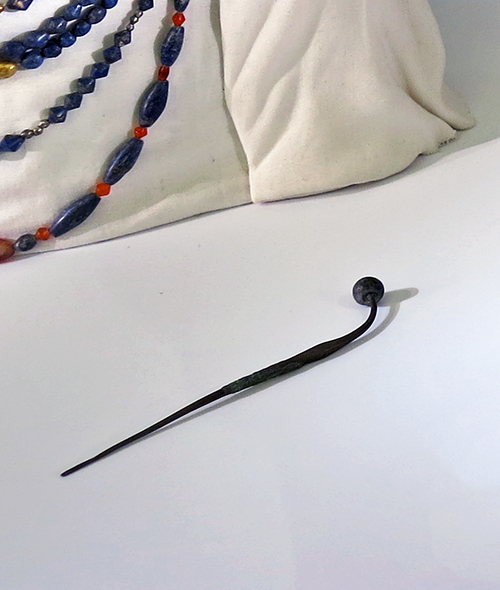
Arrangement of Jewellery
This silver pin with a lapis lazuli head could have helped to secure the cloak in the bust shown above.
Catalog: Ur/Tell el-Muqajjir (Iraq) Graves PG 55, PG 1237 ('Great Death Pit'), PG 1402, circa 2 600 BC - 2 400 BC. London, British Museum, Department of the Middle East, on long-term loan.
Photo: Don Hitchcock 2015
Source and text: Pergamon Museum, Berlin, recherche.smb.museum
Arrangement of Jewellery
These two gold ribbons are part of the headdress of the bust above.
One of the ribbons has the number 122339 painted on it, which is the British Museum Big Number for the find, which enables us to gain a little more information:
There are three such ribbons listed in the find from the BM, but it would appear that B and C were originally one ribbon, since the overall length of one of the ribbons is given as 87 cm, the sum of B and C's length:
A: Length 162 cm, width 9 mm, thickness 1 to two mm, weight 31.7 gm.
B: Length 52 cm, width 8 mm, thickness 1 to two mm, weight 11.3 gm.
C: Length 35 cm, width 8 mm, thickness 1 to two mm, weight 8.1 gm.
Catalog: Ur/Tell el-Muqajjir (Iraq) Graves PG 55, PG 1237 ('Great Death Pit'), PG 1402, about 2 600 - 2 400 BC. London, British Museum, Department of the Middle East, on long-term loan.
Photo and additional text: Don Hitchcock 2015
Source and text: Pergamon Museum, Berlin, recherche.smb.museum
Text from the British Museum: http://www.britishmuseum.org/, © Trustees of the British Museum, CC BY-NC-SA 4.0
Cylindrical stone jars
Bowl, vase, circa 2 600 - 2 400 BC
Silver pin with a lapis lazuli head.
Weapons:
Copper alloy spearhead engraved with a bull-leg symbol, four-sided, length 40 cm.
Copper alloy spearhead with tang.
Harpoon head with a long barb and a tubular base.
( Note that sumerianshakespeare.com observes that while Woolley called them harpoons, their blunt points suggest a different purpose. They were perhaps used as pole weapons. The blunt ends could be used to push against the enemy's shields, without becoming embedded in them, to push back their lines. The barbed end of the weapon could be used to hook onto the rim of an enemy's shield and pull it down, thus leaving him unprotected, to be finished off with a sword. - Don )
Copper alloy axe head, cast with a vertically curved blade.
Catalog: Calcite, copper alloy, silver, lapis lazuli, Ur/Tell el-Muqejjir, (Iraq), Royal Cemetery, long-term loan from the British Museum, Department of the Middle East.
Photo: Don Hitchcock 2015
Source and text: Pergamon Museum, Berlin, recherche.smb.museum
Additional text: sumerianshakespeare.com/117701/118301.html
Cylinder seal and modern impression
Circa 2 600 BC - 2 400 BC.
White stone.
Contest scene with a hero and a leopard attacking a bull fought by a lion. Another lion fights a bull-man. In the field are a goat, scorpion and antelope.
BM description:
Large, cream marble or shell cylinder seal with patches of yellow/brown and grey/green; contest frieze; hero with stick and knife before leopard which attacks bull which is also being fought by lion. Another lion (crossed) fights bull-man. In field: goat, scorpion, antelope.
Diameter 32 mm, height 43 mm.
Catalog: Ur/Tell el-Muqajjir (Iraq) Grave PG 43, circa 2 600 BC - 2 400 BC.
Catalog BM: Marble? Shell ? BM/Big number 120530
Photo and additional text: Don Hitchcock 2015
Proximal source and text: Pergamon Museum, Berlin, recherche.smb.museum
Source: London, British Museum, Department of the Middle East, on long-term loan.
Text from the British Museum: http://www.britishmuseum.org/, © Trustees of the British Museum, CC BY-NC-SA 4.0
Purpose and Use of Cylinder Seals
Authentication and Identity: Cylinder seals often bore the unique mark of their owner, functioning as a form of personal identification. They were used to stamp an individual’s or official’s mark onto documents, which helped authenticate the seal's owner and their authority.
Administrative and Legal Functions: In administrative contexts, seals were used to impress official documents, such as contracts, decrees, and legal agreements. This served as a means of verifying the document’s legitimacy and the authority behind it.
Personal and Decorative Use: Besides their administrative function, cylinder seals were also used for personal and decorative purposes. They could be intricately carved with images and symbols that reflected the owner’s status, beliefs, or achievements.
Securing Containers: Seals were also used to secure containers, such as jars or boxes. Impressions from the seal on the clay used to close the container served as a deterrent against tampering and indicated whether the container had been opened.
How They Worked: Cylinder seals were rolled over soft clay to create a continuous impression. The designs could include detailed images, inscriptions, and symbols. When the seal was rolled over the clay, it created a raised or engraved pattern that could be used for various purposes as described. These seals were crucial in administrative and legal systems in ancient Mesopotamia, playing a key role in the daily functioning of their complex societies.
Babylon
Esagila (house of the main elevation), the ground level Marduk temple, is shown here to the right of the street from the bridge over the Euphrates.
Etemenanki (House of the Foundation of Heaven and Earth), the approx. 92 m high step tower.
The small high temple on the tower is said to have housed a bed and table for Marduk. The model of the tower follows the reconstruction proposal by W. Andrae / G. Martiny
State at the beginning of the 6th century BC
Koldewey directed the excavation of Babylon from 1899 through 1914, using comparatively modern archaeological techniques. The site had been identified a century earlier by Claudius James Rich.
More than 200 people worked on the site daily, year round, for fifteen years.
Photo and text: Koldewey (1914)
Additional text: Wikipedia
This view of the model of Babylon shows the interior of the peribolos, defined as a court enclosed by a wall, especially one surrounding a sacred area such as a temple, shrine, or altar.
The Esagila, a 'ground level' temple dedicated to Marduk, the protector god of Babylon, is in the foreground, with the Etemenanki, the Tower of Babel, in the background.
Etemenanki was a ziggurat dedicated to Marduk. It is now in ruins, and is located about 90 kilometres south of Baghdad, Iraq.
Photo: Don Hitchcock 2015
Source: Pergamon Museum, Berlin, recherche.smb.museum
Additional text: Wikipedia
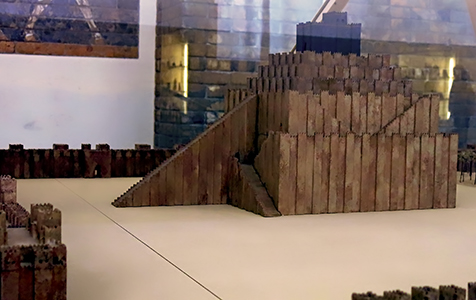
Model of Etemenanki, the Marduk temple in Babylon, also known as the Tower of Babel.
Babylon was destroyed in 689 BC by Sennacherib, who claims to have destroyed the Etemenanki. It took 88 years to restore the city. Work was started by the Assyrian king Esarhaddon, and continued under Nabopolassar, followed by his son Nebuchadnezzar II who rebuilt the ziggurat.
The city's central feature was the temple of Marduk (Esagila), with which this Etemenanki ziggurat was associated.
Photo: Don Hitchcock 2015
Source: Pergamon Museum, Berlin, recherche.smb.museum
Text: Wikipedia
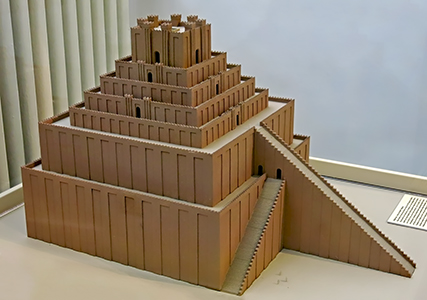
Another, more detailed version of Etemenanki.
The stepped tower of Babylon was dedicated to the city god Marduk. The model was made by Hans-Jörg Schmid in 1991. This building, in Akkadian called zikkurrat, might be the historical background for the biblical story of the 'Tower of Babel'.
In ancient Near Eastern thought, this stair-like structure connected heaven and earth, as the translation of the Sumerian name Etemenanki, 'House, foundation of heaven and earth' suggests.
To what extent the model represents the correct appearance of the building is debatable, as only the foundations of this building are preserved.
Catalog: VAG 01284
Photo: Don Hitchcock 2015
Artist: Hans-Jörg Schmid, 1991.
Source and text: Pergamon Museum, Berlin, recherche.smb.museum
The 'Esagila' tablet
( This gives the height of Etemenanki as 91 metres, now believed to be no more than 66 metres, see below - Don )
Copy of a neo-Babylonian document written in Uruk from an original by Borsippa, Tablet of Esagila.
Inscription: Measurements of the Esagil and the Etemenanki.
Height 181 mm, width 100 mm, thickness 24 mm.
Date of the original tablet: Neo-Babylonian (Borsippa) (604 BC - 539 BC)
Date of creation / manufacture of this copy: Seleucid: Seleucos I (around 229 BC; year 83 of the Seleucids) (305 BC - 281 BC)
Provenance: Uruk archives of Eanna
Text above: © Louvre Museum, Paris, France, https://collections.louvre.fr/
Photo: © Raphaël Chipault, Louvre Museum, Paris, France, https://collections.louvre.fr/
Source: Original, Louvre Museum, Paris, France, https://collections.louvre.fr/
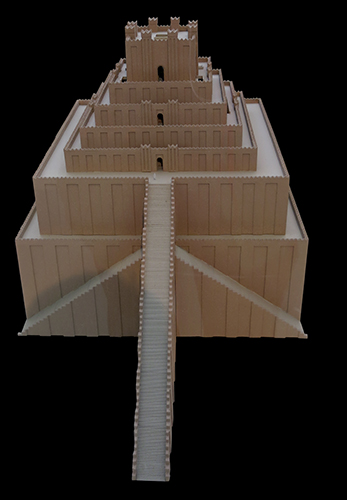
Modern scholars dispute the claim by the ancient Babylonian source (the 'Esagila' tablet) that the Etemenanki was 91 metres tall. 'The modern interpretation of the text of the Esagila tablet raises a serious technical problem: the excessive height of the first two terraces of the ziggurat and the total height of the building defy the laws of statics and compressive strength of a material such as raw earth brick.
Even allowing variation in the design of a six-level terraced structure, at that height, the compression stress on the structure would be somewhere around two to three times as much as comparable structures of the same time period. Fenollós J. et al. (2005) propose that, assuming the structure did indeed use a six-level terrace design as depicted in the Tower of Babel stele, the ziggurat was probably closer to 54 metres tall.
The temple at the top contributed another 12 metres in height, for a total height of 66 metres.
Photo: Don Hitchcock 2015
Artist: Hans-Jörg Schmid, 1991.
Text: Wikipedia
Plan of Esagila and Etemenanki.
Photo and text: Koldewey (1914)
Plan of the ruins of the city of Babylon
Photo: Koldewey (1914)
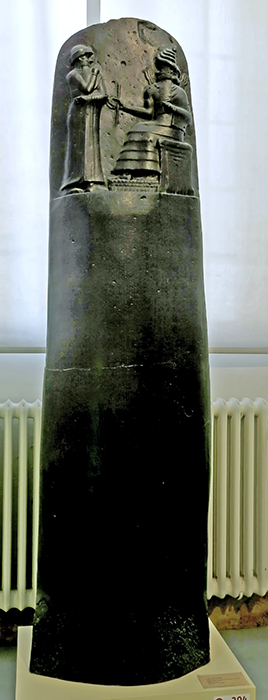
Codex Hammurabi
Stele of the Law of King Hammurabi of Babylon, 1 792 BC - 1 750 BC.
The code of Hammurabi is a Babylonian legal text composed circa 1 75 5– 1 750 BC. It is the longest, best-organised, and best-preserved legal text from the ancient Near East. It is written in the Old Babylonian dialect of Akkadian, purportedly by Hammurabi, sixth king of the First Dynasty of Babylon. The primary copy of the text is inscribed on a basalt or diorite stele 225 cm tall. The stele was discovered in 1901, at the site of Susa in present-day Iran, where it had been taken as plunder six hundred years after its creation. The text itself was copied and studied by Mesopotamian scribes for over a millennium. The stele now resides in the Louvre Museum.
The top of the stele features an image in relief of Hammurabi with Shamash, the Babylonian sun god and god of justice. Below the relief are about 4,130 lines of cuneiform text: one fifth contains a prologue and epilogue in poetic style, while the remaining four fifths contain what are generally called the laws. In the prologue, Hammurabi claims to have been granted his rule by the gods "to prevent the strong from oppressing the weak". The laws are casuistic, expressed as 'if ... then' conditional sentences. Their scope is broad, including, for example, criminal law, family law, property law, and commercial law.
Modern scholars responded to the Code with admiration, at its perceived fairness and respect for the rule of law, and at the complexity of Old Babylonian society. There was also much discussion of its influence on the Mosaic Law. Scholars quickly identified lex talionis, the "eye for an eye" principle, as underlying the two collections. Debate among Assyriologists has since centred around several aspects of the Code: its purpose, its underlying principles, its language, and its relation to earlier and later law collections.
Despite the uncertainty surrounding these issues, Hammurabi is regarded outside Assyriology as an important figure in the history of law, and the document as a true legal code. The U.S. Capitol has a relief portrait of Hammurabi alongside those of other lawgivers, and there are replicas of the stele in numerous institutions, including the headquarters of the United Nations in New York City and the Pergamon Museum in Berlin.
Photo: Don Hitchcock 2015
Source and text: Facsimile, Pergamon Museum, Berlin, recherche.smb.museum
Additional text: Wikipedia
Original is in the Louvre Museum, Paris
Votive statue dedicated by Prince Puzur-Eshtar / Puzur-Ishtar of Mari, taken as booty to Babylon.
Left: complete reassembled replica.
Right: original of the head.
Circa 1 950 BC.
This replica consists of casts of the diorite head (in Berlin) and of the body and base (Archaeological Museum, Istanbul).
Complete height 193 cm
This over-lifesized statue is one of the few large sculptures preserved from the ancient Near East. The head was broken from the body in an act of vandalism in antiquity.
Though separated, both pieces fortuitously survived so that the statue is nearly complete. The head was acquired by purchase for the collection before 1899 while the body came to light during excavations at Babylon and eventually reached Istanbul. Thanks to an exchange of casts, both museums can exhibit the complete sculpture.
According to the inscriptions below the right hand and above the hem of the garment, the sculpture was made as a votive gift. The name Puzur-Eshtar, Prince of Mari, is mentioned twice, but since the figure's headgear is the horned cap of a deity, the statue
cannot depict the mortal prince. The clasped hands of the figure and the text make it certain that the statue once belonged to the inventory of a temple, but where the temple stood is not known, despite the mention of Mari in the title of the prince. Like many
other monuments, the statue will have been looted from its original site and carried off as booty to Babylon in antiquity.
Photo: Don Hitchcock 2015
Source and text: Pergamon Museum, Berlin, recherche.smb.museum
Clay cylinder building deed with an inscription mentioning King Warad-Sin of Larsa. Isin-Larsa period, 1834 BC - 1823 BC, from Babylon.
At this time, from 2000 BC to 1800 BC, southern Mesopotamia was dominated by the cities of Isin and Larsa.
Photo: Don Hitchcock 2015
Source and text: Pergamon Museum, Berlin, recherche.smb.museum
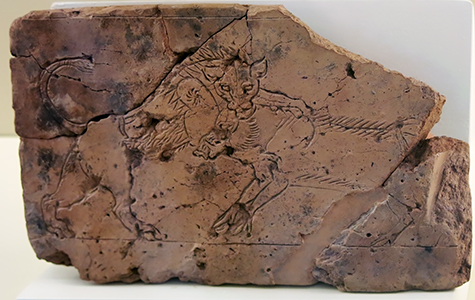
Incised drawing of a lion attacking a wild boar.
Babylon, Kassite period.
2nd half of 2nd millennium BC
Photo: Don Hitchcock 2015
Source and text: Pergamon Museum, Berlin, recherche.smb.museum
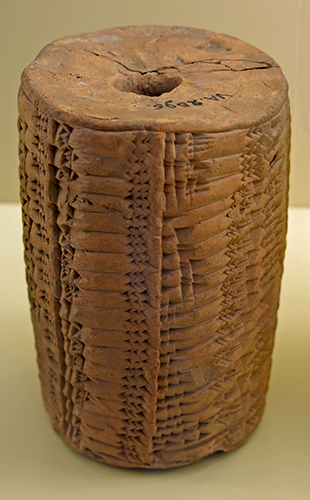
Old Babylonian baked clay cylinder.
The Akkadian cuneiform inscription mentions a capacity table. 18th-16th century BC.
Photo: Don Hitchcock 2015
Source: Pergamon Museum, Berlin, http://www.smb-digital.de/
Text: Wikipedia
Stele, or kudurru, protecting a royal land grant, from Babylon.
Found in a stela workshop, the deity symbols are partly unfinished, and there is no inscription.
Middle 12th century BC.
The kudurru is from Babylon, Merkes 26 g 2, + 3.00 m. In a room where there is also 'a quantity of
of semi-precious stone pieces and shells together with finished beads of the same
material ..... The room was apparently the workshop of a stone cutter'.
Yellowish grey limestone. Height 50cm, breadth 20-36 cm, thickness 9 cm.
Plate-shaped stone without inscription. Relief images on the upper rim and in four registers on one broadside.
On the upper rim are astral images.
In the uppermost register are a big cat and a jackal(?), both squatting on low smooth pedestals, and a goatfish.
In the second register is a serpent-dragon with spade, a second with stylus, a bird with head turned back, a dog and a calf with a bundle of lightning, all on low, smooth pedestals.
In the third register are a lion staff, a double lion's club, a bird on pole, a triangular standard with pennant, a bird, a smooth rectangle, all standing on small decorated plinths, and a recumbent rectangle with a 'bundle' on a smooth pedestal.
In the lowest register a bow-shooting centaur, a standing lion dragon, a stand with a lamp, a bull-man with a standard, and
a lion-man. Some of the symbols have remained unfinished. There is no inscription.
Photo (left): Don Hitchcock 2015
Photo (right): Seidl (1989)
Source and text: Pergamon Museum, Berlin, recherche.smb.museum
Additional text: Seidl (1989)

Reign of King Ashurnasirpal I, 1049 BC - 1031 BC.
The White Obelisk
Assyrian, probably about 1 050 BC. From Nineveh, between Sennacherib's Palace and the Ishtar Temple.
This limestone stela was excavated in 1853. The incomplete inscription names Ashurnasirpal, probably Ashurnasirpal I (1 049 BC - 1 031 BC). He is shown in his chariot, fighting (at the top) and hunting (bottom), and taking part in ritual scenes. The middle scenes show booty and tribute being brought, but their order is uncertain. This is an early example of Assyrian narrative relief that developed into the palace reliefs of later reigns.
Rectangular limestone obelisk, slightly tapering, with a stepped apex. Decorated with eight registers carved in low relief, representing scenes of warfare, hunts, processions of tributaries and ceremonial occasions associated with an Assyrian king best identified as Ashurnasirpal I.
There is a cuneiform inscription on two sides (A and D); ancient saw marks near the base, and the condition of the stone implies that the lowermost 35 cm was formerly inserted into a socket. The surfaces are now considerably weathered and damaged.
Findspot: Kouyunjik
Height 2850 mm, width 705 mm, depth 425 mm.
This gives a tentative translation by Sollberger, followed by Reade (1975) with restored passages within square brackets.
Inscription translation from Akkadian: Side A ll. 1-4: [In the first year of my reign, when] I sat in glory [on the throne], I moved my chariotry and numerous troops. I conquered inaccessible forts all round. I received contributions in horses from the land of Gilzanu; ..., I es[tablished] as regular dues. ll. 4-6: [Because] they did not (continue to) s[en]d the horses hither, I be[came angry and] marched against the city of Harira (and) the city of Halhalaush, (cities) of [cri]minal [lo]rds.
ll. 7-8: These (!) I conquered in the eponymy of Ashurnasirpal: I took out their goods, their captives, their possessions, their herds, (and) carried them to Ashur, my city; ll. 9-11: their great ... city, together with its population, I presented to Ashur, my god, my master Side D ll. 12-18: [...] of [...] I reached. The lords [...] whom [I had pursued] into the land of Shupria, trusted [great]ly in [their] massed troops and [...] ... [...] ... [...] they occupied. ll. 18-23: At the command of Ashur, [the Great Mountain,] the great lord, my master, I moved the chariotry [(and) ...] of my army: I conquered the city. [The enemy] abandoned the city, [...] the horses, oxen, [...] ...; he made (his) chariotry take up positions. ll. 23-25: [I reacted] fiercely: I raised a torch, crossed [quickly] on foot into the Kashiari range (and) marched against those cities. ll. 26-29: [...]
During the night I invested their cities [and ...] by sunrise I fought against numerous chariots and troops (and) made them suffer heavy losses. ll. 30-33: I conquered the city of Amlattu, the city of Shaburam, the city of Ruzidak, the city of Bugu, the city of Ustu, rebel cities of the land of Dannuna, set them on fire, (took out) their captives, their possessions, their riches ...
SIDE A (caption) ll. 1-2: The 'Bit-nathi' of the city of Nineveh: I performed the wine (libation) and sacrifice of the temple of the august goddess.
It was discovered at Kuyunjik by Rassam in July 1853 'about two hundred feet to the northeast of Sennacherib's palace' at a depth of some fifteen feet below the surface of the mound; it was found lying on its side and the findspot corresponds to an open area between the outer court of Sennacherib's palace at Nineveh and the Ishtar temple. This findspot is recorded on W. Boutcher's plan reproduced by Rassam in the 'Transactions of the Society of Biblical Archaeology' VIII (1882), opp. p.37 with contemporary drawings by C. Hodder as Or.Dr.VI,xl (general view), xli (faces C-D), xlii (faces A-B). It was shipped from Basra to Bombay on the Acbar in March 1854 and from Bombay to London on the Merchantman, arriving London February 1855.
Catalog: Limestone, Kouyunjik, 118807
Photo: Don Hitchcock 2015
Text: Card with the display at the British Museum, www.britishmuseum.org/, © Trustees of the British Museum, CC BY-NC-SA 4.0
( As with all my images, click on the smaller image on the page to see the full size photo - Don )
Middle Babylonian Kudurru, Reign of Nebuchadnezzar I
Reign of Nebuchadnezzar I, 1 121 BC - 1 100 BC
Predecessor Ninurta-nādin-šumi
Successor Enlil-nādin-apli
House 2nd Dynasty of Isin
Limestone stela in the form of a boundary-stone: consisting of a block of calcareous limestone, shaped and prepared on four sides to take sculptures and inscriptions. It is now mounted on a stone plinth.
Carved in high relief, height 640 mm, length 210 mm, width 180 mm.
Face A has been sculptured in comparatively high relief with symbols, arranged in six registers:
First register: (1) Eight-pointed star ; (2) Crescent; (3) Solar disc.
Second register : (4) Horned headdress upon a shrine; (5) A second horned headdress upon a shrine; (6) A third horned headdress upon a shrine.
Third register : (7) Spear-head upon a shrine, beside which appears the fore-part of a horned dragon ; (8) Wedge upon a shrine, beside which appears the fore-part of a horned dragon, or composite monster ; (9) Yoke reversed, upon a shrine.
Fourth register: (10) Eagle-headed mace, or standard; (11) Twin-lion-headed mace, or standard ; (12) Horse's head, with neck and shoulders, upon a shrine, standing within a double arch upon a raised base, possibly intended to represent a shrine; (13) Bird on perch.
Fifth register: (14) The goddess Gula seated upon a shrine, with a dog lying beside her ; (15) Scorpion-man, wearing a cylindrical headdress, and shooting with a bow. The Scorpion-man has the head, arms and torso of a man, and below his girdle he has the body and tail of a scorpion, and the legs and claws of a bird.
Sixth register: (16) Lightning-fork, supported by a bull, couchant; (17) Turtle: (18) Scorpion; (19) Lamp on pedestal; and (20) Serpent, extending from the centre of the stone at the top, down the left-hand side of the first five registers.
Faces B and C each bear a single column of inscription, the lines running the full width of the stone. The top of the stone and Face D have been left blank, except for the serpent, which has been carved to the left of the emblems on Face A. Inscribed with a Charter from the reign of Nebuchadnezzar I.
Inscription note: The text of the Charter falls naturally into the following five sections:
I. Col. I, ll. 1-43 : Historical introduction, setting forth the services rendered by Ritti-Marduk to Nebuchadnezzar during a campaign in Elam, undertaken "to avenge Akkad" (l. 13), that is to say, in retaliation for Elamite raids in Northern Babylonia. The campaign was conducted from the frontier city of Der, and, being carried out in the summer, the Babylonian army suffered considerably from the heat and from lack of water (ll. 14-21). Ritti-Marduk, the Captain of the chariots, did considerable service to the king, both by encouraging the troops on the march (ll. 22-27) and by leading the attack against the Elamite Confederation during the battle which was subsequently fought on the banks of the Eulaeus (ll. 28-43).
II. Col. I, ll. 44-51 : Record of the granting of the Charter by Nebuchadnezzar to Ritti-Marduk, in reward for his services, freeing the towns or villages of Bit-Karziabku, of which he was the head-man, from the jurisdiction of the neighbouring city of Namar.
III. Col. I,l. 51-Col. II, l. 10 : Recital of the terms of the Charter, (i) Conferring on the towns freedom from all taxation, dues, or confiscations on the part of the king's officers or the officials of Namar (ll. 51-60); (ii) Securing the freedom of the towns from the corvee for public works (Col. II, ll. 1-2); (iii) Freeing the inhabitants from liability to arrest by imperial soldiers stationed in the towns or villages (Col. II, ll. 3-5) ; and (iv) Preventing the billeting of such soldiers on the towns by providing for their maintenance by Namar (Col. II, ll. 9-10).
IV. Col. II, ll. 11-25: Enumeration of the names and titles of thirteen high officials, who were present at the granting of the Charter (ll. 11-24), and the name of the engraver of the record (l. 25).
V. Col. II, ll. 26-60 : Imprecations intended to prevent any violation of the Charter, or any injury to the record.
Inscription translation Column 1:
(1) When Nebuchadnezzar, the exalted and noble prince, (2) the offspring of Babylon, the ruler of kings, (3) the valiant patesi, the governor of Eridu, (4) the Sun of his land, who makes his people to prosper, (5) who protects boundary-stones, who holds fast the boundaries, (6) the king of justice, who pronounces a righteous judgment, (7) the strong hero, whose might is devoted to waging war, (8) who bears a terrible bow, who fears not the battle, (9) who overthrew the mighty Lullubi with the sword, (10) the conqueror of the Amorites, the despoiler of the Kassites, (11) the appointer of kings, the prince beloved of Marduk, (12) - when the king of the gods, Marduk, sent him forth, (13) he raised his weapons to avenge Akkad. (14) From Der, the city of Anu, (15) he marched for thirty double hours. (16) In the month of Tammuz he undertook the campaign. (17) . . . . . the axe burned like fire, (18) and the . . . . . of the roads scorched like flame. (19) There was no water in the wells (?), and the drinking supply was cut off. (20) The splendour of the great horses failed, (21) and the legs of the strong man turned aside. (22) The noble king advances, the gods supporting him. (23) Nebuchadnezzar marches on, he has no rival, (24) he fears not the difficult country, he urges on (?) the yoked horses. (25) Ritti-Marduk, the head of the House of Bit-Karziabku, (26) the captain of his chariots, whose place was at the right hand (27) of the king, his lord, did not . . . . . him, and drove on his chariot. (28) The mighty king hastened, and he came to the bank of the Eulaeus. (29) The kings took their stand round about, and offered battle. (30) In their midst fire was kindled, (31) by their dust was the face of the sun darkened ; (32) the hurricane sweeps along, the storm rages. (33) In the storm of their battle (34) the warrior in the chariot perceives not - the companion at his side. (35) Ritti-Marduk, the head of the House of Bit-Karziabku, (36) the captain of his chariots, whose place was at the right hand (37) of the king, his lord, did not . . . . . him, and drove on his chariot. (38) He feared not the battle, he went down against the enemy, (39) and among the enemies of his lord he valiantly forced a way in.. (40) By the command of Ishtar and Adad, the gods who are arbiters of battle, (41) he turned evil against the king of Elam, and destruction overtook him. (42) And King Nebuchadnezzar triumphed, (43) he captured the land of Elam, he plundered its possessions. (44) When he had returned to Akkad in triumph and with joy of heart, (45) Ritti-Marduk, the head of the House of Bit-Karziabku, (46) whom the king, his lord, had beheld among the enemies and warriors, (47) concerning the towns of Bit-Karziabku, in the district of Namar, all that there are, (48) which under a former king had been freed, but through enemies had, contrary to their laws, come under the jurisdiction of Namar, (49) informed the king his lord, Nebuchadnezzar, (50) and the king enquired of the judges, and (to) the towns, as in days of old, (he gave) their freedom (51) from the whole jurisdiction of Namar, (decreeing) that officers of the king, (52) and the governor of Namar, and the commandant are not to enter a town; (53) that the master of the horse is not to bring stallions or mares (54) into the towns; (55) that revenue in cattle or sheep is not to be taken for the king or for the governor of Namar; (56) that a . . . . . or a homer of cypress is not to be rendered; (57) that a homer is not to be given to the tax-gatherer ; (58) that the master of the riding horses is not to enter the towns, (59) nor to take therefrom mares as riding horses; (60) that the fences (?) of the plantations and the date-palm groves no man is to cut down;
Inscription translation Column 2:
(1) that they shall not fortify Bit-Shamash nor Shanbasha, (2) nor build a bridge, nor bank up a road ; (3) that soldiers of Nippur or Babylon, or such soldiers of the king (4) as are quartered in the towns of Bit-Karziabku, (5) are not to cause the arrest of any man, whether in town or country ;— (6) from all jurisdiction of Namar whatsoever (7) Nebuchadnezzar, the king of hosts, freed the towns of Ritti-Marduk, (8) the son of Karziabku, in the district of Namar, all that there are, (9) for ever, and the soldiers quartered in those towns (10) he appointed for special maintenance by the governor of Namar and the commandant. (11) At (the declaration of) the freedom of those towns there are present (12) Nazi-Marduk, the son of Shaddakme, the priest of Akkad, (13) Arad-Nana, theson of Mudammik-Adad, the administrator of the land, (14) Marduk-kudurri-usur, the minister of Bel, (15) Tubia-enna, the officer, (16) Mukkut-issakh, the son of Sapri, the official of the Palace Gate, (17) Shamash-nadin-shumi, the son of Atta-iluma, the governor of Ishin, (18) Bau-shum-iddina, the son of Khunna, the governor of Babylon, (19) Uballitsu-Gula, the son of Arad-Ea, the provincial governor, (20) Marduk-mukin-apli, the son of Tabu-mile, the keeper of the treasure-house, (21) Arad-Gula, the son of Kalbi, the governor of Ushti, (22) Tab-ashab-Marduk, the son of Esagil-zeru, the governor of Khalman, (23) Enlil-nadin-shumi, the son of Khabban, the governor of Namar, (24) and Nabu-kudurri-usur, the commandant of Namar. (25) The scribe, who has written this memorial-stone, is Enlil-tabni-bullit, the seer. (26) Whenever in after time (27) one of the sons of Khabban, or any other man, (28) who may be appointed as governor of Namar, (29) or as prefect of Namar, be he small or great, whoever he may be, (30) with regard to the cities of Bit-Karziabku, (31) which the king has freed from the jurisdiction of Namar, (32) shall not fear the king or his gods, and shall again place them under (its) jurisdiction, (33) or shall obliterate the name of a god or of the king, which is inscribed (hereon), and shall write another (in the place thereof), (34) or shall employ a fool, or a deaf man, or a blind man, or a knave, (35) and shall smash this memorial with a stone, (36) or burn it in the fire, or put it in the river, or hide it in a field where it cannot be seen, (37) may all the great gods, whose names are mentioned in heaven and earth, (38) curse that man in wrath! May god and king look upon him in anger! (39) May Ninib, the king of heaven and earth, and Gula, the bride of Esharra, (40) destroy his boundary-stone and obliterate his seed! (41) May Adad, the ruler of heaven and earth, the lord of springs and rain, (42) fill his canals with mud! (43) May he set. hunger and want upon him, (44) and may oppression, ruin, and adversity be bound day and night at his side! (45) May ruin fasten its grip upon the inhabitants of his city! (46) May Shumalia, the lady of the bright mountains, (47) who dwells upon the summits, who treads beside the springs, (48) Adad, Nergal and Nana, the gods of Namar, (49) Siru, the bright god, the son of the temple of Der, (50) Sin and the Lady of Akkad, the gods of Bit-Khabban, (51) may these great gods in the anger of their hearts (52) contrive evil against him! (53) May another possess the house which he has built! (54) With a dagger in his neck, and a poniard in his eye, (55) may he cast himself upon his face before his captor, (56) and may he spurn his pleading, (57) and swiftly cut off his life! (58) Through the downfall of his house may his hands enter the mire! (59) As long as he lives may he drag sorrow along with him, (60) and, as long as heaven and earth remain may his seed perish!
Curator's comments:
Though the stele is inscribed with a charter of privileges, the form of the stone and the presence of symbols justify its classification among the kudurru-texts.
The kudurru of Gula-eresh 1907,1014.1 (BM 102485), if classified among the dated kudurrus, would be placed between the charter of Nebuchadezzar I and the kudurrus of Marduk-nadin-akhe's time, since it may be assigned to about the period of Enlil-nadin-aplu.
Subjects:
planet/constellation, sun/moon, headgear/hairstyle, shrine, arms/armour, dragon, mythical figure/creature, flag/pennant(?), dog, bird, deity, storm, reptile, arachnid, lamp/candle, serpent, horse/ass
Named in inscription:
Nebuchadnezzar I, Ninib, named & portrayed: Gula, Adad, Shumalia, Nergal, Siru, Sin, Marduk, An, Ishtar
Places named in inscription: Babylon, Elam, Eridu, Tell Aqar (historic), River Ulai, Nippur
Findspot: Abu Habba (Sippar)
Catalog: Limestone, ME 90858
Photo: Don Hitchcock 2015
Source: Original, British Museum
Text: © Card with the display at the British Museum, www.britishmuseum.org, © Trustees of the British Museum, CC BY-NC-SA 4.0.
Additional text: Wikipedia
Drawn image and inscription: Theophilus Goldridge Pinches M.R.A.S., 1905
Permission: Public Domain
Proximal source: Wikipedia
Babylonian Kudurru, 1 100 BC - 1 000 BC
The inscription on this conical limestone kudurru has been laboriously erased, an indication that the precautionary writing of curses on such stones was not without reason. There are divine emblems on one face, with 14 emblems and 3 discs in the field of the upper register and a serpent on the left side of the register and along the top.
Height 406 mm, length 203 mm, width 197 mm.
Findspot: Sawosat
Catalog: Limestone, ME 108835
Photo: Don Hitchcock 2015
Source: Original, British Museum
Text: © Card with the display at the British Museum, © Trustees of the British Museum, CC BY-NC-SA 4.0.
Stele, or kudurru, protecting a royal land grant, from Babylon.
Found in a stela workshop, the deity symbols are partly unfinished, and there is no inscription.
Middle 12th century BC.
The kudurru is from Babylon, Merkes 26 g 2, + 3.00 m. In a room where there is also 'a quantity of
of semi-precious stone pieces and shells together with finished beads of the same
material ..... The room was apparently the workshop of a stone cutter'.
Yellowish grey limestone. Height 50cm, breadth 20-36 cm, thickness 9 cm.
Plate-shaped stone without inscription. Relief images on the upper rim and in four registers on one broadside.
On the upper rim are astral images.
In the uppermost register are a big cat and a jackal(?), both squatting on low smooth pedestals, and a goatfish.
In the second register is a serpent-dragon with spade, a second with stylus, a bird with head turned back, a dog and a calf with a bundle of lightning, all on low, smooth pedestals.
In the third register are a lion staff, a double lion's club, a bird on pole, a triangular standard with pennant, a bird, a smooth rectangle, all standing on small decorated plinths, and a recumbent rectangle with a 'bundle' on a smooth pedestal.
In the lowest register a bow-shooting centaur, a standing lion dragon, a stand with a lamp, a bull-man with a standard, and
a lion-man. Some of the symbols have remained unfinished. There is no inscription.
Photo (left): Don Hitchcock 2015
Photo (right): Seidl (1989)
Source and text: Pergamon Museum, Berlin, recherche.smb.museum
Additional text: Seidl (1989)
Babylonian Kudurru, 1 100 BC - 1 000 BC
Limestone kudurru from the reign of Marduk-nadin-ahhe: the boundary stone consists of a block of black limestone, which has been shaped and rubbed down to take sculptures and inscriptions.
The rounded top of the stone is sculptured on all four sides and on the top with emblems:
Diameter 133 mm - 152 mm, width 222 mm - 248 mm, height 654 mm.
Face A: (1) Lunar disc, (2) Solar disc, (3) Eight-pointed star, (4) Horned headdress upon shrine, (5) Horned headdress upon shrine, (6) Turtle upon shrine, (7) Battle-mace, and (8) Walking bird.
Face B: (9) Spear-head upon shrine, beside which appears a horned dragon, and (10) Twin-lion-headed mace.
Face C: (11) Wedge upon shrine, beside which appears a horned dragon, (12) Scorpion, and (13) Yoke reversed.
Face D: (14) Sitting dog, (15) Lamp, (16) Arrow, (17) Bird on perch, and (18) Lightning-fork.
Top of stone and Face B: (19) Serpent. Below the symbols on Face A is the figure of a Babylonian king wearing an elaborately embroidered robe and carrying a bow and two arrows. The greater part of Face A, with the exception of 127 mm at the top has been rubbed down so that it affords a flat surface for the royal figure.
Faces B, C, and D are rounded at the corners, and the two columns of inscription are engraved around these three sides, Col. I occupying parts of Faces B and C, and Col. II parts of Faces C and D. In consequence of the curved surface of the stone the end of each column of text is nearly at right angles to the beginning.
The text contains a deed recording the purchase of five 'gur' of corn-land by Marduk-nasir, the king's officer, from Amel-Enlil, the son of Khanbi. The land is described as situated on the Bad-dar Canal in Bit-Khanbi, and the name of the surveyor is stated. The purchase-price consisted of a chariot, saddles, two asses, an ox, grain, oil, and certain garments, the items being separately valued and making a total of seven hundred and sixteen shekels of silver.
Inscription translation for the lower part of Face A to right of royal figure:
(1) The name of this memorial-stone is (2) 'The Establisher of the Boundary (3) for ever.'
Inscription translation for column one:
(1) Five 'gur' of corn-land, a gan, measured by the great cubit, being reckoned at thirty 'ka' of seed, (2) on the bank of the Bad-dar Canal, in Bit-Khanbi, (3) the upper length to the north, adjoining Bit-Khanbi; (4) the lower length to the south, (5) adjoining Bit-Imbiati; (6) the upper width to the west, (7) adjoining Bit-Khanbi; (8) the lower width to the east, (9) adjoining the bank of the Bad-dar Canal, (10) which from the hand of Amel-Enlil, (11) the son of Khanbi, Marduk-nasir, the king's officer, (12) has received by purchase. (13) Shapiku, the son of Itti-Marduk-balatu, (14) the son of Arad-Ea, was the surveyor of the land. (15) One chariot with its furnishings (?), valued at one hundred (shekels of) silver, (16) six horse-saddles (?), valued at three hundred (shekels of) silver, (17) one western ass, valued at thirty (shekels of) silver, (18) two saddles (?) for the western ass, valued at fifty (shekels of) silver (19) one ass . . . . . , valued at fifteen (shekels of) silver, (20) one ox . . . . . , valued at thirty (shekels of) silver, (21) thirty-four 'gur' and eighty 'ka' of corn, measured by the twelve-'ka' measure, valued at one hundred and thirty-seven (shekels of) silver (22) one hundred and sixty 'ka' of oil, measured by the four-'ka' measure, valued at sixteen (shekels of) silver, (23) two upper garments . . . . . , valued at twelve (shekels of) silver, (24) nine mantles, valued at eighteen (shekels of) silver, one under-garment (?) valued at one (shekel of) silver, (25) one . . . . . -garment, valued at one (shekel of) silver, (26) one . . . . . -garment, valued at six (shekels of) silver, (27) in all seven hundred and sixteen (shekels of) silver, (28) which Amel-Enlil, the son of Khanbi, (29) from the hand of Marduk-nasir, the king's officer, (30) has received as the price of the five 'gur' of corn-land. (31) Whensoever in later days an agent, (32) or a governor, or a prefect, or a superintendent, (33) or an inspector, or any official whatsoever, who shall rise up and (34) be set over Bit-Khanbi, (35) shall direct his mind to take away these lands, (36) or shall lay claim to them, or cause a claim to be made, (37) or shall take them away or cause them to be taken away...
Inscription translation for column two:
(1) ...or shall side with evil (2) and shall return those lands to their province, (3) or shall present them to a god, or to the king, or to the representative of the king, (4) or to the representative of the governor, or to the representative of his council, (5) or to any other man, (6) or shall cause curtailment or diminution, (7) or shall say, "The lands were not the gift of the king," (8) or because of the curse shall cause another to take them, (9) or shall send a fool, or a man who is deaf, or one who is feeble-minded, or a vagabond, or one who is without intelligence, (10) and he shall cause him to remove this memorial-stone, or shall cast it into a river, (11) or put it in a well, or destroy it with a stone, or burn it in the fire, (12) or hide it in the earth, or hide it in a place where it cannot be seen, (13) upon that man may Anu, Enlil, Ea, and Nin-makh, (14) the great gods, look with anger, (15) and may they curse him with an evil curse that cannot be loosened! (16) May Sin, the light of the bright heavens, with leprosy that never departs (17) clothe his whole body, so that he may not be clean till the day of his death, (18) but must lie down like a wild ass at the outer wall of his city! (19) May Shamash, the judge of heaven and earth, smite his countenance, (20) so that his bright day may turn to darkness for him ! (21) May Ishtar, the lady, the princess among the gods, send a curse (?) upon him, (22) and in misery (?), her message of anger, (23) may he multiply his words day and night, (24) and like a dog may he pass the night in the open place of his city! (25) May Marduk, the king of heaven and earth, with dropsy, the bond of which (26) cannot be loosened, fill his body! (27) May Ninib, the lord of the boundary and the boundary-stone, tear out his boundary-stone, (28) tread down his boundary, and change his holding! (29) May Gula, the mighty physician, the great lady, (30) put a grievous sickness in his body, (31) so that he may pass light and dark blood like water! (32) May Adad, the ruler of heaven and earth, overwhelm his fields, (33) so that there may spring up abundantly weeds in place of green herbs and thorns in place of grain! (34) May Nabu, the exalted minister, appoint him days of scarcity and drought (35) as his destiny! (36) May all the great gods, whose names are mentioned on this memorial-stone, (37) drive him into evil and unhappiness! (38) His name, his seed, his offspring, (and) his posterity (39) may they destroy in the mouth of widespread peoples! (40) The name of this memorial-stone is "The Establisher of the Boundary for ever."
Curator's comments:
This records the purchase of land by a royal officer, Marduk-nasir; the value is given in silver but the land was paid for in the form of a chariot, clothes, animals and food; there are curses on anyone who attempts to invalidate the sale or damage the stone; the stone is named 'the establisher of the boundary forever' (carved just to the right of the figure of the King). No date is mentioned, but there is not lacking evidence of the period to which the monument should be assigned.
Koldewey has pointed out the close resemblance of the royal figure on this stone to that on the boundary-stone discovered by him at the end of 1900 in Tell ʿAmran ibn-ʿAli at Babylon. The headdress and garments of each figure are practically identical, not only in form but in minute details of decoration, the treatment of the hair is the same, and the style and workmanship are very similar. There is little doubt that the figures represent the same king, in whose reign the two deeds were drawn up. Moreover, in the fragment of text preserved on the stone from Tell ʿAmran, there occurs the name of [Tab-asha]b-Marduk, the son of Ina-Esagila-zeru, who was a high official in the reigns of Nebuchadnezzar I and Marduk-nadin-akhe. Hincke would provisionally identify both figures with Nebuchadnezzar I, but it should be noted that on the Warwick kudurru, which in shape resembles 1863,0826.1 (BM 90841), Marduk-nadin-akhe is represented by a similar figure "holding a bow in the left hand and two arrows in the right". The traditional identification with Marduk-nadin-akhe is therefore to be preferred.
Subjects:
sun/moon, moon, planet/constellation, headgear/hairstyle, shrine, reptile, arms/armour, bird, dragon, arachnid, dog, lamp/candle, storm, serpent, king/queen, cattle
Associated names:
Marduk-nadin-ahhe, Marduk-nasir (Purchaser of land), An, Enlil, Ea, Ishtar, Sin, Shamash, Marduk, Ninib, Gula, Nabu
Findspot: Babylon
Catalog: Black limestone, ME 90841
Photo: Don Hitchcock 2015
Source: Original, British Museum
Text: © Card with the display at the British Museum, © Trustees of the British Museum, CC BY-NC-SA 4.0.
Divine symbols and their explanation.
The upper registers of these Kudurru, a type of stone document used as a boundary stone and as a record of land grants to vassals by the Kassites in ancient Babylonia between the 16th and 12th centuries BC, are remarkable.
The symbols on them represent deities, which were believed to protect the landowners.
Photo: Don Hitchcock 2015
Source and text: Pergamon Museum, Berlin, recherche.smb.museum
Map of Babylon
Photo: Jona Lendering
Permission: CC0 1.0 Universal
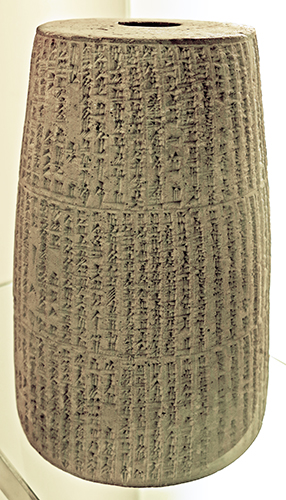
Nebuchadnezzar II's building deed for the renovation of the temple of the city god of Marad in the form of a truncated cone, ca 620 BC.
Since ancient times, the laying of the foundation stone has been part of the construction of a building. Today it usually takes the form of a ceremonial act in which capsules containing evidence of the present are laid in the foundation.
The laying of foundations can be traced back to ancient Egypt, the classical Mediterranean world and the ancient Orient, as well as to the Old Testament tradition. However, they were religiously based and much more elaborate than today. In Mesopotamia, this tradition began in the middle of the 3rd millennium BC and continued well into the 1st millennium BC.
The construction as well as the frequent renovation, repair or extension of palaces, temples, city walls and gates, which in Mesopotamia were always built of mud bricks that were not very durable, were among the most important tasks. The ruler was not only the builder, but also the one who ceremonially laid the first brick.
According to the myth of the creation of the world, the gods themselves built their residences and instructed the king in dreams to build. Once the site had been determined, it was a matter of carefully purifying it ritualistically. The blood of animals, honey, milk, wine, beer and oil had to be brought into the foundation trenches as offerings. In addition, cult personnel such as exorcists, lament singers, musicians and soothsayers had to be called in.
In contrast, nothing has come down to us about master builders and architects. If a renovation was to be carried out or if the ground plan was to be changed or the building moved, the approval of the gods had to be obtained. Above all, however, the inscriptions inserted into the building by predecessors had to be recovered, read and acted upon according to the instructions contained therein.
Photo: Don Hitchcock 2015
Source: Pergamon Museum, Berlin, recherche.smb.museum
The hollow truncated cone presented here, made as a body on the potter's wheel, is an outstanding example of such a foundation inscription. It was donated to the collection of the Museum of the Ancient Near East in 1890; its exact origin is therefore not certain.
But the inscription itself provides information about the place where it was found. According to the inscription, the object comes from the ancient city of Marad, a place about 70 km southeast of Babylon that can be traced back to the 3rd millennium BC. The existence of Marad has so far only been shown by such inscriptions. Here was the sanctuary of Lugal - Marada, the city god, who appears in cuneiform texts as a sword god and in his essence as a warlike underworld god. The text is written in cuneiform, that since the 2nd half of the 4th millennium BC.
In this case, it is a literary work in Akkadian, the oldest verifiable north-eastern Semitic language, whose two main dialects were Babylonian and Assyrian. The writing technique is the same as on thousands of clay tablets: the characters composed of individual wedge elements were written in the moist clay with a reed pen.
The text is divided into three columns of 45 to 50 lines each and shows the calligraphic effort to adapt the different character density of the lines to the given column width. The cone was then fired.
According to the inscription, the builder was Nebuchadnezzar II (605 BC - 562 BC), King of Babylon, who had the dilapidated sanctuary of Lugal-Marada in Marad renovated, about which he reports in this document:
At that time for Lugal-Marada, my lord, his temple in the midst of Marad - his founding document, which no one had seen since far away, I searched in its foundation and looked at it.
Over the foundation deed of Naram-Sîn, the king, my ancestor, I founded his foundation [anew.] A deed of my name I made and placed in it.
According to this, the temple had existed since the 23rd century BC, When the ancient kingdom of Akkadian was ruled by King Naram-Sîn (2272-2219 B.C.). Nebuchadnezzar II took the renewal of the building as an opportunity to now, in turn, place a foundation charter in the foundation. Apart from the quoted passage, the inscription is essentially identical to other comparable charters of the king. It is a literary building report which, after the introduction and titulature of Nebuchadnezzar, mentions his vocation as preserver of the cities and renewer of the temples and reports on his work on the buildings of Babylon and Borsippa.
The end of the inscription again follows literary patterns through the use of blessings and curses: 'O Lugal - Marada, Lord of all, you hero, look kindly on the work of my hands [...] Smash the adversaries, break their weapons, destroy the entire land of the enemies, overwhelm them insects! [...] Before Marduk, king of heaven and earth, make my deeds welcome, speak in my favour!'
Text: all of the text above referring to the building deed is by Prof. Dr. Joachim Marzahn, head curator at the Museum of the Ancient Near East.
Source: https://www.museumsportal-berlin.de/pl/magazin/blickfange/ein-grundstein-aus-der-zeit-nebukadnezars/
Map of the World
Circa 600 BC - 500 BC.
This clay tablet represents a map of the world. It shows the world as a disc, surrounded by a ring of water called the 'Bitter River'. 'Babylon' is marked as a rectangle at the right end of the Euphrates although the city actually occupied both banks of the river during most of its history. The river Euphrates flows south to a horizontal band, of which the right end is marked 'marsh' and the left end is marked 'outflow', thus the marshes at the head of the Gulf and either the Shatt al-Arab or where the river meets the cosmic 'Bitter River'.
To the right of the 'marsh' is a double curving line with a broken and unintelligible inscription. Small circles are used to indicate cities or districts, and two of which are identified as 'Assyria' and 'Der'. Three other geographical areas are marked, namely Bit-Yakin, the territory of an Aramaean tribal group around the southern Euphrates, is placed above its 'outflow'. Habban, the homeland of a Kassite tribal group around Kermanshah in western Iran, is placed quite wrongly to the west of Babylon. Urartu, an independent kingdom around the modern borders of Iran, Turkey and Russia, is placed relatively correctly to the north of Assyria.
Beyond the circular 'Bitter River' are placed the eight outlying regions (nagu). These are each marked, na-gu-u, and beside each is written the note '6 (or 7) beru (twelve or forteen hours in between' The beru is a Babylonian unit of time and linear measurement.
Danna (Sumerian) or Beru (Akkadian) is a word denoting a unit of time consisting of two hours. There were twelve Danna or Beru in a day. Danna were first used around 2 400 BC.
In addition, beside the north-eastern 'region' is written 'Where Shamash is not seen'. This reflects the fact that the sun rises in the east, crosses the heavens, sets in the west, and then returns to the east (as the Babylonians thought) through the underworld or the underworld waters, never passing through the northern (or southern) regions of the world or underworld.
On the reverse of this tablet these eight 'regions' are described in eight broken and largely unintelligible paragraphs, each beginning 'To the first (second, etc) region to which you go (the distance is) seven beru'. This, like the notes on the map, seems to indicate the distance between the different 'regions' around the edge of the world. It is not clear why the map twice gives the distance as six beru while the text, so far as preserved, consistently gives seven beru.
A final paragraph summarises, 'In all eight 'regions' of the four shores (kibrati) of the ea[rth ...], their interior no-one knows'. The 'four shores' (corresponding to the four quarters of the compass) is a regular Mesopotamian expression for the entire inhabited world.
The word nagu, which in historical and geographical texts simply means 'region', seems to have a special cosmic or mythological significance on this tablet and in the Flood story of the Epic of Gilgamesh (Tablet 11). There, as the flood waters subsided, Ut-Napishtim, the Babylonian Noah, 'looked about for the shores (kibrati), the boundaries of the sea. In each of twelve (directions) there emerged a nagu'. This and the triangular shape of the nagu on the map lead to the idea that the nagu may have been imagined as mountains.
The text at the beginning of the obverse of the tablet appears to be a description of the inhabitants, divine, human, animal or monstrous, of the areas beyond the earth, whether the eight 'regions' or the 'Bitter River' or maybe the underworld or underworld waters. Two or three lines may be missing at the beginning.
'... ruined cities ...
... whom Marduk watches ...
... the ruined gods who ... in the midst of the sea
... serpent, great dragon, between Anzu, scorpion-man
... mountain-goat, gazelle, zebu, leopard, bison
... lion, wolf, stag and hyaena
... the animal which Marduk created upon the rolling sea
... Ut-Napishtim, Sargon and Nur-Dagan king of
... their interior no-one knows'.
In the Epic of Gilgamesh (Tablet 10) the hero Gilgamesh goes to visit Ut-Napishtim in a land beyond the sea and beyond the Waters of Death. This suggests that the whole of this text is concerned with the inhabitants of the outer regions. The clause at the end of the text, 'their interior no-one knows' also ends the descriptions of the 'regions' on the reverse of the tablet.
Sargon, king of Akkad (ca 2 334 - 2 279 BC), established a short-lived empire spreading far to the north and west of the normal limits of Babylonia and became the subject of several legendary tales. One of these concerns a campaign against Nur-Dagan, king of Purush-handa (a city in central Turkey). As heroes of legend these two may well have been imagined as inhabiting a 'region' with Ut-Napishtim.
The 'ruined' gods are gods whose statues have become dilapidated and are in need of repair. The gods themselves were thought to have gone down to the underworld (via the Waters of Death), and the broken clause, 'who ... in the midst of the sea', probably refers to this underworld abode. The reference to 'ruined cities' may be to the gods of these cities.
In the Epic of Creation the serpent, great dragon, scorpion-man and bison are among the monsters created by Tiamat ('Sea') to do battle with the god Marduk. Anzu, the lion-headed bird, is the opponent of the god Ninurta in another Babylonian epic, and in other contexts is listed with Tiamat's monsters. All of these monsters may have been imagined as inhabiting the underworld or underworld waters.
The Babylonian author Berossus also recounts a story of strange monsters, some half-human, being created in the primeval waters before the creation of the world and being ruled over by Tiamat. The zebu or humped bull (apsasu) is referred to in Sumerian texts of about 2 000 BC. Later the name seems to be applied to a mythical monster, perhaps a sphinx. The remaining animals in the list would have been known to the Babylonians in the 1st millennium BC but would probably have been regarded as wild, strange or exotic. So they would have been suitable inhabitants of the outer 'regions'. The sea-animal created by Marduk is perhaps a whale.
The hole at the centre of the tablet is a so-called 'firing hole', deliberately made by the scribe. Similar holes appear in the middle of the text above the map and at two points on the reverse. The function of the so-called ‘firing hole' is unclear. Generally, it is considered that a ‘firing hole' had nothing to do with the baking of a tablet. However, ‘firing holes' certainly helped a tablet to dry out faster and more evenly.
Excavated by Hormuzd Rassam at Abu Habba, Sippar.
Height 122 mm, width 82 mm.
Inscription language: Akkadian, written in cuneiform.
A note at the end of the tablet states that it was copied from an earlier document but the inclusion of Assyria, Bit-Yakin, Habban and Urartu indicates that it was composed no earlier than the 9th century BC, circa 900 - 800 BC
Catalog: Clay tablet, 92687
Photo and text: www.britishmuseum.org, © Trustees of the British Museum, CC BY-NC-SA 4.0
Additional text: cdli.mpiwg-berlin.mpg.de/articles/cdln/2016-1
A close-up view of the Babylonian map of the World. This partially broken clay tablet contains both cuneiform inscriptions and a unique map of the Mesopotamian world. Probably from Sippar, Mesopotamia, Iraq.
700 BC - 500 BC.
Photo: Osama Shukir Muhammed Amin FRCP(Glasg) 2014
Source: The British Museum
Clay cylinder building deed.
The Akkadian cuneiform text mentions the name of the last great Assyrian king Assurbanipal, 668 - 626 BC, whose elder brother Shamash-shum-ukin became king of Babylon, and also mentions one of the double walls of Babylon, Nemet-Enlil, which had a total length of eight kilometres, and was further protected by a fifty metre wide moat, connected at both ends to the Euphrates.
Photo: Don Hitchcock 2015
Source and text: Pergamon Museum, Berlin, recherche.smb.museum
Additional text: Wikipedia
Small amphora for cosmetics or fragrance oil.
6th - 5th century BC.
Height 69 mm, diameter 44 mm, diameter opening and edge 25 mm, diameter opening 9 mm.
Catalog: Glass, Babylon, VA Bab 03073
Photo: Don Hitchcock 2015
Source and text: Pergamon Museum, Berlin, http://www.smb-digital.de/
God Seal
Engraved cylinder seal.
Dated to Esarhaddon (680 BC – 669 BC)
Height 125 mm, diameter 32 mm, weight 300 gm.
Catalog: Lapis Lazuli, VA Bab 00647
Photo: Don Hitchcock 2015
Source and text: Pergamon Museum, Berlin, recherche.smb.museum
God Seal
Engraved cylinder seal.
Dated to Esarhaddon (680 BC – 669 BC)
This massive lapis lazuli cylinder was found together with beads, scarabs and precious ornaments mixed up with raw material, carefully hidden by the last owner, probably a Parthian manufacturer of beads, beneath the floor of his house.
The storm god Adad, standing on a stylized pedestal, is shown with bolts of lightning in his hands, a lion-dragon on a leash lying at his feet. His garment is decorated with the image of a ziggurat and three star-discs one below the other, which are depicting gold or silver pendants.
The initial Neo-Babylonian inscription, 'Seal of the god Adad', was supplemented at first by the addition 'Property of the god Marduk … of Esangila'.
The second Assyrian dedication 'To the god Marduk, great lord, his lord, Esarhaddon, king of the universe, king of Assyria, has given [the seal] for his life' suggests that the seal was at one point misappropriated from the treasury of Esangila and that it was Esarhaddon (680-669 B.C.) who reversed the sacrilege.
The technique - positive carved inscriptions, raised relief - substantiates that the cylinder was never used for sealing, although very few impressions of god's seals are known. [Nadja Cholidis]
Height 125 mm, diameter 32 mm, weight 300 gm.
Catalog: Lapis Lazuli, VA Bab 00647
Photo credit: Staatliche Museen zu Berlin, Vorderasiatisches Museum / Olaf M. Teßmer CC BY-NC-SA 4.0
Source and text: Pergamon Museum, Berlin, recherche.smb.museum
Family Crypt
During excavations at Ashur, a sounding below a Middle Assyrian house uncovered a family crypt of the 13th Century BC where ten persons were interred. Numerous pieces of burial equipment (cylinder seals, jewellery made of gold and semi-precious stones, ivory objects, pottey and alabaster vessels) were associated with the last two skeletons in the crypt.
Alabaster vessels from the family crypt referred to above.
Photo: Don Hitchcock 2015
Source and text: Pergamon Museum, Berlin, recherche.smb.museum
Lapis lazuli and gold sections of a plate necklace
Assur, 1 400 BC - 1 200 BC.
Length 275 mm
From the family crypt referred to above.
In 1908, German excavators discovered an untouched brick crypt with the remains of several burials and exceptionally rich grave goods in a search trench. The additions include pottery, various alabaster vessels and various ivory objects.
The jewellery items in particular testify to the high social status of the two deceased, to whom the body jewellery could be attributed as the last to be buried. In addition to some jewellery ensembles arranged randomly into headdresses and necklaces, the function of the eleven square plates made of gold and lapis lazuli is confirmed by their location as part of a necklace.
The individual elements made of semi-precious stone and gold are largely uniform in their basic shape and the longitudinal structure of the surface. The effect of the collar comes primarily from the colour change and the alternating smooth and delicately perforated surfaces.
The five golden decorative links provide insights into the goldsmith's technique: perforated half-cylinders are soldered onto a base surface, with the openings being emphasised with a turned-up edge and folded-over granulation.
It is not certain that the two stone pendants in the shape of humpback calves with gold loops belong to the plate collar. [Ralf B. Wartke]
Catalog: VA Ass 01008
Permalink: id.smb.museum/object/1744294/lapisschieber-eines-plattenhalsbands
Photo: Don Hitchcock 2015
Source and text: Pergamon Museum, Berlin, recherche.smb.museum
Multi-link necklace
From the family crypt referred to above.
Carnelian, lapis lazuli and obsidian beads have been used, as well as onyx beads cut and polished to resemble eyes, and surrounded by gold.
This necklace is attested by the museum card as being from the same crypt as the necklace above, and the same fluted blue lapis lazuli square beads in each necklace are further confirmation of this.
( This item appears not to be in the online catalog - Don )
Photo: Don Hitchcock 2015
Source: Pergamon Museum, Berlin
Jewellery
From the family crypt referred to above.
Photo: Don Hitchcock 2015
Source: Pergamon Museum, Berlin
The associated text for these crypts reads:
Assyrian Crypts
There were different burial rituals in the old Near East, which depended on the respective epoch and the specific region as well as on the rank and wealth of the deceased and his family.
In Assur a number of crypts were excavated under residential buildings of the living. The replicas of two examples are in this museum, containing some of the original finds.
The right crypt was formed by a radial layer vault and contained a number of burials with a substantial time interval between them. In addition to the original vessels on display here, the burials were rich in jewellery and cosmetics (see display in room 12, showcase 40). The crypt was in use during the second half of the second century BC. The left crypt has a pointed arch vault and was dated back to ~ 900 BC.
The deceased were thought to live on in the underworld and the grave goods and offerings were attributed to them. In case of failure the ghosts of the deceased were feared because they could still harm the living.
See for example Irving Finkel's presentation The First Ghosts: www.youtube.com/watch?v=sVsA2ySbhIg
Text and translation by courtesy of Michael Hess
Photo: Don Hitchcock 2015
Source: Pergamon Museum, Berlin, recherche.smb.museum
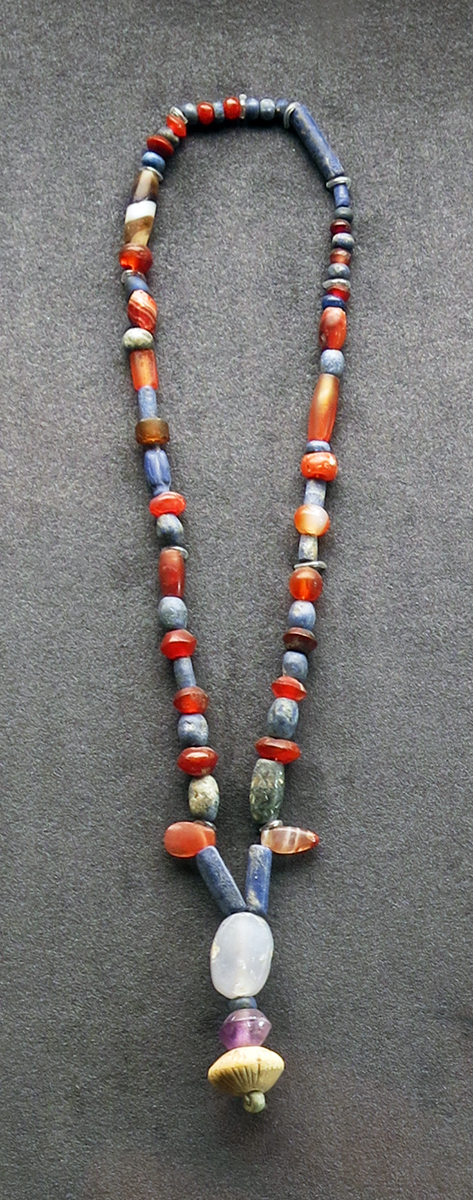
Necklace made of various semi-precious stones
Assur, 1 000 BC - 612 BC.
Stones include carnelian, agate, lapis, turquoise, and amethyst.
Length 390 mm, weight 30 gm.
Catalog: Assur, Qal'at Scherqat, find quadrant d B 6 III, Crypt 069, VA Ass 05975
Permalink: id.smb.museum/object/1744738/kette-aus-diversen-halbedelsteinen
Photo: Don Hitchcock 2015
Source and text: Pergamon Museum, Berlin, recherche.smb.museum

Necklace made of various semi-precious stones, probably from Assur
( This necklace is similar to the one above, was beside it in the vitrine display, and may be from the same place and even find quadrant, but I can find no record of it in the online catalog. It has a high proportion of carnelian beads, as well as a few beads made of agate - Don )
Photo: Don Hitchcock 2015
Source: Pergamon Museum, Berlin, recherche.smb.museum
Necklaces made of various semi-precious stones, and gold earrings
( None of these items appear to be in the online catalog, and appear to be from different sub-cultures, though I think that they are from Assur - Don )
Photo: Don Hitchcock 2015
Source: Pergamon Museum, Berlin, recherche.smb.museum
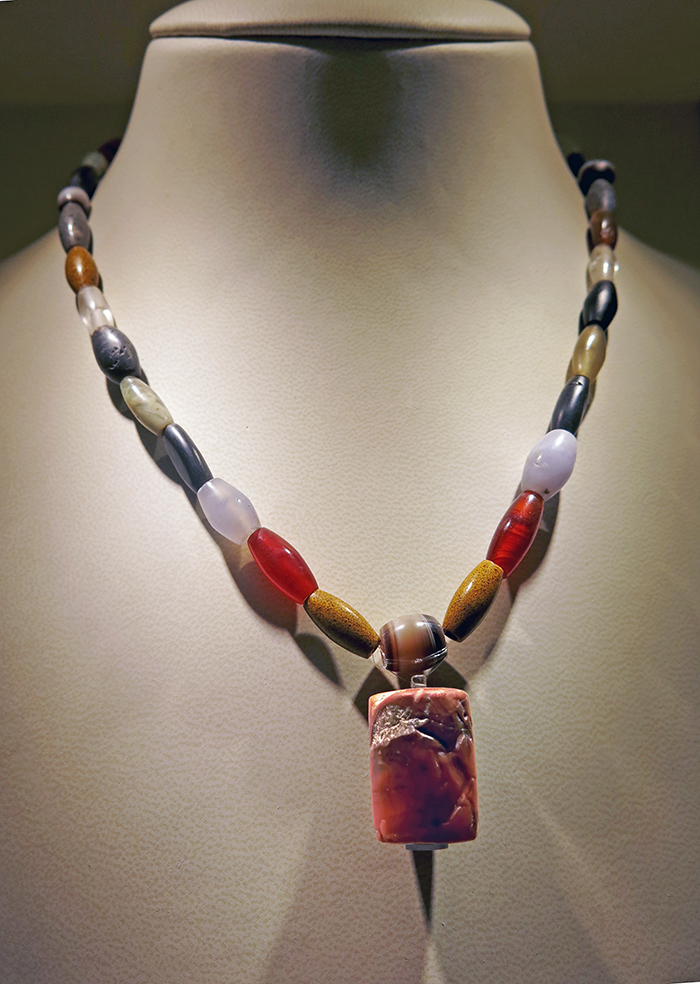
Necklace made of 38 different gemstones.
Cylinder seals are of great importance in business and administration for notarising processes and identifying property. In addition, a seal also represents a valuable amulet and piece of jewellery for its owner, to which positive, apotropaic properties (the power to avert evil influences or bad luck) were attributed due to the material or colour used.
It offered its owner divine protection against diseases and other everyday dangers through mythical representations, magical symbols and inscriptions such as prayers. The valuable coloured stones also made seals attractive pieces of jewellery, which were also attached to necklaces, for example (bust left). The seal could be worn on the robe in combination with a pin (bust on the right).
Necklace made of 38 different gemstones
Stones: agate and carnelian, Crystal, Granite.
7th century BC, Neo-Babylonian
Length 45 cm, weight 24.8 gm, weight with seal 33.6 gm.
Catalog: Necklace, Babylon, VA Bab 01486.01
Catalog: Cylinder seal VA 529, chalcedony, 6th/5th century BC
Photo: Don Hitchcock 2015
Source and text: Pergamon Museum, Berlin, recherche.smb.museum
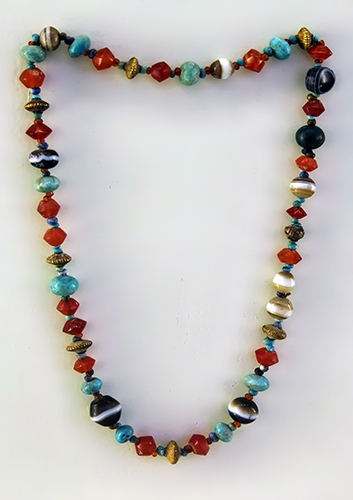
Neo-Babylonian, first half of the 1st millennium BC
Necklace made of semi-precious stones, gold, Babylon.
Diameter 15 cm.
Thickness 7 mm.
Weight 30 gm.
Catalog: Semi-precious stones, gold, VA Bab 02550
Photo: Don Hitchcock 2015
Source and text: Pergamon Museum, Berlin, http://www.smb-digital.de/
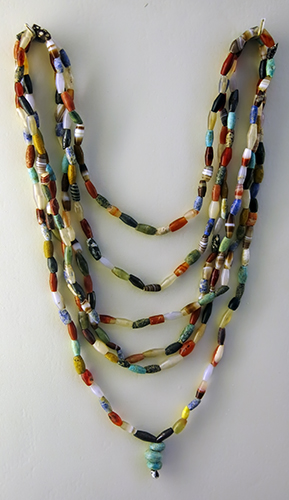
Necklace made of gemstones (grave goods), Babylon, 1st half of the 1st millennium BC.
Length 70 cm, weight 67 gm.
Catalog: Semi-precious stones, Merkes, from a stool coffin (Grave 124),
quadrant 25 n 2, 4.24m, VA Bab 01487
Photo: Don Hitchcock 2015
Source and text: Pergamon Museum, Berlin, http://www.smb-digital.de/

Necklace made of gemstones (grave goods), Babylon, 1st half of the 1st millennium BC.
Length 70 cm, weight 67 gm.
Catalog: Semi-precious stones, Merkes, from a stool coffin (Grave 124),
quadrant 25 n 2, 4.24m, VA Bab 01487
Photo: Don Hitchcock 2015
Source and text: Pergamon Museum, Berlin, http://www.smb-digital.de/
Assur and Babylon
Assur, or Ashur, whose modern site name is Qala'at Sherqat, is situated on the West Bank of the Tigris in Northern Iraq. The site already began to attract the interest of archaeologists during the middle of the 19th century.In 1903 the Royal Museums of Berlin and the Deutsche Orient-Gesellschaft began to carry out systematic excavations under the direction of Walter Andrae which were continued until 1914. Research in this area is still being carried out today. At the side of the Archaic Ishtar Temples, urban development was traced back as early as the first half of the third millenium BC. During the excavations, a number of representative religious and palace buildings from various periods were unearthed.
The Old Palace of the Assyrian ruler Shamshi-Adad I and important parts of the temple of the city and state god Ashur date to the first half of the second millenium BC. In between these two buildings, the ruins of the Ziggurat are located. They are still 30 metres high and clearly visible from a distance. The Ziggurat was originally consecrated to the god Enlil, but later on dedicated to Ashur.
A twin sanctuary belonging to the moon god Sin and the sun god Shamash dates back to the 15th century BC. The extension of the city as a residence reached its peak during the reigns of the Middle Assyrian kings Tukulti-Ninurta I (1244 BC - 1208 BC) and Tiglath-pileser I (1115 BC - 1077 BC). During this period a temple was built, dedicated to the goddess Ishtar, and another royal palace as well as the Anu-Adad Temple were erected.
From the 9th century onwards, Ashur began to loose its importance as the political capital of the Assyrian Empire. But its religious significance remained high and great efforts were taken by the Neo-Assyrian kings to preserve, restore, and build new temples, like the Nabu Temple. After the destruction of Ashur by the Medes in 614 BC, the city flourished once again during the Parthian period (2nd century BC - 3rd century AD). A palace was built in the southern sector of the city, one of its facades is reconstructed here opposite the Babylonian Ishtar Gate.
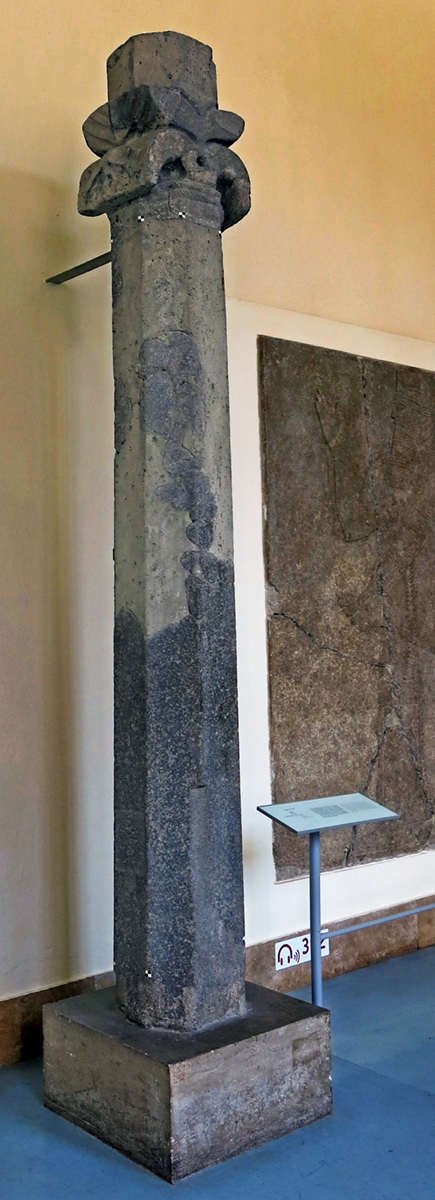
Among the row of Stelae at Assur, a number of columns and column fragments which apparently had been brought to the city as part of an important booty were discovered.
The inscription on the original basalt column with leaf capital reads:
'Monument of Shamshi-Adad, king of Assyria, son of Tiglath-pileser, king of Assyria'.
(
This apparently refers to Shamshi-Adad IV, who reigned circa 1051 BC - 1048 BC, and was probably fairly elderly by the time he seized the throne from his brother.
Note that accepted spelling is just as problematical and diverse for cuneiform as it is for hieroglyphics, as Tiglath-pileser is also rendered as Tukultī-apil-Ešarra - Don )
Photo: Don Hitchcock 2015
Source and text: Pergamon Museum, Berlin, http://www.smb-digital.de/
Votive offerings, partly with dedication inscriptions, first half of the 1st millennium BC.
At left foreground, a shallow bowl of mollusk shell, 1st millennium BC.
Height 18 mm, width 63 mm, length 43 mm, weight 60 gm.
This flat shell made of mother-of-pearl is rectangular in shape and has a stepped extension on each of the narrow, opposite sides as a small handle. Numerous rings arranged in two rows on the edge are scratched into the top.
Catalog for shallow bowl: Tell Amran ibn Ali, VA Bab 04795
Catalog for cylinders: Chalcedony, lapis lazuli, 'Egyptian blue', Babylon
Photo: Don Hitchcock 2015
Source and text: Pergamon Museum, Berlin, http://www.smb-digital.de/
Because Mesopotamia lacked most raw materials, objects made of anything other than clay or pottery were highly valued, whether they were put to daily use of intended as burial equipment.
Luxury goods were prized not only on account of the materials from which they were made (e.g. gold and silver, semiprecious stones and man-made media such as glass). The function of objects (like the gaming board of rock crystal) and the craftmanship evident in design and workmanship also contributed to their value.
When it came to votive gifts for the gods (sceptres, mace heads, onyx 'eyes', cylinders of lapis lazuli) the symbolism inherent in the object was enhanced by the value of the material from which it is made.
Text above: Card, Pergamon Museum, Berlin
Onyx sceptre or spindle from Babylon.
6th century BC
Length 389 mm, diameter 45 mm (max.)
Weight: calculated 400 gm.
Catalog: VA Bab 01625
Photo: Don Hitchcock 2015
Source and text: Pergamon Museum, Berlin, http://www.smb-digital.de/
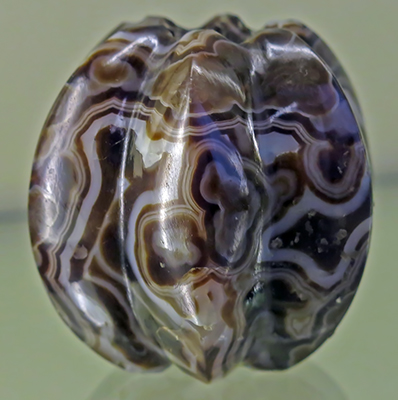
Onyx mace head from Babylon, 6th century BC
Height 57 mm, diameter 55 mm, weight 170 gm.
Catalog: Onyx, the Omran mound, Tell Amran ibn Ali, VA Bab 01625
Photo: Don Hitchcock 2015
Source and text: Pergamon Museum, Berlin, http://www.smb-digital.de/
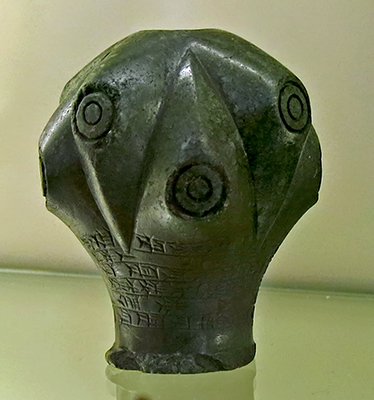
Serpentine club head with the inscription of Prince Ulaburariasch, 2nd half of the 16th century BC.
Height 63 mm, diameter 63 mm, height 72 mm, weight 330 gm.
The club head, to be mounted on a shaft, was found near the Marduk temple Esagila. It was one of the stone materials kept in baskets, including God's seals and the remains of a scepter. This context of finds from the Nebuchadnezzar period (6th century BC) could point to the remains of a temple treasure.
This interpretation is possibly supported by the inscription on the piece, according to which the founder was Ulaburariasch, a prince from the Kassite dynasty, later 'King of the Sealands'.
The knowledge of the age of this offering as well as the observance of the curse formula used here for the removal of the name should have been one reason for the storage of this magnificent weapon for a period of almost a thousand years. The admiration for the careful stone-cutting work certainly contributed to this.
Catalog: Serpentine, Babylon, VA Bab 00645
Photo: Don Hitchcock 2015
Source and text: Pergamon Museum, Berlin, http://www.smb-digital.de/
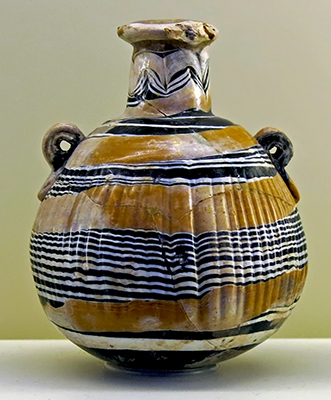
Glass bottle from Babylon, 8th/7th century BC.
Height 87 mm, diameter 68 mm, weight 134 gm.
Catalog: Glass, VA 08449
Photo: Don Hitchcock 2015
Source and text: Pergamon Museum, Berlin, http://www.smb-digital.de/

Miniature vessel from Babylon, 1st millennium BC.
Height 77 mm, diameter 55 mm, weight 90 gm.
Catalog: Stone, VA Bab 04432
Photo: Don Hitchcock 2015
Source and text: Pergamon Museum, Berlin, http://www.smb-digital.de/
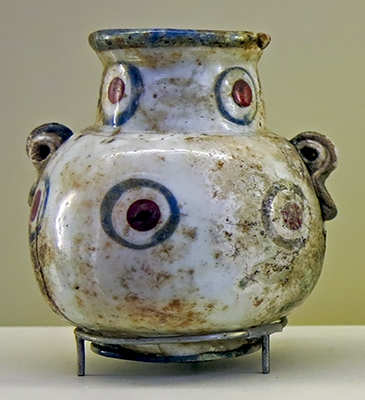
Miniature vessel from Babylon, 6th century BC.
Height 68 mm, diameter 60 mm, weight 100 gm.
Catalog: Glazed ceramic, Merkes, from an oval sarcophagus, VA 08452
Photo: Don Hitchcock 2015
Source and text: Pergamon Museum, Berlin, http://www.smb-digital.de/
Objects of everyday life, Babylon.
Decorated comb, needles, spindle whorls, pins.
Ivory, bone, glass.
1st millennium B.C.
Photo: Don Hitchcock 2015
Source and text: Pergamon Museum, Berlin, http://www.smb-digital.de/
Jewellery, all from Babylon.
____________
Left: Gold bangles.
Both have a thickness of 12 mm and a diameter of 55 mm.
Circa 10th century BC.
Catalog: VA Bab 02542.01, VA Bab 02549.2
____________
Centre ring of the three rings: Gold boat-shaped earring.
1st half of the 1st millennium BC.
Height 18 mm, width 16 mm, thickness 5 mm.
Catalog: Merkes, 26 o 1, + 2.50m (grave) VA Bab 02542.01
____________
Right ring of the three rings: Gold earring with a pomegranate pendant.
1st half of the 1st millennium BC.
Height 23 mm, width 13 mm, thickness 2 mm.
Spherical pendant (ball shaped with extra small circlet)
Catalog: VA Bab 02398
____________
Small spherical pendant just above the hollow gold beads.
1st half of 1st millennium BC Chr.
Diameter 8 mm.
Catalog: Merkes, 27 n 1, + 8.00m, VA Bab 02403
____________
Photo: Don Hitchcock 2015
Source and text: Pergamon Museum, Berlin, http://www.smb-digital.de/
____________
Left:
Necklace made of semi-precious stones (grave goods), Babylon, 13th - 12th century BC.
Period: Kassite
Length 46 cm (chain closed), diameter 1 cm (widest part)
Catalog: Merkes, Crypt 32 , quadrant 26 f 1, +1.95m, VA Bab 01377.01
____________
Centre:
Necklace of semi-precious stones with turquoise pendant (grave goods), Babylon, 13th-12th century BC.
Period: Kassite
Length 61 cm (chain closed), diameter 8 mm (widest part)
Catalog: Merkes, Crypt 32 , quadrant 26 f 1, +1.95m,VA Bab 01377.02
____________
Right:
Necklace made of semi-precious stones and gold(?) (grave goods) Babylon, 13th-12th century.
Period: Kassite
Length 35 cm
Catalog: Semi-precious stones and gold, Merkes, Crypt 32 , quadrant 26 f 1, +1.95m, VA Bab 01377.03
____________
The Kassites were people of the ancient Near East, who controlled Babylonia after the fall of the Old Babylonian Empire circa 1 595 BC and until circa 1 155 BC (middle chronology).
They gained control of Babylonia after the Hittite sack of the city in 1 595 BC (i.e. 1 531 BC per the short chronology), and established a dynasty based first in Babylon and later in Dur-Kurigalzu.
The Kassites were members of a small military aristocracy but were efficient rulers and locally popular, and their 500-year reign laid an essential groundwork for the development of subsequent Babylonian culture. The chariot and the horse, which the Kassites worshipped, first came into use in Babylonia at this time.
____________
Photo: Don Hitchcock 2015
Source and text: Pergamon Museum, Berlin, http://www.smb-digital.de/
Additional text: Wikipedia
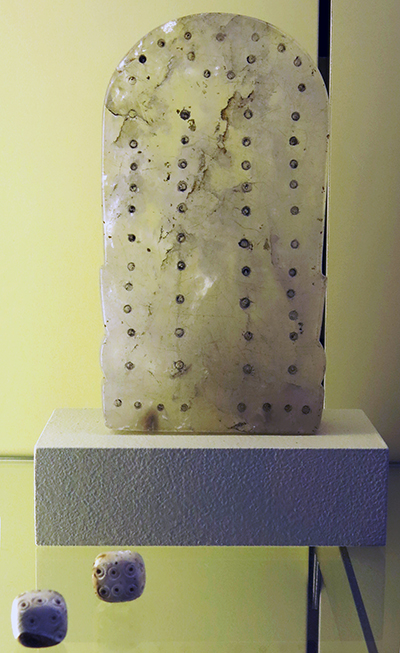
Game board and dice made of rock crystal and glass.
First half of the first millennium BC.
Game board of rock crystal.
Height 146 mm, width 80 mm, thickness 27 mm, weight 870 gm.
Catalog: Tell Amran ibn Ali (so-called treasure find), VA Bab 00665
_________________
Two glass dice, first half of the 1st millennium BC.
Dimensions 17 mm x 17 mm x 17 mm.
Weight 70 gm.
Catalog: Merkes, 27 m 2, +9.50m, VA 07577
Photo: Don Hitchcock 2015
Source and text: Pergamon Museum, Berlin, http://www.smb-digital.de/
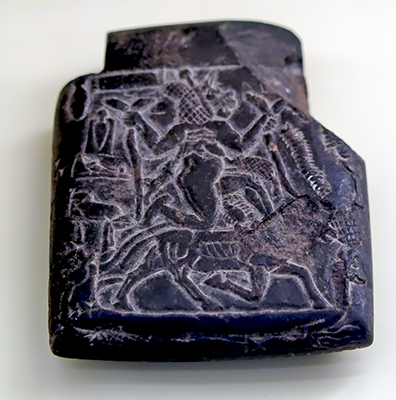
Babylonian Amulet against the demoness Lamashtu.
In Mesopotamian mythology, Lamashtu was a female demon, monster, malevolent goddess or demigoddess who menaced women during childbirth and, if possible, kidnapped their children while they were breastfeeding. She would gnaw on their bones and suck their blood, as well as being charged with a number of other evil deeds. She was a daughter of the Sky God Anu.
Lamashtu is depicted as a mythological hybrid, with a hairy body, a lioness' head with donkey's teeth and ears, long fingers and fingernails, and the feet of a bird with sharp talons. She is often shown standing or kneeling on a donkey, nursing a pig and a dog, and holding snakes. She thus bears some functions and resemblance to the demon Lilith in Jewish mythology.
Limestone, height 69 mm, width 54 mm, depth 20 mm, weight 110 gm.
Collection: Museum of the Ancient Near East
First half of the 1st millennium BC.
Catalog: VA 03477
Photo: Don Hitchcock 2015
Source and text: Pergamon Museum, Berlin, http://www.smb-digital.de/
Additional text: Wikipedia
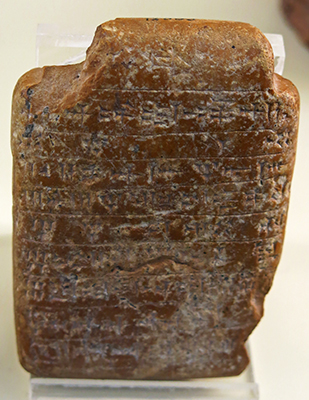
Babylonian Amulet to protect young mothers and babies from dangers and diseases associated with the demon Lamashtu.
First half of the first millennium BC.
Limestone, height 95 mm, width 68 mm, thickness 25 mm, weight 280 gm.
Catalog: VA 06959
Photo: Don Hitchcock 2015
Source and text: Pergamon Museum, Berlin, http://www.smb-digital.de/
Clay bowls with Aramaic incantations against demons spreading diseases or other evils in the house, one of them quoting the Hebraic confessional text 'Shema Yisrael', 4th to 7th century AD.
The text of the incantation bowls was written in Jewish Babylonian Aramaic.
Text below: Dan Levene, Jewish Aramaic Incantation Bowls, jnjr.div.ed.ac.uk/primary-sources/biblical/jewish-aramaic-incantation-bowls/
Aramaic incantation bowls, also known as magic bowls, are types of amulets that consists of an incantation written on common domestic earthenware. This kind of object is particular to the Sasanian period (3rd – 7th Century CE), is distinctively Mesopotamian, and is found in central and southern regions of what is known today as modern Iraq. The evidence suggests that this type of amulet stopped being made during the early period of the Islamic conquest.Photo: Don Hitchcock 2015
Incantation bowls were used by the various Aramaic speaking communities that lived in late antique Sasanian Mesopotamia. Consequently, they offer insights into aspects of cultural collaboration, interchange, and overlap that are largely absent in other sources that are available from this period, like the Babylonian Talmud, the writings of Mani, and Zoroastrian literature, which have more commonly been studied in relation to the particular communities, by disciplines that evolved to deal with their respective languages and religious philosophies.
A parallel body of magical amulets, though much smaller in number, that were produced by the Jews that lived within the Roman sphere of influence, in Palestine and the eastern Mediterranean basin, exists in the form of incantations inscribed on thin sheets of silver, or very occasionally copper alloy. The fact that the magical products of these two communities that lived under the influence of the two rival political and cultural forces of that age are different, is of great significance, and is an aid to the study of the differences and tensions that existed between these two distinct Jewish communities.
There are known to exist at least 2000 bowls in both museums and private collections, of which less than 25% have been published. The great majority is written in Aramaic dialects, a hand-full in Pahlavi, and there are two in Arabic. There are also a significant number of texts that are written in pseudo-scripts. The types of Aramaic represented in order of prevalence are: Aramaic square script (about 60%), Mandaic script (just under 25%), and Syriac scripts (under 15%). The square script is generally considered to be Jewish, the Mandaean script belongs to the Mandaeans, and the Syriac to Manichaeans, other unidentified Gnostic and/or pagan groups, and, in a few cases, to Christians.
An interesting aspect of the incantation bowls is the way in which the text is laid out upon the surface of the bowls in different ways. The most common is the spiral, starting in the middle of the concave side of the bowl and working its way in a clockwise fashion to its outer edge. The skill displayed by these scribes is suggestive of those needed to produce manuscripts on more conventional types of material, such as parchment. However, the bowls are the only Aramaic manuscripts from the period that are known to have survived in the square, Mandaean, and Manichaean Syriac scripts.
The Aramaic incantation bowl texts are overwhelmingly apotropaic, and claim to protect their owners from a variety of misfortunes that include difficulty in child birth and rearing, illness, poverty as well as afflictions caused by supernatural and human foes. Aramaic incantation bowl texts contain adjurations of supernatural entities to curb other such entities that were considered in late antiquity to be the causes of adversity. The fact that this characterises bowls of all dialects and faith groups implies a world in which it was commonly believed that the supernatural plays an active part in human welfare, and that the interaction with it can be effective. The potency of such amulets was thought to have been determined by knowledge of words of power, such as those believed to have been spoken by the deity as part of the act of creation. Notions regarding the power of words can also be observed in the mystical literature of the period.
Source and text: Pergamon Museum, Berlin, http://www.smb-digital.de/
Additional text: Dan Levene, jnjr.div.ed.ac.uk/primary-sources/biblical/jewish-aramaic-incantation-bowls/
Darius I, 521 BC - 486 BC
Relief showing a royal bodyguard.
Susa, from the palace of Darius I.
Coarse-grained vitreous material with coloured glaze
Photo: Don Hitchcock 2015
Source and text: Pergamon Museum, Berlin,
Darius I, 521 BC - 486 BC
Close up of the three bodyguards.
Each carries a spear in both hands, with a bow slung across the left shoulder, but the large quivers do not show any arrow fletches. It may be that while travelling or performing ceremonial duties, others carried bundles of arrows should the necessity arise.
Palaces at Susa and Persepolis, the residential cities of the Achaemenid kings, are noteworthy
for their elaborate wall decoration which can be considered exemplary of art at
the royal court. The walls of Darius's palace at Susa were embellished with colourful reliefs
made of glazed bricks on the Babylonian model. It is not certain which room (or rooms)
of the palace with its audience hall (apadana) was decorated with representations of a
procession of royal bodyguards, dressed in their splendid costumes. (A reconstruction on
reduced scale beside the doorway to the next gallery gives visitors an impression of how
these figures were arranged in a long frieze.)
Photo: Don Hitchcock 2015
Source and text: Pergamon Museum, Berlin
Darius I, 521 BC - 486 BC
A single spearman and archer.
His bow is slung on the left shoulder, which seems to be standard procedure, and is partially obscured.
Photo and text: Don Hitchcock 2015
Source: Pergamon Museum, Berlin
Artaxerxes III, 425 BC - 338 BC
Servant with tray.
Height 450 mm, width 350 mm, depth 100 mm, weight 55 kg.
Catalog: Limestone relief, VA 00212
Photo: Don Hitchcock 2015
Source: Pergamon Museum, Berlin, www.smb-digital.de/
Permalink id.smb.museum/object/1744370/diener-mit-tablett
Two Thracian gift bringers, each with spear and shield, 600 BC - 400 BC
Height 590 mm, width 520 mm, depth 100 mm, weight 110 kg.
Catalog: Limestone relief, Persepolis, VA 02987
Photo: Don Hitchcock 2015
Source: Pergamon Museum, Berlin, www.smb-digital.de/
Permalink: id.smb.museum/object/1744368/zwei-thrakische-gabenbringer-mit-speer-und-schild
Bronze robe pins, Babylon, 600 BC - 400 BC
Photo: Don Hitchcock 2015
Source and text: Pergamon Museum, Berlin
Xerxes I, 485 BC - 465 BC
Tribute bringer. The clothing of the man carrying the lamb identifies him as a Mede.
Height 680 mm, width 320 mm, depth 100 mm, weight 80 kg.
Catalog: Limestone relief, Persepolis, VA 08799
Photo: Don Hitchcock 2015
Source: Pergamon Museum, Berlin, www.smb-digital.de/
Permalink: id.smb.museum/object/1744369/flachrelief-mit-tributbringer
Xerxes I, 485 BC - 465 BC
Plaster cast of a relief sculpture of the enthroned figure of Xerxes.
The king is sitting on a throne, holding a sceptre and a lotus flower. Behind the king stands an attendant and above them is a richly decorated canopy. The throne is supported by a huge platform with lion's paws and three rows of figures. The figures wear different costumes from across the Persian Empire.
The cast is made from the inside of a doorway at the Palace of Darius at Persepolis, Iran. Persepolis was a seat of Iranian Kings of Persia between 518 BC and 330 BC. Each scene shows a royal hero wearing a loose-fitting Persian robe, stabbing a monster.
Lorenzo Giuntini accompanied Herbert Weld to Persepolis in 1892 where he created the moulds. On his return to London he made this plaster cast.
Original from the One Hundred Column Hall, Fars (province) Southern Iran.
Catalog: C.225.14
Photo: Don Hitchcock 2015
Text: Card at the British Museum, www.britishmuseum.org/, © Trustees of the British Museum, CC BY-NC-SA 4.0
Map showing the position of Persepolis, Iran.
Rephotography: Don Hitchcock 2015
Source and text: poster at the British Museum, www.britishmuseum.org/, © Trustees of the British Museum, CC BY-NC-SA 4.0
Royal Hero, 490 BC - 470 BC
The cast is made from the inside of a doorway at the Palace of Darius at Persepolis, Iran. Persepolis was a seat of Iranian Kings of Persia between 518 BC and 330 BC. Each scene shows a royal hero wearing a loose-fitting Persian robe, stabbing a monster.
This design belongs to an ancient Middle Eastern tradition of combat scenes and may have symbolised the triumph of a king over his enemies. Their inclusion on doorways may have reinforced the feeling of protection given to the king and courtiers.
Lorenzo Giuntini accompanied Herbert Weld to Persepolis in 1892 where he created the moulds. On his return to London he made this plaster cast.
Catalog: ME225
Photo: Don Hitchcock 2015
Text: Card at the British Museum, www.britishmuseum.org/, © Trustees of the British Museum, CC BY-NC-SA 4.0
Pilgrim bottle, Parthian Period, 100 BC - 200 AD
Height 138 mm, width (belly) 115 mm, thickness 59 mm, weight 284 gm.
Catalog: Glazed ceramic, Assur (Qal'at Scherqat) Find quadrant i B 3 IV, in the well of the Assur Temple, VA Ass 04163 a
Permalink: id.smb.museum/object/1744476/pilgerflasche
Photo: Don Hitchcock 2015
Source and text: Pergamon Museum, Berlin, recherche.smb.museum
References
- Diamond J. , 2005: Guns, Germs and Steel, Norton & Company, New York, London, revised HB edition from the original of 1997.
- Fenollós J. et al., 2005: Etemenanki: nuova ipotesi di ricostruzione dello ziggurat di Nabucodonosor II nella cittá di Babilonia, (PDF). ISIMU: Revista sobre Oriente Próximo y Egipto en la antigüedad: 201–216.
-
Groman-Yaroslavski I. et al., 2016: Composite Sickles and Cereal Harvesting Methods at 23,000-Years-Old Ohalo II, Israel, PLOS ONE, November 23, 2016, doi.org/10.1371/journal.pone.0167151
- Hall H., 1930: A Season's Work at Ur, Al-'Ubaid, Abu Shahrain-Eridu-and Elsewhere Being an Unofficial Account of the British Museum Archaeological Mission to Babylonia, 1919, ISBN 9781138817838
- King L., 1919: A History of Babylon, from the Foundation of the Monarchy to the Persian Conquest, History of Babylonia vol. 2
- Koldewey R., 1914: The excavations at Babylon, Publisher London : Macmillan and Co.
- Seidl U., 1989: Die babylonischen Kudurru-Reliefs: Symbole mesopotamischer Gottheiten, Zurich Open Repository and Archive, University of Zurich Main Library
- van Ess M., Fassbinder J., 2019: Uruk-Warka, Archaeological Research 2016 – 2018, Preliminary Report, Sumer, Vol. LXV 2019
- Vucetich, J., Peterson R., 2012: The population biology of Isle Royale wolves and moose: an overview., isleroyalewolf.org/data/data/home.html
- Varoujan D. et al., 2020: Sea Level Changes in the Mesopotamian Plain and Limits of the Arabian Gulf: A Critical ReviewJournal of Earth Sciences and Geotechnical Engineering, Vol.10, No.4, 2020, 87-110ISSN: 1792-9040 (print version), 1792-9660 (online)Scientific Press International Limited
- Woolley C., 1934: Ur Excavations Volume II, The Royal Cemetery, British Museum and University of Pennsylvania
Woolley (1934)
Back to Don's Maps
 Back to Archaeological Sites
Back to Archaeological Sites
